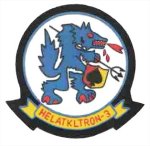President
Walter (Skip) Weiss, Jr
89 Capistrano Avenue
San Francisco, CA 94112
(415) 585-8513
Vice President
Secretary:
Richard Ogan
3770 Mulberry Street
Oceanside, CA 92058
(760) 994-4727
Membership
Chairman/Keeper of
the Roster
Jack Hammond
15011 55 Dr. SE
Everett, WA 98208
(425)-338-0959
Keeper of the TT
Photo Album
Georgia Hammond
15011 55 Dr. SE
Everett, WA 98208
(425)-338-0959
Ship's Storekeeper/Historian
Alan Lundy
929 Bellaire Avenue
Pittsburg, PA 15226
(412) 331-3324
Treasurer
Jesus (Pancho) Velasquez
20947 W. 124th St.
Olathe, KS 66061
(913) 829-9095
3-Year Trustee
Tom Hamlin
2 Cadet Drive
North Ridgeville, OH 44039
(440) 327-7123
2-Year Trustee
Alan Lundy
929 Bellaire Avenue
Pittsburg, PA 15226
(412) 331-3324
1-Year Trustee
Delbert Todd
5740 Gold Dust Dr.
Kellseyville, CA 95451-2866
Tortuga Association Web
Page Editor TT Webmaster
LSD-26
Kirk 'Hanz' Strickfaden
135 Valentine Dr.
Lynch Station, VA 24571
Webmaster LSD-46
CTT/2
Jason Farkas
Newsletter Editor
Jesus (Pancho) Velasquez
20947 W. 124th St.
Olathe, KS 66061
(913) 829-9095
The Comprehensive History of the USS Tortuga LSD 26
Compiled by Michael D. Wilson
MM2 1964-1968

A group of desert coral islets—60 miles west of Key West, Fla.—which were discovered in 1513 by Spanish explorer Ponce de Leon. In 1861, the United States government completed Fort Jefferson on Garden Key, and this bastion remained in Union hands throughout the Civil War. It later was used as a prison until abandoned in 1874. During the 1880's, the Navy established a base at Tortuga; and it subsequently set up a coaling and a wireless station there as well. During World War I, a seaplane base was established on the islet; but it was abandoned soon thereafter.

Tortuga
What is an LSD? Simply put, LSD stands for Landing Ship, Dock
This is a type of ship that was conceived during World War II as a ship that could sail to the site of an amphibious landing, carry and launch assault boats directly from a well-deck in the rear of the vessel. To do this, the ship floods several tanks in the stern (rear) of the ship and ballasts the ship down, this floods the deck, and allows the boats aboard to come and go.
Originally developed as part of the answer of how to get heavy new armor ashore, the claim to fame for the LSD turned out to be its ability to provide on the spot drydock service for battle damaged small craft of all kinds.
Putting people and weapons ashore on a hostile beach has always been the basic business of amphibious warfare. The essential idea behind an amphibious assault is that of putting a military formation ashore in the face of enemy opposition, in good condition and with the tools it needs to accomplish its mission. In the years before World War II, this was a relatively uncomplicated matter. Landing forces were fairly small. Their task was usually that of raiding or of seizing a small beachhead. Their weapons were usually limited to what they could carry; "heavy weapons" for a landing force meant machine guns, mortars, and "pack" artillery which could be broken down and carried ashore by their crews. Some experiments were conducted in the United States and England between the World Wars with landing craft designed to carry artillery pieces and the small tanks of the period. Actual production of landing craft did not begin until about 1939. These early craft were small, light types, carried on davits and loaded from transports at the landing point.
All this changed by World War II, as the "new" science of amphibious warfare developed at an accelerated pace. Instead of involving the movement of small, lightly-armed raiding parties, it was seen that victory in Europe and the Pacific would require the over water transportation of entire armies, together with the hitherto undreamed-of-weight weaponry and equipment demanded by modern warfare. To put, for instance, even one of the new armored divisions ashore meant moving hundreds of heavy tanks and self-propelled guns, as well as the hundreds of other vehicles needed to keep the division supplied with ammunition, fuel, and food.
By 1940 the British had begun development of tank landing craft, or TLC (later designated LCT). Flat-bottomed, ramped craft capable of carrying several tanks, the TLC proved more seaworthy than expected, but were still slow and incapable of making long ocean passages or of coping with heavy seas. The larger LST was still, at this time, encountering design difficulties and early production was not foreseen.
The LST was an excellent idea - but it did have the disadvantage of having to approach the enemy beach in order to unload its cargo, thus exposing a relatively expensive ship (as opposed to landing craft) to direct enemy fire. Smaller landing craft offered the advantage of being far more expendable and made smaller targets; and, while building them was easy enough, the problem was how to get them within range of the beachhead. The answer as envisioned, was the design of a ship to carry loaded TLC rapidly to distant destinations in any weather. Craft the size of the TLC however, could not be davit-launched as could their small predecessors; the Mark III TLC, for instance was 190 feet long, with a displacement of 300 tons. This problem could be solved by adopting the floating-drydock principle, first used by the French in the early part of the century in the design of the submarine mothership Kangourou. Arrangements were made with the U. S. Navy's Bureau of Ships for design of a dock-type ship capable of carrying three loaded Mark III TLC. The preliminary design, produced in November 1941, emphasized simplicity and ease of construction. In the following month eight of these new ships were authorized for the U.S. Navy; seven more were ordered for the Royal Navy. First classified as Mechanized-Artillery Transports, or APM, on July 1, 1942, the designation Landing Ship Dock, or LSD was adopted.
Essentially a self-propelled seagoing floating drydock, the LSD's unique feature was her central well deck in which landing craft or other small craft were carried. When her well deck was flooded and her stern gate opened, her cargo of small craft could then float in or out under their own power. By the time the LSD began to enter service in 1943 and 1944, the LST was also being commissioned in large numbers and tank transportation was no longer the problem it had been. But the LSD was used to good advantage in the Pacific by the U. S. Navy and in the Atlantic and Mediterranean by the British, transporting landing craft and serving as mobile drydocks for repair of other battle damaged vessels.
The LST certainly achieved a greater degree of notoriety than did the LSD during WWII for who can deny what a spectacular sight these ships were as they rammed the beach, opened their giant doors and disgorged scores of tanks. What is more, LSTs were built in far larger numbers than LSDs. While stateside yards turned out hundreds of LSTs, only 27 LSDs were completed before the end of hostilities, a few being launched too late in the war to join in combat operations. Why such a disparity in numbers? The LSD was a full size ship, the typical WWII version measuring some 457 feet in length with a beam of 72 feet and displacing 4,500 tons. Her slab-sided appearance not-withstanding, the LSD was not a simple ship to build or operate thanks to the complexities of her inner workings and the fact that she was one of the few specifically designed amphibious warfare ships big enough to be powered by steam plant driven turbines. The LST, on the other hand, was a far easier vessel to build with its overall length of 328 feet and 1,625 ton displacement. Their two 1,700 hp diesel engines allowed for even greater engineering simplification.
As it turned out, the first eight LSDs contracted to the Moore Dry Dock
Company of Oakland, California, ended up in the hands of the U. S. Navy.
Additional contracts were led to Newport News Shipbuilding for eleven ships of
the same design, the first seven of which were planned for delivery to the
British. The plan was later changed; however, so that only the first four ships
went to the Royal Navy while the U.S. Navy took the remaining seven. For the
sake of avoiding confusion, it should be noted that names were given to all of
these ships before their launchings and this is why, as it will be noted later,
the first seven ships laid down by Newport News were
given "H.M.S." names, the latter three then undergoing name changes back to
American names midway through their construction.
Although approved during December, 1941, the keel for the first LSD was not laid until seven months later on June 22, 1942, this due, no doubt, to production efforts in the first months of the war geared to defense and survival rather than optimistically constructing amphibious warfare ships clearly designed for offensive operations. Six months later the strange looking new ship was ready for launching and on December 21, 1942, to the cheers of enthusiastic yard workers, one Mrs. Jabez Lowell broke the proverbial bottle of champagne against the hull of the USS Ashland (LSD-1). It had earlier been decided to name the first group of LSDs (most smaller amphibious warfare ships such as LSTs receiving only numbers) after the famous homes of famous Americans. Ashland, for instance, for the estate home of the famous statesman Henry Clay at Lexington, Kentucky.
Seventeen days short of one year after her keel laying, the new USS Ashland was completed and ready for her commissioning ceremony on June 5, 1943. As the first ship of a new type, to say that her strange lines brought many curious stares would be an understatement. She looked like something that had gotten away from her builders too soon. What made the Ashland so strange in appearance was her huge docking well, a cavernous opening 44 feet wide and 396 feet long which ran from the stern to clear up under the bridge, ending near the bow. Almost one hundred feet longer than a football field, the Ashland's well deck was only 61 feet short of the ship's 457 foot overall length. In it would fit 27 LCVPs, 18 LCMs with one LCVP in each, three LCUs, one LSM-or anything small enough to fit its nose through the stern opening (during the Korean war another LSD would take aboard a destroyer escort for dry dock repairs). The LSD was also designed so that it could be equipped with a removable "superdeck" of steel grating that could span the width and almost the entire open length of the well deck. Made up of six-ton sections, the pieces would typically be lifted off the pier one at a time by one of the ship's two 25-ton swivel cranes and set down amidships. They would then be picked up by a six-ton traveling bridge crane (moving on tracks down either side of the ship) which would haul the piece toward the stern and set it in its appropriate place. On the superdeck could go 350 tons worth of invasion cargo-tanks, cars, trucks, DUWKs, 66 amphibious tanks or any other type of cargo that needed to be moved from point A to B. Tanks and vehicles on the superdeck could simply be lowered by crane into waiting landing craft in the well deck or, in the case of amphibious tractors, could be lowered directly into the partially submerged well deck where they would simply drive off the stern and head for the beach. The possibilities were almost endless and it was realized from the beginning that the new Ashland and her sisters to follow would be very versatile and handy ships to have around-not just during infrequent major amphibious landings but for general transport and day-to-day odd jobs that arise particularly including small craft maintenance. In fact, this is exactly what LSDs became far better know for; their ability to take smaller craft aboard for on the spot dry dock repairs. Each LSD was equipped to change screws, shafts and other parts of smaller craft by virtue of a fully equipped machine shop as well as a complete wood shop for working on the smaller, wooden hulled landing craft and PT-boats.
As mentioned earlier, the LSD was designed for steam power, an engine room being located in the wings amidships on both sides of the docking well. Ashland and her seven sisters built in Oakland were equipped with Skinner eight-cylinder reciprocating uniflow steam engines of 7,000 horsepower each. Later LSDs starting with those launched by Newport News during 1944 would, however, switch to steam turbine power of the high-pressure impulse reaction, single flow Parsons type. LSDs could make 15-16 knots, easily putting them in the "fast transport" category.
The most fascinating aspect of the LSD is, of course, her ability to squat down in the water and flood her well deck up to a depth of about 10 feet. Exactly how is it done? Perhaps the following wartime account by a reporter observing operations aboard the USS Lindenwald (LSD-6) best explains how it is all done:
"It takes 330 men and 18 officers to man this LSD and they're all busy when her snubby bow approaches the embarkation area. Though operations look simple, they are extremely complex. According to the skipper, 'It takes an hour and a half to ballast her down until there's enough water in the docking well to float the small craft. So we start while we're still underway.'
"As the ship plows along, you can see preparations being made. Men with telephone gear stand at six different stations around the ship to report ballasting progress. Each phone connects with the ballast-control center-a tiny shelter on the starboard wing well, lined with huge panels of wavering dial needles reminiscent of the control room in a submarine. The trembling deck underfoot tells you the big pumps are pulling sea water into the ship's 36 tanks, located along the keelson, under the wooden planked floor of the docking well." 'We watch like hawks' explains the skipper, 'to keep from having any half-full tanks with free surface-where water can slosh around. If the ship is rolling in a heavy sea swell, free surface water will slosh steeper than the roll and keep the roll going-an invitation to capsize.' "The engineering officer on the wing wall orders the 45-foot steel stern gate to open a crack, and the first sea spills in around its lower edges as the ship settles in the sea. Slowly, the well fills like a bathtub. Before the destination is reached, 7,000 tons of salt water will flood the docking well. Actually, 3,500 tons are enough to float the 40-foot LCMs sitting snugly side by side, and they soon bob like corks, their steel sides screeching as they rub together in the swell. Gears whirl and down goes the gate, folding neatly in half, the doubling back under the stern. Boat engines roar. A blue, smoky, exhaust haze fills the docking well. Three at a time the boats emerge from the pungent fumes, through the open stern of the mothership."
The exhaust haze to which the wartime report refers was undoubtedly enhanced by the covering superdeck which tended to keep exhaust gases trapped within the well deck. It should be noted, however, that early operations with the first LSDs saw the ships sortie without superdecks in place. The same reporter went on to witness the process of taking the LSD's landing craft back aboard.
"Upon the after end of the port wing wall stands the docking officer, holding a power megaphone with which he calls signals. Like the LSO on an aircraft carrier, it is his responsibility to bring each of the boats aboard again safely. Only he "talks" them in like this: 'Number six aboard center; seven and eight follow port and starboard'. In they come, the first LCM roaring right down the center of the mothership right up to her bow. Two others follow, flanking it, until they are wedged in and secured. The loading proceeds, three at a time, until the last of the little craft have disappeared into the dark maw of the big ship. Then the stern gate closes part way, to allow the ocean inside the ship's belly to seep back out where it belongs as the ship deballasts underway.
Reloading landing craft was a pretty smooth operation in a calm sea, but in
a rough sea, the task could become treacherous. Rolling in rough water, it took
skilled crewmen aboard both the ship and the boats to handle and secure the five
ton landing craft. Typically, as they would enter the heaving docking well, they
would whirl and spin, bashing the ship's bulkheads and each other as the action
of the confined sea water tossed them around like corks in a typhoon. To make
matters worse, were such rough water operations being undertaken in an actual
combat area where the ship might be endangered by, say, air attack (indeed, LSDs
accounted for several kamikazes downed during the later stages of the Pacific
war), the skipper often made the decision to order the landing craft to back in.
This would allow them to make a quicker getaway should the need arise. Although
to the untrained eye, the pandemonium of bringing the landing craft back aboard
in
a rough sea might have seemed like mass confusion - men scrambling along the
wing walls, climbing over each other to grab lines and make them fast - the
operation was typically well orchestrated. It had been practiced many times. If
the captain wanted to get his ship out of the area, everything would be timed to
the last second. As the first boats would come aboard, the LSD would begin to
deballast at once - forward tanks first. If all went well, the forward end of
the docking well would be progressively tipped up and dry, the first boats
grounded seconds after being lashed in place thus preventing them from banging
about.
The skipper of one LSD once pointed out another minor advantage of this unique ship's abilities. "Plenty of times after deballasting, nice big fresh fish are left flopping around the docking well. We've had lots of fresh sea bass for supper as a result."
After the commissioning of the Ashland in June, 1943, the next Moore-built LSD to enter service was the USS Belle Grove in August followed by Carter Hall, Epping Forrest, Gunston Hall, Lindenwald, Oak Hill and White Marsh in the following months. White Marsh (LSD-8), the last of her type built by Moore, was launched in July, 1943 and commissioned in late January, 1944. About the same time Moore was preparing to launch LSD-5, the USS Gunston Hall, in May, 1943, Newport News Shipbuilding launched the first of their LSDs, the HMS Eastway followed by HMS Highway, HMS Northway and finally the HMS Oceanway which was launched in December 1943 and commissioned in late March 1944. These four ships participated in a number of British operations including the invasions of Normandy and Southern France. After the war, HMS Eastway ended up in the hands of the Greeks who first used her in commercial service as the Hyperion and then later as the HHMS Nafkratoussa, flagship of the Greek Navy's landing forces.
After the first four built-for-Britain ships, Newport News went on to build more LSD's of what would come to be known as the Casa Grande Class. Starting with Casa Grande (LSD-13), the additional ships included, in order of their launching, Rushmore, Shadwell, Cabildo, Catamount, Colonial and Comstock (LSDs 14 through 19). The last two ships were completed too late in the war to see any action, the Colonial being moored at San Francisco and the Comstock on her shakdown when the Japanese surrendered. Cabildo and Catamount were able to see the later stages of action in the Pacific only by virtue of the fact that the ever efficient Newport News Shipbuilding had delivered the two ships some six months ahead of schedule, a rather amazing feat when one considers that the construction of these ships had been tacked on to an already full building schedule.
Eight more LSDs were contracted for during the war years, seven of which were completed and delivered. Donner (LSD-20) and Fort Mandan (LSD-21) were built by the Naval Shipyard at Boston during early 1945 and were both in commission by October of that year. Rather than being assembled and launched in the conventional manner, these two ships were assembled in a drydock and simply floated out upon completion.
Gulf Shipbuilding of Chickasaw, Alabama received contracts for LSDs 22, 23 and 24, but the war was drawing to a close. LSD-22, the USS Fort Marion, was launched in May, 1945 but was not completed until January, 1946, six months after Japan's surrender. She was nevertheless commissioned and went on to enjoy a long and distinguished career serving into the 1970s. LSD-23 was originally given the name Fort Snelling but was completed as a merchant ship and christened TMT Carib Queen in 1956 after sitting derelict for 10 years. Two years later the ship was repossessed by the Government and acquired by the Navy. She was renamed the USNS Tarus and became part of the MSTS civil service manned fleet. LSD-24, given the name Point Defiance was also cancelled during August 1945 and what little had been laid of her keel was simply scrapped. The USS San Marcos (LSD-25), the single example of that type was built by the Philadelphia Naval Shipyard. Laid down in September 1941 and commissioned in mid April 1945, she had just arrived off Okinawa with her first war cargo when the Japanese surrendered in August. This ship, too, went on to enjoy a lengthy career with the U. S. Navy and then was finally transferred to the Spanish Navy in mid 1971 where she currently serves as the Galicia.
The last two war-built LSDs, numbers 26 and 27, were also built by the Boston Naval Shipyard, but were launched too late in the war to participate in combat operations. Both of these ships, the USS Tortuga (LSD-26) and the USS Whetstone (LSD-27), went on, however, to enjoy long service lives with the Navy.
For administrative purposes, those LSDs constructed during WWII were classed as follows: LSDs 1 through 8 were called the Ashland Class, 13 through 15 were called the Casa Grande Class and 16 through 27 were the Cabildo Class. It should be pointed out; however, that differences between the WWII ships were minor although post war modifications which continued up until the early 1970s eventually produced a group of ships where no two were configured exactly alike.
The Navy thought so much of the capabilities of the LSD that in the early 1950s it was decided to build a new class of eight ships. Along with the lead ship of the Thomaston class, the USS Thomaston (LSD-28) which was launched in September 1954, the seven additional ships included Plymouth Rock (LSD-29), Fort Snelling (LSD-30), picking up the name from the WWII LSD-23 which had been cancelled, Point Definace (LSD-31), also picking up the name of the cancelled LSD-24, Spiegel Grove (LSD-32), Alamo (LSD-33), Hermitage (LSD-34) and Monticello (LSD-35). Monticello, as the first ship in the new class, was launched in March 1957. The principle of operation for these ships was exactly the same as with those ships constructed in WWII. They did, however, sport redesigned, superstructures as well as sleeker and more eye pleasing hull lines. Clearly, it was not hard to improve the looks of those ships built during the war. The well deck on these new ships was five feet shorter in length than the WWII ships (391' versus 396') but was four feet wider (48' versus 44'). The class could be identified from the earlier ships in their main lifting cranes and smoke stacks being offset from one side to the other. The lifting capacity of the two big cranes carried aboard each ship was also increased from 35 tons to 50 tons. All eight of the ships were built by Ingalls Shipbuilding, Pascagoula, Mississippi, and all are still in active service with the Navy. With an overall length of 510 feet and displacing 6,880 tons, the new ships could make a top speed of 23 knots, a considerable improvement over their predecessors.
A decade later, the Navy once again decided to build new LSDs. Authorized in 1965-66, this would be the five ship class named after the lead ship, the USS Anchorage which was launched in 1965 by Ingalls but not commissioned until March 1969. The remaining four ships of the class were built by General Dynamics at their Quincy, Massachusetts facility, all being launched during 1966-67 and commissioned between 1970-72. Differing somewhat in superstructure and side view appearance from the Thomaston Class, the five Anchorage Class ships (Portland, Pensacola, Mount Vernon and Fort Fisher) were, at 553 feet in length, 43 feet longer than the earlier ships and could carry a slightly heavier load with a well deck measuring 430' x 50'. The ships are easily distinguished from earlier LSDs by their enclosed twin 3-inch gun mounts on either side just ahead of the bridge.
For a type that has served so well for so long, it now seems likely that the LSD building program has reached the end of the line. If, in fact, large amphibious operations remain a viable concept, by the time the newest of the LSDs are ready for retirement, ships along the lines of the Tarawa Class of General Purpose Amphibious Assault Ships will probably have stepped in to fill the gap. But for the next two decades, anyway, the LSD should remain a viable part of the nation's offensive strike capability.

USS Tortuga (LSD-26) ballasted down. A good example of the use of the LSD to embark and debark landing craft and other vessels. Ballast tanks located on each side of the ship are filled with water. The stern gate is opened and as the LSD settles down into the water, the water enters the well deck. Ballasting down stops when sufficient water is in the well deck to launch or receive vessels. When the water is pumped from the tank, the ship rises and the water in the well deck drains back into the sea. The stern gate is then closed.

Casa Grande Class Dock Landing Ship:
· Laid down, 16 October 1944, at Boston Navy Yard, Boston, MA. – largest type of ship being built by the yard
Specifications:
(as reported by Office of Naval Intelligence, 7 April 1944)
Displacement 4,032 (light draft), 7,930 (seagoing - loaded)
Length 457' 9" o.a.
Beam 72"
Draft 8' 2 ½" fwd, 10' ½" aft (light draft); 15' 5 ½" fwd, 16' 2"
aft (seagoing loaded)
Speed 17 knots maximum (design speed)
Endurance 8,000 miles @ 15 knots
Crew Complement 17 officers, 237 men; Landing Craft: 6 officers,
30 men
Troop Complement 22 officers, 218 men
Well Deck Capacity (varies with mission)
· 3 LCT (Mk V or VI) each w/ 5 medium tanks or
· 2 LCT (Mk III or IV) each w/ 12 medium tanks or
· 14 LCM (Mk III) each w/ 1 medium tank or 1, 500 long tons cargo or
· 47 DUKW or
· 41 LVT or
·
Any combination of landing vehicles and landing craft up to capacity
Well Deck Capacity (with prefabricated "Super-Decks" installed)
· 108 DUKWs or
· 92 LVTs or
·
Any combination of tracked/wheeled vehicles up to capacity.
(Note: Incapable of repairing larger landing craft and ships in this
configuration)
Aircraft LSDs 1 - 27 (still in commission in late 40's or early
50's) were fitted/retro-fitted with a prefabricated steel grated "Portable Deck"
suspended between the wing walls and supported by removable I-beam girders. The
aft end of the portable deck contained a wooden helicopter platform, enabling
the ship to land and launch 1 helicopter at a time. Stowage of helicopters was
limited to capacity of the portable deck installed for the mission. Aircraft
servicing was limited to re-fueling. With portable deck and aircraft platform
installed, the Landing ship, dock was still capable of transporting, launching
and repairing smaller amphibious craft and vehicles up to the size of a Landing
craft, utility (LCU) in their well decks.
Armament
· 1 - 5"/.38 caliber Dual Purpose single barrel mount in open tub (w/director)
· 2 - 40MM quad barrel Anti-Aircraft mounts (w/directors)
· 2 - 40MM twin barrel Anti-Aircraft mounts (w/directors)
·
16- 20MM single barrel Anti-Aircraft mounts (local control)
Propulsion
·
2 - Babcock and Wilcox Boilers, D Type, 2 Drum, Single Furnace, Single Uptake,
Oil Fired
· 2 - Skinner Engines - steam geared turbine (geared)
· Twin screws
· Launched, 21 January 1945 ; sponsored by Mrs. George D. Payne


Tortuga 1945
Bow View, Boston Harbor 1945.

Stern View, Boston Harbor 1945.

Port Bow View, Boston Harbor 1945.

Port Side View, Boston Harbor 1945.

· Commissioned USS Tortuga (LSD-26), 8 June 1945; Lt. Comdr. Raymond G. Brown, USNR, in command.
Commissioned during the final phase of World War II, when we left Boston and headed South. Off the coast of Virginia, we loaded a large Dredge to be transported to the Pacific. Tortuga conducted shakedown in the Virginia capes area and was at Colon, Canal Zone, en route to the Pacific combat area on 15 August 1945 when she received news of Japan's surrender. We were bound for Hawaii. The dock landing ship soon proceeded to Buckner Bay, Okinawa, and subsequently operated in Korean and Chinese waters repairing small craft and serving in the mobile support unit attached to Amphibious Forces, Pacific Fleet. Operating initially out of Jinsen (now Inchon), Korea Tortuga subsequently conducted her support missions out of Tsingtao, Taku, and Shanghai, China, Hong Kong; and Yokosuka, Japan. In the spring of 1947, the ship returned to the west coast of the United States via Guam and Pearl Harbor, and was decommissioned and placed in reserve at San Diego on 18 August 1947.
The highlights of various ports. Saipan, Okinawa, and 2 typhoons.. That dredge, broke loose & almost sunk us. All hands turned too to get it lashed down... Skipper Commander R.G.Brown was able to drop a snubbing hook into the chain plate on the deck of the dredge and all was well. We finally unloaded that dredge in Buckner Bay, Okinawa. On to Subic Bay, Philippines.
Subsequently we operated in Korean and Chinese waters, repairing small craft and serving in the mobile support unit attached to Amphibious Forces, Pacific Fleet. Operating initially out of Jinsen (now Inchon), Korea, Tortuga subsequently conducted her support missions out of Tsingtao, Taku, and Shanghai, China; Hong Kong; and Yokosuka, Japan.
We started a shuttle of Marines to various Ports in China. Then up to Inchon Korea to repair Army Boats. June l945, approximately half the crew was up for discharge, we left the Tortuga at Subic Bay along with the skipper… (We were to sail State Side aboard the troop ship General George M. Randal... `as we proceeded out the harbor ‘The Mighty T’ was leaving and running alongside … We watched with tears in our eyes, and all of a sudden Tortuga does a 90 degree turn under the bow of the troop ship… Again, no collision, but a lot of horns and whistles, I often wonder if the skipper told the new skipper of those numerous other steering casualties that we previously had enroute!

· Decommissioned, 18 August 1947, at San Diego
In the spring of 1947, the ship returned to the west coast of the United States, via Guam and Pearl Harbor, and was decommissioned and placed in reserve at San Diego on 18 August 1947.
· Laid up in the Pacific Reserve Fleet, San Diego Group
· Recommissioned, 15 September 1950
Following
the communist invasion of South Korea in the summer of 1950, Tortuga was
recommissioned on 15 September 1950, Comdr. Elof W. Hermanson in command.
Reactivated in response to the Navy's need for amphibious ships created by the
war in Korea, the landing ship dock underwent an abbreviated refitting and
shakedown before she sailed for Japan on 29 December. Proceeding via Pearl
Harbor and Eniwetok she arrived at Sasebo on 3 February 1951. Tortuga
participated in a feint landing which preceded the operation mounted to
recapture the strategic port of Inchon.
USS Leonard F. Mason (DD-852) steamed for the Western Pacific once again during the early stages of the Korean War - 13 November 1950 - and joined in antisubmarine warfare exercises. On 22, 24, 28, and 30 March 1951, Mason conducted tests listed in Annex ABLE ComCarDiv 15 OpOrder 3-51 in the vicinity of 35-10N, 139-23E with the USS Tortuga (LSD-26).
About this
time, intelligence reports indicated that the Chinese communists might take
advantage of American preoccupation with the war in Korea by mounting an
invasion, across the Taiwan Strait, of Nationalist-held Formosa. American
strategists felt that, in such an endeavor, the Chinese would utilize many
seagoing junks since, in operations off Korea, vessels of this type had proven
to be almost unsinkable. Accordingly, Tortuga raised eight 60-foot junks
from the depths of Inchon harbor and transported them to Yokosuka to be studied
to determine what ordnance would be most effective against them.
Tortuga remained in the Far East through 1952 for two more Korean
deployments. During the first, the landing ship provided support services at
Inchon; and, in the second, she took part in the massive amphibious feint at
Kojo, North Korea, from 13 to 16 October 1952, and in operations off Wonsan,
supporting minecraft in November and December. During 1953, Tortuga
participated in the Korean prisoner-of-war exchange after the Panmunjom
Armistice and also conducted landing exercises and maneuvers in the Far East and
off the west coast of the United States.
Tortuga was deployed to the Western Pacific (WestPac) again in 1954. The
signing of the Geneva accords which ended the fighting between the French and
Viet Minh resulted in the creation of two Vietnams-north and south. The former
was to be in communist hands; the latter was to be governed by non-communist
leaders. Diverted to Haiphong from Yokosuka, Tortuga arrived at her destination
on 21 August 1954 to take part in the massive evacuation of French nationals, in
Operation "Passage to Freedom," as well as the moving of Vietnamese refugees who
chose not to live in the north under communist domination. The landing ship
conducted four round trips from Haiphong in the north to Tourane (now Danang),
Saigon, and Nha Trang in the south, before she returned to Yokosuka on 4
October. For the remainder of the year, she conducted minesweeper support
operations in Korean waters.
During the 14 years from 1955 to 1969, Tortuga would remain employed in a
regular schedule of deployments to WestPac. She was based at San Diego until 30
June 1966, when her home port was changed to Long Beach. In between
deployments-which included exercises and equipment lifts and labors to help
maintain the 7th Fleet's readiness-Tortuga conducted local operations out
of west coast ports and underwent progressive modifications during regular
availabilities.
History of USS Tortuga Naval Operations: Korea
The difficulties of successfully interdicting the supply lines of an army whose logistic requirements per man were about a sixth of those of U.S. forces had reinforced the lesson, which promised also to apply to action between naval air and gunnery forces and fleets of wooden junks.
Such fleets present numerous small targets, hard to hit, impossible to sink, and whose destruction may prove excessively costly in ammunition expenditure. On 24 February, therefore, with the Formosan question in mind, ComNavFE directed Admiral Thackrey to provide some samples at Yokosuka for practice purposes. Eight 60-foot Korean junks were salvaged at Inchon and brought across in the LSD Tortuga; a sunken Chinese 100-foot 600-tonner presented more difficulties, but in time was floated, beached at Wolmi Do, and embarked in the LSD Colonial for delivery to Japan. In March and April extensive tests were conducted under the direction of Rear Admiral Edgar A. Cruise, commander of the Hunter-Killer Task Group. But his report on ordnance selection was not completed until May, by which time the Communist build-up in Formosa Strait had already had strategic effect.
Following the communist invasion of South Korea in the summer of 1950, Tortuga was recommissioned on 15 September 1950, Comdr. Kenneth S. Shook in command. Reactivated in response to the Navy's need for amphibious ships created by the war in Korea, the landing ship dock underwent an abbreviated refitting and shakedown before she sailed for Japan on 29 December. Proceeding via Pearl Harbor and Eniwetok, she arrived at Sasebo on 3 February 1951. Tortuga participated in a feint landing which preceded the operation mounted to recapture the strategic port of Inchon.
Tortuga remained in the Far East through 1952 for two more Korean deployments. During the first, the landing ship provided support services at Inchon; and, in the second, she took part in the massive amphibious feint at Kojo, North Korea, from 13 to 16 October 1952, and in operations off Wonsan, supporting mine-craft in November and December. During 1953, Tortuga participated in the Korean prisoner-of-war exchange after the Panmunjom Armistice and also conducted landing exercises and maneuvers in the Far East and off the west coast of the United States.
Tortuga was deployed to the Western Pacific (West-Pac) again in 1954. The signing of the Geneva accords which ended the fighting between the French and Viet Minh resulted in the creation of two Vietnams—north and south. The former was to be in communist hands; the latter was to be governed by non-communist leaders. Diverted to Haiphong from Yokosuka, Tortuga arrived at her destination on 21 August 1954 take part in the massive evacuation of French nationals, in Operation "Passage to Freedom", as well as the moving of Vietnamese refugees who chose not to live in the north under communist domination. The landing ship conducted four round trips from Haiphong in the north to Tourane (now Danang), Saigon, and Nha Trang in the south(to September 27, 1954), before she returned to Yokosuka on 4 October. For the remainder of the year, she conducted minesweeper support operations in Korean waters.
About this time, intelligence reports indicated that the Chinese communists might take advantage of American preoccupation with the war in Korea by mounting an invasion, across the Taiwan Strait, of Nationalist-held Formosa. American strategists felt that, in such an endeavor, the Chinese would utilize many seagoing junks since, in operations off Korea, vessels of this type had proven to be almost unsinkable. Accordingly, Tortuga raised eight 60-foot junks from the depths of Inchon harbor and transported them to Yokosuka to be studied to determine what ordnance would be most effective against them.
The left column identified the period of time for which that particular unit and its attached personnel qualified for the basic medal. The center column gives dates for which a unit's attached personnel qualified for a 3/16-inch bronze engagement star for participation in combat operations, if any. The right column gives the code of the designated engagement, a description of which is listed below.
Only one star is authorized for participation in one or more engagements with the same code.
Tortuga (LSD 26):
3 Feb-10 Sep 51 7 Feb-8 Mar 51 K4
19 Sep-20 Nov 51 20-21 Apr 51 K4
7 Aug 52-24 Mar 53 22 Apr-20 Jun 51 K5
22 Aug-25 Nov 53 7-9 Sep 51 K6
23 Sep-3 Nov 51 K6
6 Nov 51 K6
17-18 Oct 52 K8
7-16 Dec 52 K9
19-20 Dec 52 K9
18 Feb 53 K9
26 Feb-7 Mar 53 K9
10 Mar 53 K9
- K4 - First UN Counter Offensive: 25 Jan-21 Apr 51
- K5 - Communist China Spring Offensive: 22 Apr-08 Jul 51
- K6 - UN Summer-Fall Offensive: 09 July-27 Nov 51
- K8 - Korean Defense Summer-Fall 1952: 01 May-30 Nov 52
- K9 - Third Korean Winter: 01 Dec 52-30 Apr 5-3
· During the Korean War Tortuga (LSD-26) participated in the following campaigns:
|
|
|
|
Campaigns and Dates |
Campaigns and Dates |
|
First UN Counter Offensive
|
Korean Defense Summer-Fall 1952
|
|
Communist China Spring Offensive
|
Third Korean Winter
|
|
UN Summer-Fall Offensive
|
. |
Korean Service Medal
President Harry S Truman created the Korean Service Medal with Executive Order No. 10179, of 8 November 1950 to commemorate the service of members of the Armed Forces of the United States during operations in the Korean area.
a. Eligibility for the medal (at left in photo) is based on the following:
(1) Duty must be performed in Korea, including the waters adjacent thereto within the following limits: From a point at latitude 39 · 30" N., longitude 122 · 45' E., southward to latitude 33 · N, longitude 122 · 45' E; thence eastward to latitude 33 · N., longitude 127 · 55' E.; thence northeastward to latitude 37 · 05' N., longitude 133 · E.; thence northward to latitude 40 · 40' N., longitude 133 · E.; thence northwestward to a point on the east coast of Korea at the juncture of Korea with the U.S.S.R.; or in such areas as Commander, Naval Forces Far East considers has having directly supported the military effort in Korea.
(2) Such duty must have been performed between 27 June 1950 and 27 July 1954.
(3) Sea Duty. -- Service for one or more days in the designated area while attached to and serving on board a vessel of the Navy or Coast Guard, or other vessel to which regularly assigned for duty.
(4) Shore duty. -- Attached to and regularly serving on shore in the designated area for one or more days with an organization that is participating in combat operations or in direct support of combat missions.
(5) Temporary Additional Duty. -- Service of 30 consecutive days or 60 nonconsecutive days in prescribed area is required for personnel on temporary additional duty, except in cases where in a vessel, aircraft, or unit engages in combat with, attacks, or is attacked by enemy forces, at which time all United States naval personnel serving in the vessel, aircraft, or other unit shall immediately become eligible for the medal without reference to time limit.
(6) Passengers. -- No individual en route in a purely passenger status, i.e., observer, visitor, courier, or escort, shall become eligible for the medal unless the means of conveyance on which he is traveling is attacked by or engages in combat with the enemy. In the latter case he shall become eligible for the medal on the occasion of the attack or combat.
(7) Patients in hospital ship. -- Personnel embarked in a hospital ship for passage as a patient shall be considered as attached to the ship.
The medal was designed by Thomas Jones, a sculptor on the staff of the Army Institute of Heraldry. The front, or obverse, depicts a traditional Korean gateway while the back, or reverse, shows the Taegut or Yin-Yang symbol taken from the South Korean flag.
United Nations Korean Medal. All members of the naval service of the United States who are eligible for the Korean Service Medal under existing regulations are automatically eligible for the United Nations Korean Medal.
The medal was initiated by U.N. General Assembly Resolution 483 (V) of 12 Dec. 1950. Presidential acceptance of this award for the U.S. Armed Forces was announced by the Department of Defense with its directive No. 110 23-3 of 27 Nov. 1951.
Originally entitled the "United Nations Service Medal" in the mid-1950s, a 1961 UN administrative change redesignated it the "United Nations Korean Medal."
The designer and precise symbolism of the United Nations Korean Medal are not given in standard references. The polar azimuthal equidistant projection view of the globe encircled by an olive wreath is the universal symbol of the world body, a design which the group has used since its organization in 1945.
The light blue in the ribbon -- and in all emblems of the United Nations -- was selected as a hue that did not appear in the flag of any member nation at that time of its creation. One anecdote suggests that the shade was designated "Stettinius Blue" in honor of Edward R. Stettinius, U.S. Secretary of State and leader of the United States delegation to the conference. The Army's Institute of Heraldry lists the color officially as "Bluebird."
No official reason is given for the 17 vertical stripes, but it is an important fact that 17 member nations officially bore arms as part of the U.N. forces in Korea (Australia, Belgium, Canada, Colombia, Ethiopia, France, Greece, Luxembourg, Netherlands, New Zealand, Philippines, South Korea, Thailand, Turkey, Union of South Africa, United Kingdom and the United States. Denmark and Italy provided medical support only). Approximately 1 million service members of the United Nations and South Korea combined participated in the action.
The clasp illustrated is in English, but the medal itself was issued with clasps
and reverses in approximately a dozen different languages to accommodate the
native languages of participating member nations. The blue-and-white ribbon
design is common to all the various medals, except that the Turkish version
often is seen with a simple dark red ribbon replacing the blue-and-white
version, a symbolic rejection of a color scheme the Turks perceived as
representing the flag of historical rival Greece.
ROK KOREAN WAR
SERVICE MEDAL (Est 1999)

U.S. veterans of the Korean War
are eligible to
receive the Republic of Korea Korean War Service Medal
Criteria for award of the Republic of Korea Korean War Service Medal (ROK KWSM) have been established by the ROK government. To qualify for the medal, the veteran must have:
- Served between the outbreak of hostilities, June 25, 1950, and the date the armistice was signed, July 27, 1953
- Been on permanent assignment or on temporary duty for 30 consecutive days or 60 non-consecutive days
- Performed his / her duty within the territorial limits of Korea, in the waters immediately adjacent thereto or in aerial flight over Korea participating in actual combat operations or in support of combat operations
To obtain the medal, those who meet the criteria above must provide the US Air Force Personnel Center (contact information listed below) a copy of their discharge paper, commonly known as a "DD-214," or a corrected version of that document, a "DD-215." National Guard members must provide their statement of service equivalent, "NGB Form 22." Please only send copies of these documents, do not send original documents.
US Air Force Personnel Center contact information:
Office hours: Monday - Friday, 7:30 a.m. - 4:30 p.m. (CST)
Telephone numbers: (800) 558-1404, (210) 565-2432/2520/2516, or fax (210)
565-3118
Mailing address: HQ AFPC/DPPPRA, 550 C Street West, Suite 12, Randolph Air Force
Base, Texas 78150-4714
Web Page address:
http://www.afpc.randolph.af.mil/awards/
To obtain information concerning your personnel records (e.g., DD Form 214 and medical records) contact the National Personnel Records Center. When requesting information, provide the veteran's full name, SSN, mailing address, applicable service number, branch of service, dates of service, type of information needed and the veteran's signature on request. Please forward all personnel records requests to:
National Personnel Records Center
9700 Page Boulevard
St. Louis, MO 63132-5295
COM: (314) 538-4200
FAX: (314) 538-4175
Korean War Medal

Recently, the Defense Department has announced that Korean War veterans may
accept and wear the (Republic of Korea) War Service Medal.
It first was offered on Nov. 15, 1951, by the South Korean Minister of Defense to the Commander-in-Chief of the United Nations Command. The medal was intended for award to those who participated in the Korean War for at least 30 consecutive days or 60 nonconsecutive days on or after June 25, 1950.
In his original offer, the Korean Minister of Defense stated that, "It is requested that you accept the Republic of Korea's recognition of the splendid service rendered by the United Nations command and delegate authority to commanders of forces of the nations fighting in Korea to award the Korean War Ribbon to members of their commands."
The United States acknowledged the offer but turned it down. Over the years many Korean War veterans had tried to get the Defense Department to accept the medal, but to no avail. In 1996 the Army noted that it could find no record that the Korean Government ever offered the medal to the Department of Defense, which was technically true: the original offer was made to the United Nations Command. The Army then took the position that unless the Korean Government resurrected their original offer, the Army was "not in a position to officially recognize or approve acceptance of the medal."
Interestingly, a number of other countries that participated in the Korean War did accept the medal, and examples are found in medals groups from those countries. On August 20, 1998, Francis M. Rush Jr., Principal Deputy Assistant Secretary of the Army, approved the acceptance and wear of the Korean Service Medal.
To be eligible for this foreign award, Navy, Coast Guard and Marine Corps personnel must have:
· served between the outbreak of hostilities, June 25, 1950, and the date the armistice was signed, July 27, 1953;
· been on permanent assignment or on temporary duty for 30 consecutive days or 60 non-consecutive days; and
· performed their duty within the territorial limits of, in the waters immediately adjacent to or in aerial flight over Korea while supporting or participating in combat.
Further criteria will be set forth in an amendment to Uniform Regulations. A current copy of the medal is available but does not have the Taeguk (the traditional Korean Yin-Yang symbol) woven into the drape as the originals (shown above) do.
Tortuga's 1952, 53 Korean Cruise
5/20/52- SAN FRANCISCO TO PORT CHICAGO
TO LOAD AMMO
5/23/52- SAN DIEGO
7/21-23- PEARL HARBOR, T.H.
8/1/52- ENIWETOK ATOLL, MARSHALL ISLANDS
8/7/52- YOKOSUKA, JAPAN
8/21/52- MURORAN, HOKAIDO, JAPAN
8/22/52- OTARU, HOKAIDO, JAPAN
8/28/52- MURORAN, HOKAIDO, JAPAN
9/1/52- CAMP McGILL, JAPAN
9/14/52-YOKOSUKA, JAPAN
9/18/52- CAMP McGILL, JAPAN
9/19/52-YOKOSUKA, JAPAN
9/28/52- CHIGASAKI, JAPAN
9/29/52-YOKOSUKA, JAPAN
10/6/52- OTARU, JAPAN
10/12/52- KANGNUNG, KOREA
10/15/52- KOJO, KOREA
10/16/52-POHANG DO, KOREA
10/16/52- KURYONG PO, KOREA
10/17/52-POHANG, KOREA
10/18/52- KURYONG PO, KOREA
10/20/52-CAMP McGILL, JAPAN
10/20/52- YOKOSUKA, JAPAN
10/27/52- NAMAZU, JAPAN ( SAGAMI BAY )
10/29/52- CAMP McGILL, JAPAN
10/29/52- YOKOSUKA, JAPAN
11/03/52- CAMP McGILL, JAPAN
11/04/52- CHIGASAKI, JAPAN
11/05/52- YOKOSUKA, JAPAN
11/06/52- CHIGASAKI, JAPAN
11/09/52- SASEBO, JAPAN
12/07/52- WONSON, KOREA
12/08/52- CHOMJIN, KOREA
12/09/52- WONSON, KOREA
12/17/52- SASEBO, JAPAN
12/19/52- INCHON, KOREA
12/23/52- YOKOSUKA, JAPAN
1/12/53- CAMP McGILL, JAPAN
1/17/53- CHIGASAKI, JAPAN
1/18/53- YOKOSUKA, JAPAN
2/15/53- SASEBO, JAPAN
2/18/53- PUSAN, KOREA
2/19/53- SASEBO, JAPAN

2/21/53- INCHON, KOREA
3/07/53- SASEBO, JAPAN
3/10/53- PUSAN, KOREA
3/11/53- SASEBO, JAPAN
3/13/53- OSAKA, JAPAN (R&R)
3/18/53- YOKOSUKA, JAPAN
3/31/53- ENIWETOK, MARSHALL ISLANDS
Tuesday, March 31, 1953 the USS Tortuga, LSD-26 left the harbor
4/01/53- BIKINI ATOLL, MARSHALL ISLANDS
4/02/53- ENIWETOK, MARSHALL ISLANDS
4/03/53- KWAJALEIN, MARSHALL ISLANDS
4/10/53- PEARL HARBOR, T.H.
4/20/53- SAN DIEGO, CALIFORNIA
3rd Bn (Reinf.) 3rd Marines formed Battalion Landing Team 3/3. BLT 3/3 and Marine Air Group 13 including the Black Sheep Squadron and the Death Angels Squadron became part of Brig. Gen. James P. Riseley's 1st Marine Provisional Air-Ground Task Force. We boarded the USS TORTUGA, LSD 26 at Pearl Harbor, Oahu, T.H. and sailed on 23 June, 1953, we arrived San Diego, CA. on 30 June, 1953.
Viet Nam
Tortuga was deployed to the Western Pacific (West-Pac) again in 1954. The signing of the Geneva accords which ended the fighting between the French and Viet Minh resulted in the creation of two Vietnams—north and south. The former was to be in communist hands; the latter was to be governed by non-communist leaders. Diverted to Haiphong from Yokosuka, Tortuga arrived at her destination on 21 August 1954 to take part in the massive evacuation of French nationals, in Operation "Passage to Freedom," as well as the moving of Vietnamese refugees who chose not to live in the north under communist domination. The landing ship conducted four round trips from Haiphong in the north to Tourane (now Danang), Saigon, and Nha Trang in the south (ended 27 September 1954), before she returned to Yokosuka on 4 October. For the remainder of the year, she conducted minesweeper support operations in Korean waters.
We were part of a contingent of U.S. ships that pulled the French Foreign Legion out of the North after their defeat at Dien Bien Phu. We picked them up at Haiphong and took them down south.
On our
cruise of 54-55, prior to the start of our involvement in the shooting aspect,
we were part of a contingent of ships pulling the Foreign Legion and all their
girlfriends, any South Vietnamese that wanted to go south, and anybody else that
could get aboard out of Haiphong to Nha Trang and Saigon. Was something to see.
We were anchored in the roads off Haiphong when we loaded them. Here are some
pictures of the ship and what it looked like in the well deck transporting these
people.

PICTURE 1
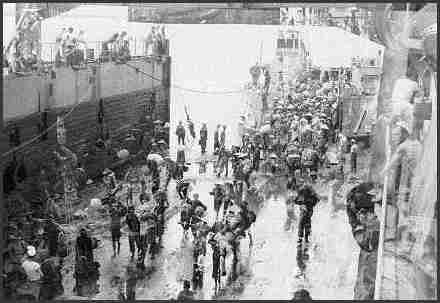
PICTURE 2

PICTURE 3
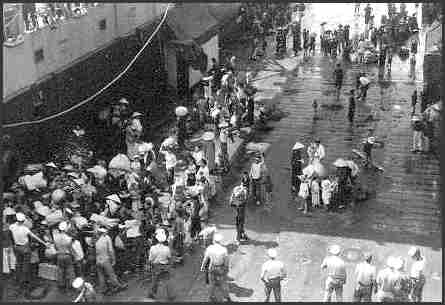
PICTURE 4

PICTURE 5
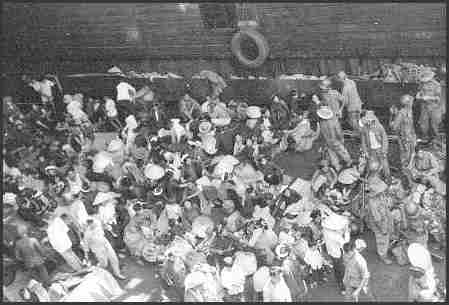
PICTURE 6
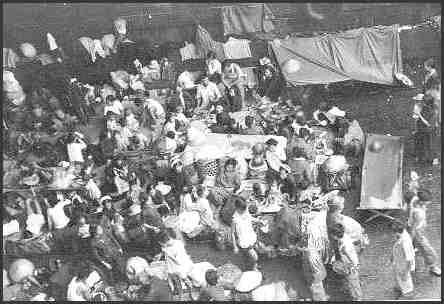
PICTURE 7
1957 WestPac Cruise Log Book Entry
19 February. 1957: The steaming watch is set; underway from Pier 5, U.S. Naval Base, San Diego, California for Yokosuka, Japan .
Joined formation with U.S.S George Clymer, Renville, Bayfield, Seminole, Whetstone, Colonial, Balduck, Begor . The men on the decks of the USS Tortuga watched the shores of Point Loma Coronado drop below the misty Pacific horizon. Ahead lay seven months of operation in a part of the world that has mystified the travelers from the Western civilization since the time of Marco Polo. Some of the men aboard the ship had visited the Far East on previous Naval tours; to many, however, it was to be a new experience and one which, judging by the advice of the old timers, would be unforgettable.
From the beginning of the voyage the Tortuga encountered high winds and rough seas in which she took rolls from "38 to 40" degrees. The ship suffered casualties such as split seams and torn away life rafts. Messing became each man's problem; many meals ended up on the deck or in the laps of the crew. For many this was the first cruise and sea sickness was not rare.
28 Feb; Tortuga is steaming in merchant convoy formation approaching Hawaii; suddenly "Right Full Rudder" and the ship swings around just in time to avoid an actual "exercise torpedo" fired during a submarine exercise. This training created a realistic situation that went far in making the Tortuga "battle wise."
3 March: crossed the International Date Line (4 March the day that never was)...
Finally, after three weeks of plowing through mountainous seas, the ships were ordered by the Squadron Commodore to build up steam and "run for the shelter of Yokosuka with all possible haste." The three LSD's remained together and steamed up Tokyo Bay .
14 March, 0415; Land Ho . . . 0830; Steaming up Tokyo Bay - all engines ahead full . . . 1548 ; Moored starboard side, Berth 5, Yokosuka Naval Base, Yokosuka Japan. Liberty commences immediately.
U.S. Nuclear Tests
Operation Hardtack I
1958 - Pacific Proving Grounds
|
In 1958 the arms race preceded apace, with the enormous weapons production
infrastructure and both weapons labs operating at full speed. Hardtack
I included 35 tests, the largest test series so far (1958 in fact saw
a total of 77 U.S. tests, more than the three previous record setting
years combined). Partly this burst of testing activity was due to building
pressure for an imminent test moratorium, leading the weapons labs to rush
as many device types to the test range as possible. A total of 35.6
megatons were shot during this series. |
|
USS TORTUGA (LSD-26) |
FEB 58-APR 58 |
OPERATION HARDTACK was regarded as secret at the time and no one was allowed to have any cameras on board. It is rumored that photos were taken by the US Navy, but access to these photos has been denied at this time.
In February of 1958 the Tortuga participated in "Operation Hardtack" the thermonuclear weapons test series of that year conducted at Eniwetok and Bikini Atolls in the Marshall Islands. She transported equipment and supplies from San Diego to Eniwetok and Bikini and upon arrival provided shipping for cargo and personnel between the atolls while operating between Atolls @ about 0630 in the morning we ran aground a large "Coral Reef," as a result of the grounding the Tortuga sustained serious damage to the bow area.
She limped back to the States and had an escort ship part of the way, and proceeded to Oakland and went into to Dry-dock extensive for repairs.
In 1958 the arms race proceeded at a swift pace with the enormous weapons production infrastructure and both weapons labs operating at full speed. Hardtack I included 35 tests, the largest test series so far (1958 in fact saw a total of 77 U.S. tests, more than the three previous record setting years combined). Partly this burst of testing activity was due to building pressure for an imminent test moratorium, leading the weapons labs to rush as many device types to the test range as possible. A total of 35.6 megatons were shot during this series.
List of Ships at Operation Hardtack 1958
USS BOXER (CVS-21) FEB 58-AUG 58
USS COMSTOCK (LSD-19) DEC 57- APR 58
*USS TORTUGA (LSD-26) FEB 58-APR 58
USS BELLE GROVE (LSD-2 ) APR-58-AUG 58
USS MONTICELLO (LSD-35) APR 58-AUG 58
T-LST 618 SEP 57-DEC 58
T-LST 664 SEP 57-OCT 58
USS RENVILLE (APA-227) APR 58-MAY 58
USS MAGOFFIN (APA-199) MAY 58-JUN 58
USS NAVARRO (APA-915) JUL 58-AUG 58
USS FLOYD B. PARKS (DD-884) MAR 58-MAY 58
USS JOHN R. CRAIG (DD-885) MAR 58-MAY 58
USS ORLECK (DD-886) MAR 58-MAY 58
USS PERKINS (DDR-877) MAR 58-MAY 58
USS MANSFIELD (DD-798) MAY 58-AUG 58
USS COLLETT (DD-730) MAY 58-AUG
USS DEHAVEN (DD-727) }MAY 58-AUG 58
USS BENNER (DDR-807) MAY 58-AUG 58
USS EPPERSON (DDE-719) AUG 58-AUG 58
USS CHANTICLEER (ASR-7) APR 58-MAY 58
USS GRASP (ARS--24) MAR 58-JUN 58
USS BOLSTER (ARS-38) MAR 58-JUN 58
USS MOCTOBI (ATF-105) FEB 58-JUN 58
USS ARIKARA (ATF-98) MAR 58-AUG 58
USS TAKELMA (ATF-113) MAR 58-AUG 58
USS MUNENSEE (ATF-107) MAR 58-JUN 58
USS CHOWANOC (ATF-100) MAR 58-JUN 58
USS CREE (ATF-84) APR 58-AUG 58
USS HOOPER ISLAND (ARG-17) APR 58-JUN 58
USS CACAPON (AO-52) MAR 58-AUG 58
USS LANSING (DER-388 ) MAY 58-AUG 58
USS JOYCE ( DER-317 ) MAY 58-JUN 58
USS SILVERSTEIN (DE-534) SEP 58-SEP 58
USS REHOBOTH ( AGS-50) APR 58-JUN 58
USS LAWRENCE CTY (LST-887) MAY 58-JUN 58
USNS AINSWORTH (T-AP-181) APR 58-JUL 58
USS BONITA (SSK-3 ) APR 58-JUN 58
USS KARIN ( AF-33 ) MAR 58-AUG 58
USS MERAPI ( AF-38 ) MAR 58-AUG 58
USS COGSWELL (DD-651) JUL 58-AUG 58
USS SAFEGUARD (ARS-25) JUL 58-AUG 58
USS HITCHITI (ATF-103) JUL 58-AUG 58
USS TILLAMOOK (ATF-102) JUL 58-AUG 58
|
Tortuga’s Location, 12 April 1958
Saturday, 12 April 1958 |
||||||
|
· Steaming in company with Task Unit 7.3.7 composed of USS Comstock (LSD-19) and USS ORLECK(DD 886), enroute from Bikini to Eniwetok in accordance with orders of CTU 7.3.7. This ship steaming a barrier patrol (narrow weave) 15° either side of base course 270°(T), speed 15 kts., 2,500 yds. ahead of the guide. Formation course 270°(T), speed 14 kts. OTC is CTU 7.3.7 in USS Comstock (LSD-19). Condition of readiness III and material condition YOKE (modified) is set throughout the ship. Boilers #2 and #4 and generator #2 are on the line for steaming purposes. |
||||||
|
· Sighted surface contact bearing 268°(T), range 12.8 miles. |
||||||
|
· Changed speed to 14 kts., ceased weaving. |
||||||
|
· Surface contact identified as USS Tortuga (LSD-26). |
||||||
|
· Changed speed to 15 kts. |
||||||
|
· USS Tortuga (LSD-26) passed abeam to port, distance 2,000 yards. |
||||||
|
V.B. Melvin, LTJG., USN |
Operation Hardtack 1
1958
US Atomic Veterans
Charles R. Westbrook
Stationed aboard the USS Tortuga-26 during
Operation Hardtack
Date: Fri, 24 Jul 1998
Subject: Hardtack
I served aboard the Tortuga from 1956 to late 1959 and was on board the Tortuga "Feb. 58-Apr.58" as shown in the list of ships involved in operation Hardtack.
To the best of my knowledge we were not involved in any detonations.
We transported a lot of equipment in our well deck and it was always covered with large tarps. When we would inquire about it, we were told that it was "top secret."
In 1958, you did not question anything; you just carried out your orders and kept your mouth shut.
We did have liberty call on Eniwetok or Bikini and played baseball and swam in the water. We were instructed "not" to eat the coconuts.
It is kind of ironic, because I was just talking to one of my former shipmates on the telephone yesterday about this operation. We did not remember what it was called, but were curious about all the secrecy.
Charles R. Westbrook
Evansville, IN.
Operation Hardtack 1
1958
US Atomic Veterans
James Rodger Oneyear
Stationed aboard the USS Tortuga-26 during
Operation Hardtack
Subject: Atomic veteran (Operation Hardtack)
Date: Thu, 6 Aug 1998
I'm 59 years old until January 1999. I was involved in operation Hardtack in 1958 aboard the USS Tortuga LSD. I was an electrician third class and worked mainly on the switchboard.
Some of my shipmates were Bob Ward, Bill? Baker and Doug Marshall. After forty years my memory on the subject isn't much. I remember we had a beer party on Japan before the exercise. I remember wearing film badges to detect radiation during the operation.
The ship was fitted with a wash down system for contamination from the nuclear test. After the exercise and partly way to port we ran aground on a coral reef. This put a hole in the bow big enough to run a truck through. The force in which we hit the reef was such that it knocked everyone out of their bunks. Damage control patched the ship and due to it having so many ballast tanks we did not sink. We hotfooted it to San Francisco at 12 knots for repairs. This is about all I remember.
I'm adding an attachment. It's a copy of the parchment certificate I received for being a part of the exercise.
Sincerely,
James Oneyear
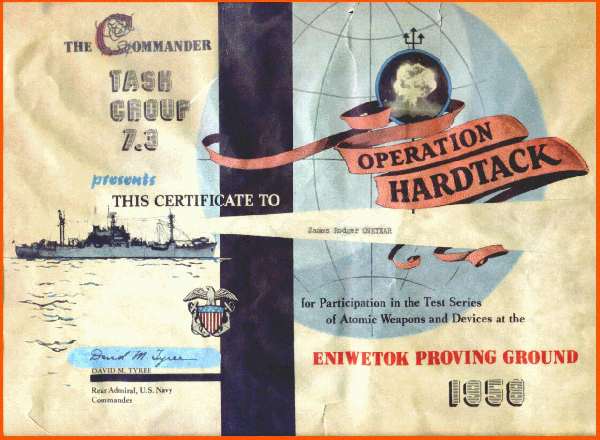
Hardtack 1958
US Atomic Veterans
George Tower
Date: Tue, 13 Mar 2001
Subject: Military Service in Eniwetok (Operation Hardtack 1-1958)
I served on the USS Tortuga (LSD26) during operation Hardtack. We left the area prior to the nuclear blasts, however I recall signs posted on the atoll advising, "Don't eat the coconuts. Radioactive”. Also I recall all the native islanders were relocated. But we did our service on the atoll. I married my first wife in 1965. My first son was stillborn; my daughter has a cleft lip/palate. I, to this day wonder if my service in Eniwetok had something to do with that. Second marriage, two sons seem normal.
George Tower
Operation Hardtack
1958
Fact Sheet
Public Affairs Office
Washington, D. C. 20305
HARDTACK was the designation given to the atmospheric nuclear weapon test conducted by the United States in the Pacific Ocean and in Nevada in 1958. Operation HARDTACK I was a series of 35 tests, all but two of which were detonated at Enewetak and Biking atolls in the Marshall Islands, the Atomic Energy Commission's (AEC) "Enewetok Proving Ground" (EPG). The other two were detonations at 42 and 76 km above Johnston Island, which lies about 700 miles (1,296 km) west-southwest of the Hawaiian Islands.
A joint military conducted the tests and civilian organization designated Joint Task Force 7 (JTF 7. JTF 7 was a military organization in form but was made up of military personnel, Federal civilian employees, and contractors of the Department of Defense (DOD) and the AEC. The commander of this force was the appointed representative of the AEC and reported also to the Joint Chiefs of Staff (JCS) and the Commander in Chief Pacific (CINCPAC)
TEST OPERATIONS
During HARDTACK the United States fired as many nuclear devices (35) as had been fired in all prior Pacific Ocean tests. Not only was the total number of shots in HARDTACK large but also the variety of types was great; land - and water - surface events, underwater detonations and balloon - and rocket - born high-altitude tests were conducted. The following page of this fact sheet lists the names, dates, and locations of the shots.
In a sense, HARDTACK was divided into three parts. The first was aimed at the development of nuclear weapons continuing the type of testing that had taken place at Enewetak and Bikini during the early and mld-1950s. In these tests, the AEC weapon development laboratories (Los Alamos Scientific Laboratory and the University of California Radiation Laboratory) detonated their experimental devices with the DOD providing support and conducting experimental that did not interfere with the AEC Activities.
The second part sponsored by DOD, consisted of the underwater test shots, WAHOO and UMBRELLA, the first in the open ocean and the second within the lagoon at Enewetak. The purpose of these tests was to improve the understanding of the effects of underwater explosions on Navy ships and material. These tests could be considered as the continuation of BAKER test of the CROSSROADS series at Bikini in 1946 and the WIGWAM test 500 miles (927) km) off the U.S. West Coast in 1955.
* Formerly Eniwetok. The spelling of Marshall Island place names has changed in recent years in order to more accurately render the sounds of the Marshall Island names using English spelling.
The third part. Also sponsored by DOD, addressed a military problem that was newer: nuclear weapons in air and ballistic missile defense. The HARDTACK tests directed toward this problem consisted of three high-altitude shots, two of which (TEAK and ORANGE) were rocket borne and were conducted at Johnston Island. The third of these high-altitude tests YUCCA was carried aloft by a balloon over the ocean between Enewetak and Bikini. These high-altitude tests used device placement techniques and data-recording operations that were new to nuclear weapons testing.
Central to the test series was the experimental program. This program and its requirements dictated the form of the test organization and the detail of personnel participation. HARDTACK's experiments program incorporated two aspects. The first of which was the development of the weapons themselves, and the second involved the measurement of the explosive and radiation effects. Unlike earlier nuclear test series, the HARDTACK test operations supporting each aspect were in large part separate.
These two aspects can serve as a rough measure of differentiation of interest between the major participants: the AEC interest in weapon development and the DOD interest in the military application of the effects of the explosions. The several parts of the weapon development and effects studies each had particular features that led to the possibility of radiation exposure.
RADIOLOGICAL SAFETY
For Operation HARDTACK, CJTF 7 was directed to "assume overall responsibility for the radiological safety of Task Force personnel and of populated lslands." To carry out this responsibility the JTF 7 Operation Plan further directed that a Fallout plotting Center be set up and that the capability be established to keep the task force and CINCPAC informed of the fallout situation at all times, including the announcement of safe reentry times. Fallout stations were to be set up and technical assistance given to personnel in the Trust Territory of the Pacific Islands. Monitors and couriers were to be provided for radioactive sample centers.
In addition, the Operation Plan specified that task group commanders establish radiation safety (radsafe) units within the task groups with adequate special clothing and radlac instrumentation. Task groups were also to provide a roster of their personnel for film badge preparation.
The radsafe program for Operation HARDTACK was divided into two parts: onsite and offsite. Onsite radsafe activities were conducted by the various task groups, with the scientific task group given the responsibility for all radsafe functions associated with diagnostic experimental programs and for dosimeter and other technical services to the entire task force. The operation of the offsite program and the coordination of the onsite activities were conducted by the Radsafe Office of HQ JTF 7.
RADIATION SAFETY STANDARDS
A maximum permissible exposure MPE) for personnel was set at 3.75 roentgens (R) (gamma only) per consecutive 13 - week period with a maximum of 5 R for the operation.
Exceptions were made for emergency and other tactical situations. The operation was defined as the period from 15 days before the first ready date to 15 days after the last shot. A special MPE of 10 R was authorized for crewmembers of air - sampling aircraft. In the event of operational error or emergency, an additional exposure of 10 R would be accepted. Any exposure in excess of 20 R total would be considered as on overexposure for aircrew samplers.
The limit of 3.75 R per 13-week period was slightly greater than the National Council on Radiation Protection and Measurements and the International Commission on Radiation Protection limit of 3 R per 13 - week period In effect at that time. The limit of 5 R for the Operation is equivalent to the exposure currently permitted per year by Federal guidelines for radiation workers. Appropriate remarks were to be included in the medical records of personnel who exceeded the 3.75 and 5 R limits. Military personnel were to be advised that they should not be exposed to further radiation until sufficient time elapsed to bring their average radiation exposure down to 0.3 R/week. Civilian personnel in this category were to be informed that limitations on further radiation exposure were to be determined by the laboratory or agency having administrative jurisdiction over such personnel.
A film badge program provided an exposure - indicating device to all JTF 7 personnel to maintain complete exposure information on everyone entering the EPG during the operation. The commander of the scientific task group assigned overall badging responsibility to a special task unit. Beginning 1 April 1958, film badges were issued to all individuals upon their arrival at the EPG with instructions that the badge be worn at all times and turned in on recall, upon exit from any contaminated area, or upon departure from the EPG.
SUMMARY OF TASK FORCE EXPOSURES
The table on the following page documents the numbers and percent of task force personnel who received exposures in various categories. These data are based on the latest data available and may be added to as research is completed. Of the some 19.600 individuals badged at HARDTACK, 99 percent had exposures that did not exceed the current Federal guidelines of 5 R per year. The highest recorded exposure for the series was 12.41 R. The overall joint task force mean exposure was 0.87 R.
During the conduct of the series only one incident occurred of an exposure of a large group of JTF 7 personnel to significantly elevated radiation levels. This happened on 14 May when the base islands (Enewetak and Parry) at Enewetak Atoll received fallout from a test shot that had been detonated at Bikini two days before. This fallout episode, which lasted about 60 hours, could have contributed as much as 1.2 to 1.5 R total dose to personnel on Enewetak Atoll depending upon the island on which they lived and their work activities, however. since nearly all personnel wore film badges, this fallout exposure is reflected in the film badge doses.
There was one known incident of offsite fallout. Two Japanese research vessels operating outside the danger area set up around the EPG detected an increase in radiation after shot POPLAR. An investigation by the JTF 7 Staff Surgeon revealed that this exposure was small amounting to; at most 0.085 R for the crew, and even this figure did not reflect the decontamination procedures that were used to lower the contamination.


Operation Blue Star
The next large-scale training exercise took place in May 1960. Designed to improve amphibious planning and promote a closer working relationship between the forces of the United States and those of the government of the Republic of China, Operation BLUE STAR was a five-day amphibious exercise on the southern part of Formosa, a combined amphibious operation with Chinese Nationalist Forces. Under the protective cover of Marine and Chinese aircraft, joint forces of combat-ready U. S. and Chinese Nationalist Marines assaulted the beaches of Formosa in one of the largest ship-to-shore war games in the Western Pacific area since World War II.
62/63 CRUISE
At the commencement of the deployment, our experience at Pearl Harbor foretold a highly successful and enjoyable cruise ahead. During the layover caused by the "Cuban Crisis," we not only enjoyed excellent liberty and recreation but managed to complete a good percentage of our required training exercises culminating in winning the second gunnery "E" for each of our mounts and directors.
The operational highlight of our cruise was undoubtedly the surface amphibious assault under cold weather conditions, exercise "Dark Moon" in Chuminjin, Korea, using a reinforced Battalion Landing Team. Along with a variety of embarked detachments, we acted as the advance reconnaissance unit and then as the primary control ship on "R" and "D" days. This exercise gave us invaluable experience under adverse conditions. The minimum temperature encountered was 9 degrees F!
Our stay at Pearl Harbor and our visits to Kobe and Hong Kong were certainly the highlights of our liberties and sightseeing opportunities. The Kobe visit and the Amphibious Force 21st Birthday Open House at Yokosuka gave us the chance to actively participate in the people-to-people program.
The entire cruise proved to be a smooth one. We were blessed with a minimum of foul weather, a good itinerary of ports, only a few minor material casualties and met all commitments on schedule and in a highly competent manner. Certainly our material reliability and operational readiness reached a high level.
While we have had a long separation from home and loved ones, we have realized that our being ready with the Seventh Fleet has had a real and significant influence in maintaining world peace.
I am sure that all of us will look back on this cruise of the Tortuga with fond memories.
Commander George M. Hayes
Commanding Officer

Commander Hayes took command of the
Tortuga on 24 February 1962.
OPERATION DOMINIC
The Tortuga participated in Operation Dominic in 1962 which was a 36-detonation atmospheric nuclear test series. The first phase occurred from 25 April through 11 July 1962, the second phase from 2 October through 3 November 1962. During the first phase, 24 nuclear weapons were dropped from aircraft for air bursts in the vicinity of Christmas Island. One warhead was sent aloft by rocket from Johnston Island for high altitude detonation, but three attempted launches of nuclear tipped rockets from that island were failures. Shot Swordfish was an underwater detonation of a stock nuclear anti-submarine rocket (ASROC) weapon approximately 370 nautical miles west-southwest of San Diego. Shot Frigate Bird was the detonation of a Polaris missile warhead over the Christmas Island Danger Area. During the second phase, four nuclear warheads were rocketed from Johnston Island for high altitude detonation, and one rocket launch was a failure. Five weapons were dropped from aircraft for air bursts in the vicinity of Johnston Island. This thermonuclear frenzy of superpower saber-rattling was the end of US and Soviet atmospheric detonations.
Operation Dominic Summary
Legend:WD=Weapons Development, WE=Weapons Effects, ST=Safety Test, TN= Thermonuclear, LASL=Los Alamos Scientific Laboratory, UCRL=University of California Radiation Laboratory (later Lawrence Livermore), DOD = Department of Defense.
|
Test Name |
Time and Date (GMT) |
Location |
Test Type |
Height (Ft) |
Yield (kt) |
Sponsor |
Purpose |
Comments |
|
|
Swordfish |
20:02 11-May-62 |
400 nm W San Diego |
Underwater |
-650 |
<20 |
LASL |
WD |
Full scale ASROC/W-44 ASW rocket proof test, sim. to Nougat Chena |
|
|
Frigate Bird |
23:30 6-May-62 |
Johnston Island |
SLBM Airburst |
11,000 |
600 |
LRL |
WD |
Only US operational ballistic missile launch w/live warhead, Polaris SLBM/W-47Y1/Mk-1 RV combo, successful |
|
Viet Nam
During the 14 years from 1955 to 1969, Tortuga would remain employed in a regular schedule of deployments to WestPac. She was based at San Diego until 30 June 1966, when her home port was changed to Long Beach. In between deployments—which included exercises and equipment lifts and labors to help maintain the 7th Fleet's readiness—Tortuga conducted local operations put of west coast ports and underwent progressive modifications during regular availabilities.
To the best of my recollection we left San Diego on July 6, 1964 headed for Hawaii and Hong Kong as part of a normal West Pac deployment. We had barbequed six way beef steaks and passed the International dateline, had the King Rex initiation culminating in kissing the Chief Storekeeper's belly with jension violet in our mouth and having been dosed with flour. Of course we had to run through the well deck to get cleaned off by the fire hoses. We arrived in Okinawa, were there two days and the Bay of Tonkin incident with the Turner Joy happened. I returned to the ship about 2 AM and was advised to go to the Wardroom. The mustangs and Korean veterans were white faced. They knew what was about to happen.
The next day the Captain, Wolf Heinberg, confined all to the ship and I was ordered to "top-off" and prepare to sail as soon as we had supplies and had loaded 5000 marines from Division 3-1. We got underway the next day. We proceeded to the South China Sea and for the next 3 months we cruised up and down the coast waiting for orders to land. Supposedly the US Government had to pay the South Vietnam Government $3 million before they would give us permission. We finally got orders and decided that we should have a practice "landing" in the middle of the South China Sea to make sure we were ready. We ballasted down launched the LCMs and the mike boats to the imaginary line and then discovered that the Marines were out of condition.
They were to climb up the Jacob ladders and they could not make it, so we took them back to Okinawa and exchanged them for Division 1-3. We returned and sometime in October 1964 we made the first landing in DaNang. It was unopposed. We positioned sentries to shoot underwater swimmers and we went on watch for 4 hours on, 4 hours off. We had launched at 0400 and nothing happened until nightfall. I remember sleeping on deck because it was so hot and being wakened by the red light and thinking that it should not have been day yet. It was not--the Cong had fired mortars in the airbase and the war had started. That night 17 Seabee's were shelled and killed.
The events leading up to the landing were interesting also interesting. The Captain's gig was to lead the launch but at 0200 we could not find the coxswain. He had gotten into the Marine alcohol supplies and was hiding and when the Executive Officer found him he was chased in his skivvies and climbed up the mast. Needless to say he was court marshaled and sentenced to 6 months at hard labor. From October 1964 to September 1965 we continued to go back and forth between Okinawa and DeNang landing more troops waiting for the 8th Army to relieve the Marines. The ship moved to the Saigon River and captured a junk full of weapons and made the first boarding of an enemy vessel since the revolutionary war days. The only other event I was told about was when Walter Cronkite visited after I left. Supposedly he wanted a tour out in the river. He went out on a Mike boat and it got caught on a sandbar and for the next 48 hours the war stopped while everyone flew cover and tried to get them off the sandbar. I have many other stories but this is what I remember about the start of the war. I would be interested if others can add any additional detail or correct my 40-year-old memory. (Dan Worden)
As American involvement in Southeast Asia deepened during the latter half of the 1960's, Tortuga's deployment schedule accordingly reflected her role in the buildup of Allied strength to attempt to check communist domination of Southeast Asia. On 4 August 1964, North Vietnamese torpedo boats attacked Maddox (DD-731) and Turner Joy (DD-951) in the Gulf of Tonkin. As a direct result, the United States took ever-increasing steps to aid the South Vietnamese government in its attempt to combat Viet Cong insurgent activity within its borders. Within a few years, American involvement had been broadened from one of advising Vietnamese troops to the actual commitment of massive land, sea, and air forces. Soon after receiving word of the Tonkin Gulf incident, Tortuga—combat-loaded—got underway from Buckner Bay. She remained underway in the South China Sea from 6 August to 19 September before returning to Subic Bay.
For the remainder of the year 1964, Tortuga operated out of Yokosuka and conducted troop and equipment lifts between Japan and Okinawa until she headed home and arrived back at San Diego on 18 December. In February 1965, the landing ship proceeded to Camp Pendleton, Calif., to participate in Exercise "Silver Lance," the largest peacetime landing exercise ever held (from February 23, 1965 to March 12, 1965). In June, she commenced a WestPac deployment. She proceeded to Buckner Bay, Okinawa (loaded Marine Combat Unit - I Corps with the 3rd Shore Party Battalion, 3rd Marine Division), and sailed for Vietnam (landed at Red Beach just north of Da Nang). And, after operating in the Orient through the early summer, returned to Long Beach in late August 1965. She subsequently conducted a lift to Okinawa before she returned to San Diego for refresher training.
|
|
UNDERWAY
|
“On July 8 and 9 July 1965, USS Tortuga engaged in administrative off loading operations at DaNang Bay, Republic of Vietnam. The ship entered the bay fully load with embarked Marine Corps personnel and equipment destined for action in defending the Republic of Vietnam from further Viet Cong terrorist, subversion, and aggression. DaNang is one of the most important bases of operation in Vietnam. The area surrounding DaNang is heavily infiltrated with Viet Cong guerrillas. Even while offloading in the bay, the Viet Cong were waging battle with defending United States and Vietnamese Republican Forces.”

Wolf Heinberg
Commander USN
Captain of the Tortuga LSD-26
October 10, 1964 to November 28 1966
Tortuga sailed for Vietnamese waters on 1 March 1966, arrived at Vung Tau on 18 April, and relieved Belle Grove (LSD-2) as support ship for "Game Warden"—the Navy's operation designed to interdict the flow of communist supplies along the coastlines of South Vietnam. Initially, Tortuga operated in the Rung Sat special zone between Saigon and Vung Tau, helping to guard the entrance to the shipping channels snaking through Viet Cong territory to the capital city.
USS Tortuga sailed for Vietnamese waters on 1 March 1966, arrived at Vung Tau on 17 April 1966, and relieved Belle Grove (LSD-2) as support ship for "Game Warden"—the Navy's operation designed to interdict the flow of communist supplies along the coastlines of South Vietnam. Initially, Tortuga operated in the Rung Sat special zone between Saigon and Vung Tau helping to guard the entrance to the shipping channels snaking through Viet Cong territory to the capital city.
From March to June 1966, the USS BELLE GROVE (LSD-2) and the USS TORTUGA (LSD-26) brought the first PBRs into Vietnam with the deployment to Cat Lo of River Division 53 and River Division 54 elements.
On 26 March 1966, U.S. Navy, U.S. Marine, and South Vietnamese forces kicked off Operation Jackstay, the war's first major action in the Rung Sat. PBR units (including one section from Tortuga), minesweeping boats from Nha Be, SEALs, and helicopters operated together to sweep the area. At the end of the 12-day effort, the allies had killed or captured 69 of the enemy; destroyed Viet Cong supply bases, training sites, and other logistical facilities; and, at least for a time, restricted enemy movement in the zone.

USS Tortuga (LSD-26) was in the Vietnam Operation during the following period in 1966, April 16, 1966 to September 13, 1966

Swift Boats
PCFs 42 thru 48 were delivered to Cam Ranh Bay from Subic Bay, PI, onboard the USS Tortuga LSD 26 on 17 April 1966. While offloading, at night, from the LSD, one boat suffered a damaged screw and four others had damaged skegs.
Helicopters - Task Force Sea Wolf
April 1966
The
activities of Task Force Sea Wolf for the past two weeks consisted of flying
armed aircraft support for river patrol boats in the Rung Sat Special Zone
supporting the Nha Be(Headquarters) and Soi Rap-Long Than River Areas. The armed
helicopters operate from two naval vessels at this time; they are the LSD
Tortuga and the LST Floyd County. The armed aircraft flew a total of 82
hours for the two week period accounting for an estimated 10 Viet Cong killed
and two
sampans destroyed. On 26 April, the U.S.S. Tortuga was
visited by General Westmoreland, COMNAVFORC, at which time they were able to
witness the armed helicopters in action.
|
|
In 1965 increasing american operations in Vietnam resulted in Operation Game
Warden the creation of Task Force 116 ( a so called brown water navy
) in order to deny Viet Cong access to the resources in the Mekong Delta .
Among the air units withiin TF116 were Heavy Attack Squadron 21 ( VAH-21
Roadrunners ) flying gunships AP-2H Neptunes, Light Attack Squadron Four ( VAL-4
Black Ponies ) flying 18 OV-10A Broncos borrowed from the USMC and Helicopter
Attack (Light) Squadron Three ( HAL-3 Seawolves ).
In March 1966 when operations begun and the promised helicopter squadron wasn’t
created yet, TF116 used men and UH-1B Hueys from US Army 145th Combat Aviation
Battalion (197th Aviation Co)
In June 1966, navy pilots from Helicopter Combat Support Squadron One (HC-1 at
the time flying
UH-2 Seasprites
for the pacific fleet aircraft carriers ) joined TF116 and began the transition
to the Huey taking over the missions from the Army by September.
HAL-3 was formally created April 1st, 1967 at Vung Tau and up to nine
detachments will be created until the squadron is finally disbanded on January
1972.
From the beginning their helicopters not only operated from land bases but also
from support ships: USS Belle Grove (LSD-2), USS Comstock (LSD-19), USS Tortuga
(LSD-26), USS Floyd County (LST-762), and USS Jennings County (LST-846).
From 1970 , USS Garrett County (LST-786), USS Harnett County (LST-821) and USS
Hunterdon County (LST-838), were reassigned to the AGP role (patrol craft / boat
tender) .
Among the helicopters used by HAL-3 were Army UH-1B/C/M Huey variants,
Marines UH-1E
and Navy
HH-1K
and
UH-1L

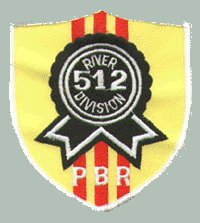
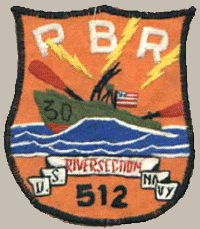
When the first 10 PBRs arrived in Vietnam on 21 March, the Belle Grove assumed the duty of mother ship for the new arrivals. After Operation Jackstay terminated on 4 April, the Army gunships remained aboard the Belle Grove to continue development of PBR gunship tactics preparatory to the PBRs first operational mission the next week. Assigned to the Navy's newly activated Task Force 116, or operation Gamewarden, the first patrol was mounted on 10 April 1966 as 2 PBRs of River Squadron Five began operations along the Long Tau River. The Belle Grove was relieved of its duties to TF-116 on 19 April by the USS Tortuga (LSD-26).
This arrangement of Army air crews flying in support of naval operations from Navy ships caused difficulties which both services were quick to discover. Even though the Army pioneered the armed helicopter concept and developed much of its tactics, they did not have experience in supporting naval riverine operations. While that experience could undoubtedly have been gained over a period of time, it was felt naval aviators trained in gunship operations would more quickly and readily adapt to the mission requirements.
Part of this was the necessity to operate at night in bad weather from the deck of a ship. The PBRs worked around the clock in all weather conditions so it was highly desirable their air support would be available then as well. At this point in time, Army gunships were not equipped for and their pilots not skilled in all weather helicopter flying, particularly from a floating deck. In many cases, the Army would not accept missions in marginal weather, especially at night. Flying in the dark of night in bad weather or without good horizontal definition is a sticky proposition and more than one Army helicopter was lost under these conditions. It was believed that Navy helicopter pilots, skilled at antisubmarine warfare and search and rescue operations which required a similar all weather capability, would be better able to cope with this environment than their Army counterparts.
Also, a dedicated Navy air unit committed directly to the Gamewarden mission could provide a relatively stable source of air support that would not require careful inter-service coordination to assure availability. Direct Naval air support for the PBRs was viewed as the solution for existing and anticipated problems of command, control and availability.
Tortuga shifted to the Mekong Delta region on 12 June to serve as a floating base for the Navy's fast PBR's of TF 116 and for a detachment of Army Bell UH-1B Huey helicopter gunships. The PBR's, attached to River Patrol Squadron 512, were small yet relatively heavily armed craft. Each mounted a .50-caliber machine gun forward and an "over-and-under" combination mount of one .50-caliber machine gun mounted over an 81-millimeter mortar aft. The helicopters, too, were relatively heavily armed, packing a "punch" of rockets of varying sizes and up to six machine guns. Initially, the helicopters were Army "choppers" from the 145th Aviation Detachment. However, by the end of Tortuga's tour, they were Navy aircraft from Task Force "Sea Wolf." Together, the PBR's and Hueys conducted their patrols and forays into the verdant jungle waterways; the PBR's knifing through the muddy sandy-colored waterways while the helicopters flew close cover above.
Occasionally, the hard-hitting teams would strike "pay-dirt," by capturing enemy munitions. On one occasion, on 12 June at the mouth of the Co Chien River, Tortuga's PBR's participated in the capture of a large stock of guns and munitions captured from a damaged communist trawler which had been forced aground and set afire.
During her support operations with the riverine assault groups, Tortuga received a number of distinguished visitors ranging from General William C. Westmoreland, Commander, Military Assistance Group; Rear Admiral N. G. Ward, Commanding Naval Forces, Vietnam; as well as United States Ambassador to South Vietnam Henry Cabot Lodge; and news commentator Chet Huntley, who brought with him an NBC camera team to record a news story on Tortuga's river patrol base activities.
Picture by Mike Wilson MM2 USS TORTUGA 1966
Picture by Mike Wilson MM2 USS TORTUGA 1966
When the ship was at anchor In Vung Tau, Vietnam, members of the crew went on liberty many times. The crew was transported from the ship to Customs House Pier for liberty.
With a population of about 40,000, Vung Tau offered an interesting but somewhat limited selection of shopping opportunities. The Army and Navy have provided a variety of service clubs whose recreation facilities were open to us.
USS Tortuga (LSD-26)
Western Pacific Cruise Book
1 March through 7 November 1966
It was common for USS Tortuga crewmembers in their time off to accompany members assigned to the ship of the PBR (Patrol Boat River) and Army & Navy Huey Helicopter on patrols (mail & “milk runs”). This was to break the boredom of ship living. During tours of Vietnam, we were highly mobile, moving about the countryside in secure areas on liberty, time off, and duty. Tracking a single individual for every day of their tour is extraordinarily difficult. We were ashore (in country) in all of the Four Corps areas of Vietnam. Most of our time was in the” III Corps area, which received the heaviest concentration of spraying of Agent Orange”.
http://www.lewispublishing.com/map1.htm
http://www.usvetdsp.com/agentorange.htm
Because of the going ashore, traveling in country, and working near shore we (shipmates on the Tortuga LSD-26) were routinely given orange anti-malaria tablets as medication aboard ship when in Vietnam.
United States Naval Operations Vietnam, Highlights; (No. 7) April 1966
River Patrol Force
Operation GAME WARDEN entered its fledgling stages during April as the first PBRs became operational and patrolled the waters of the Rung Sat Special Zone. As the new crews received area indoctrination and training, construction of new bases in the Mekong Delta area continued in preparation for the arrival of the first patrol units during the forthcoming months.
The departure of the Seventh Fleet Marine Amphibious Force from the Rung Sat Special Zone on 7 April signaled the termination of Operation JACKSTAY. Highly successful in terms of equipment and facilities captured or destroyed, JACKSTAY also resulted in 63 Viet Cong killed. But the likelihood was great that Viet Cong forces in the area would attempt to re-infiltrate into the Rung Sat Special Zone and establish once again their secure bases.
To counter this possibility by denying the Viet Cong use of the major waterways in the Rung Sat Special Zone, the CTF 115 river patrols established during JACKSTAY were maintained after completion of the operation. The ten patrol stations were to be manned by five WPBs and four PCFs. Two LCPLs, the UH-1B fire teams, and the MSBs were to assist. The PBRs were scheduled to phase in when operationally ready. Vietnamese Navy assistance was also requested. On 6 April, the units chopped to operational control of CTG 116.2, and commenced patrol.
On 8 April, Vietnamese Navy units relieved two stations, freeing one WPB and one PCF for MARKET TIME patrol. River Assault Group units, consisting of one commandament, one FOM (similar to STCAN), and one monitor, assumed patrols on the upper Soirap River. Other VNN units patrolled the eastern reach of the Vamco River and the Dong Tranh River. On 8 April, the PBRs of River Patrol Section 541 commenced orientation patrols with PCFs and WPBs on the Long Tau River stations. On 15 April, the PBRs reported they were ready to assume any two stations. On the following day, the PBRs commenced patrol, resulting in two PCFs and two WPBs released for MARKET TIME operations. This resulted in seven stations manned continually by United States units: two by PBRs, three by WPBs and two by PCFs. PBRs occupied one additional station vacated by Vietnamese Navy units on 16 April.
The Soirap River patrol stations continued to meet with success as the Viet Cong persisted in their attempts to utilize this waterway. On 17 April, PCF 23 illuminated a contact attempting to cross the Soirap River just north of the Vain Sat River mouth. The sampan maintained speed and opened fire with small arms. Four people in the sampan jumped overboard as PCF 23 returned the fire. The sampan was taken in tow but subsequently sank. Enemy shore fire prevented a continued search of the area.
The effectiveness of the Soirap River patrols can also be measured in terms of the stepped-up harassment of patrol units. On numerous occasions during the month, the boats came under moderate to heavy small arms and automatic weapons fire from the banks, Most of the harassing fire was received in the section near the mouth of the Vain Sat River, a known infiltration route terminal and the scene of considerable action during March and April. Shore fire was also received on two occasions near the mouth of the Soirap River.
Meanwhile the Long Tau River patrol stations continued relatively quiet. Intelligence reports during the month indicated a partial shift in Viet Cong infiltration patterns into the Rung Sat Special Zone, with traffic entering from the east, originating in Viet Cong strongholds in Phuoc Tuy Province. However, no evidence of this was uncovered by the Long Tau River patrols. One reason for this may exist in the fact that the Long Thu River, with its narrow, sinuous channel, presents a much more difficult patrol area than the wide, straight Soirap River. With the exception of the wide section near the mouth of Ganh Rai Bay, transit across the Long Tau can be accomplished quickly, making detection difficult.
On 26 April, an additional twelve PBRs arrived at Cat Lo. These units commenced shakedown cruises from the base at Cat Lo and from USS Floyd County (LST-762), which had arrived in country on 12 April to become the second Inshore Support ship. River Division 51 was activated on 27 April aboard USS Tortuga (LSD-26) in preparation for the first transit into the Mekong Delta in May. The new units were designated River Section 512.
While crew performance during the initial month of PBR operations was regarded as excellent, numerous problem areas arose in the boats themselves. The narrow vinyl beading which served as a fender was not adequate protection when boarding and searching larger junks, or when alongside a support ship. This resulted in damage to the side. To correct this, discarded helicopter tires were obtained for use as fenders. Armor plating around the forward gun mount has been removed on all boats to improve gunner and coxswain visibility and communications. M-72s, one-time-only anti tank rockets, are being carried on all boats as interim ordnance pending approval and installation of the Mark 18, 40 mm rapid fire grenade launcher. In another ordnance improvement, .50 caliber machine guns are being installed
June 12, 1966
|
|
Hunting VC on the Waterways
|
VUNG TAU - About the first week of May the Pentagon began talking publicly about
a concept of river warfare aimed at accomplishing a mission in places such as
the Mekong Delta area of South Viet Nam, 14,250 square miles of manmade flood
zone where rice paddies, canals and rivers form a confusing network of obstacles
to surface travel.
The new concept was essentially a U.S. Marine Corp idea. It envisioned the use
of river patrol boats, helicopter reactions teams flying from ship platforms, a
ship as home operations base, and specialized teams of surface troops to control
the banks and the tributary entries into main streams.
As is usually the case, at about the time the Washington “concept” talk was
going on, the U.S.S.Tortuga was relieving the U.S.S. Belle Grove, which
actually started the operation in the Rung Sat Special Zone, in conjunction with
some spanking new Navy river patrol boats (RPBs) and two pairs of armed
helicopters drawn from the various companies of the 145th Aviation Battalion.
Helicopters, boats and men can control an area where river and canal traffic is
the primary method of transportation, as in the Mekong Delta or the Rung Sat
zone.
Sound Idea
The idea is sound, even though a lot of the details are still to be worked out
before the new methods become really effective.
I spent nine days on the U.S.S. Tortuga, anchored a mile or so from Vung
Tao and cut off from everything except the tight little universe of the men
engaged in the operation.
Each night I flew with a helicopter crew on patrols of the rivers or in answer
to calls from the river patrol boats when they received fire from the banks of
the waterways in their patrol areas.
Sometime I would mix up this schedule with a daylight run in the choppers. I
made a wearying and spooky 14-hour patrol with one of the little fiber glass
RPMs. They carry a four man crew and are just off the drafting boards. They
have a future which may be quite exciting for the sailors aboard.
Risky and Costly
It was costly in time and it got risky now and again, but as the pattern of the
operation became more familiar each day, the problems began to be identifiable
and it is in this area that the new idea for river warfare must meet its
toughest test.
The Viet Cong won’t really be able to cope with it if it is properly developed
and used. If it doesn’t work, it will be because human and mechanical problems
of a friendly nature keep it from doing so.
First, the area involved.
The Rung Sat Special Zone is a sector running from the bay here at Vung Tao,
where the Saigon River empties, to near Saigon and it looks as if it were
designed by hobgoblins for the entertainment of alligators and cottonmouth
moccasins.
Muddy and Swampy
It is muddy, full of mangrove swamps, cut by twisting little channels through
the major marshes. Some areas have heavy tree growth and there are limited
zones around villages where the land isn’t partially underwater.
Canals, creeks, and the multi-coursed channels of the rivers winding in almost
table flat terrain (except for occasional humps and hummocks) provide a
Vietnamese boater’s paradise.
The Viet Cong have used this area as a secure base and a way station, as an area
to store supplies being transported to other areas. Sampans ply almost every
inch of the waterways.
The people in this area are fishermen and woodcutters who have legitimate
business back in the dismal swamp stretches and along the canals. The whole
mode of life is centered on water - the sea and the rivers - and sampans.
Split Kind of Warfare
Americans patrolling the rivers have many new things to learn in this
split-personality kind of warfare. Somehow they have to check all suspicious
traffic, attempt to stop Viet Cong from intermingling with legitimate sampan
movement and do it in a manner which doesn’t make enemies.
A Coast Guard Swift boat which was on such a patrol recently had an experience
which illustrates the problem beautifully.
The crew on the 82-foot patrol boat saw a big sampan sailing briskly for an
isolated village and overhaul it.
The two Vietnamese were awed by all of the weapons the boat and its crew carried
and there was always a language problem, but one thing was very clear, the
sampan was in trouble. It was practically awash with water.
Pump Boat Dry
The Coastguardsmen hurriedly threw a pump into action and had the boat pumped
dry in a few minutes.
The Vietnamese advisor each of these Coast Guard boats carries for such problems
was not available just then, but when he came back aboard the crew told him what
had happened.
He then told them what had really happened.
The sampan was hauling fresh water to the village. Most of the settlements
can’t get water to drink in their area and depend on sampans which sell loads of
stuff from upstream (the river is salt near the sea) and the rescue operation
had just about cancelled a week’s work for the sampan crew.
Solution Presented
Somebody came up with the solution to how to stop VC from using the channels,
however and this is the basic idea as it was being used in the Rung Sat Special
Zone in its first test.
The boats have now moved to the more stringent problem of the Mekong area now
and the concept will become operational, but the test was based on these
considerations:
1. A curfew would be placed on river traffic, all legitimate boatmen would
travel only at day and tie up in specified anchorage at night.
2. Certain areas of the zone, known Viet Cong-controlled areas, would be
taboo for legitimate traffic at any time. Any boat in those areas would be
fired on as a Viet Cong transport.
Daytime-Controlled Traffic
3. Daytime traffic would be easily controlled and checked by the RPB crews.
Their new boats draw only a few inches of water. The fiberglass hulls are
unsinkable.
The new engines, a twin jet of water pumped by big diesels, were quieter than
most boats. Tests had indicated a speed of 25 knots. They would carry three
.50 caliber machine guns, two forward and one aft, and the crew would have M-16
rifles and M-79 grenade launchers with an M-60 machine gun which could be moved
as needed.
4. Because the high banks - especially at low tide - would give advantage to
snipers and ambushers, even more protection would be necessary. Helicopter
gunships would provide this by being on 24-hour alert, flying from an LSD and an
LST fitted up with flight decks.
Call in Boatmen
5. The helicopters would fly armed reconnaissance along the river areas as
well as be on call to assist the RPB crewmen.
Because the entire Sea Wolf project was part of a continuing operations called
“Game Warden” they might be called on to shoot for patrolling troops in the area
and to support special Navy units, called SEAL teams (Sea Air Land Teams)
composed of underwater demolitions team specialists organized into ambush
squads.
The idea for using shallow draft boats and boat-landed ambush squads and patrols
is not new. The French did it, Americans have been doing it.
The broad scope of traffic control and the application of armed helicopters is
new. Missing is a helicopter reaction force which could bring troop units in a
hurry, something the original concept and something which became obviously
desirable as indicated by the facts of the days spent with Sea Wolf pack.
In fact, the problems to be solved became very simple to list and documented
themselves with events.
United States Naval Operations Vietnam, Highlights; (No. 9) June 1966
River Patrol Force
The arrival of sixteen new PBRs (total - 63) and the movement of two additional River Patrol Sections into the Mekong Delta highlighted GAME WARDEN operations during June. In the Rung Sat Special Zone PBRs assumed the remaining stations occupied by PCFs, releasing them for MARKET TIME. An assessment of the early stages of GAME WARDEN indicated the operation was accomplishing its mission of interdicting VC movements on the major rivers of the Rung Sat Special Zone (RSSZ), and on that portion of the Bassac River in the vicinity of Can Tho where the initial Delta Patrols were being conducted.
The first test of the inshore support ship concept in the Mekong Delta was initiated on 13 June. Intelligence indicated extensive VC movement of material in the mouths of the Co Chien and Bassac rivers to VC secret zones along the Delta Coast. In an attempt to counter this activity, COMNAVFORV directed CTF 116 to deploy mobile units to the vicinity of the mouths of Co Chien and Bassac rivers, and to establish anti-infiltration and interdiction patrols. This was accomplished by deploying River Section 512, with 10 PBRS, two PACVs, and one helicopter fire team aboard USS Tortuga (LSD 26) for operations in the designated area. During the remainder of the month Tortuga, with her embarked components, maintained a mobile station in the vicinity of the river mouths. Although operations were at times curtailed by sea conditions, the PBRs maintained frequent patrols.
The heaviest action involving PBRs occurred the morning of 20 June at the mouth of the Bassac River near the small Cai Co River. PBRs 57 and 58 detected, then closed and illuminated a forty foot junk crossing the Bassac estuary at high tide. At a range of fifty yards the junk opened fire at PBR 57, the lead boat, using automatic weapons and an antitank rocket launcher. The initial round from the rocket launcher found its mark on the PBR, but heavy .50 caliber and .30 caliber machine gun fire forced the junk to flee up the shallow Cai Co River. Of the estimated ten Viet Cong on board, at least two were killed or wounded. One was seen to fall overboard and the other fell back into the boat. The PBRs suffered two casualties; one the forward gunner and the second a Vietnamese Navy liaison petty officer from Coastal Group 35. Both were evacuated by helicopter with shrapnel wounds. PBR 57 received a twelve inch by eight inch hole on the forward deck and a five inch hole on the starboard side above the waterline. The .50 caliber machine gun-mount housing shield, the whip antenna, the radar antenna and the spotlight lens were damaged by shrapnel.
On two occasions armed helicopter fire teams from Tortuga saw significant action on the Bassac River. On 19 June the helicopters fired on three camouflaged sampans near the mouth of the river in the same area as the PBR 57/58 incident. Automatic weapons fire was received in return. One Viet Cong was killed, one sampan destroyed and two sampans damaged. One man from the fire team was wounded when a round struck the flexible gun drive. On 21 June the fire team again came under automatic weapons attack. The fire was returned with machine gun and rocket fire. One hut was destroyed and an estimated five Viet Cong killed.
A sandbar fourteen miles southeast of Can Tho in the Bassac River provided the location for significant Viet Cong psychological warfare activity on 27 June. Here, at 2230, PBR 38 discovered a beached bamboo float. The float was a replica of a PBR, covered with haze-grey canvas and flying a Viet Cong flag. A sign on board - in Vietnamese - challenged the Americans to fight, and included the phrase "Sat My" - "Kill Americans." The float was taken under fire by .50 caliber machine guns, damaged and forced into the river. Cautious of possible booby traps, the PBR stayed well clear and allowed it to float away with the current.
At 1800 on 27 June, two junks from VNN Coastal Group 36 departed USS Tortuga for their base at the entrance to the Bassac River. At a point approximately fifteen miles from the entrance to the Bassac River, one junk developed engine trouble and the second, with two U.S. advisors and six VNN sailors embarked, came alongside to assist. While alongside, the hull opened up on the assisting junk, and it started taking on water rapidly. Weapons and other equipment were quickly transferred to the junk with engine trouble, but in the confusion it drifted away. All efforts to save the swamping junk failed. At 1900 the eight occupants were forced to take to the water, tying themselves together and using five life jackets and several crates to stay afloat. Tortuga, which had maintained radio contact with the CG 36 advisors, immediately dispatched SAR units including an LCPL, LCVP, PACV, and fire team helos. MARKET TIME units sent, included USS Inflict (MSO 456), PCF 40, USCGC Point League and USCGC Point Hudson. A flare aircraft was also dispatched to assist. A creeping line search plan was executed throughout the night in spite of 25 to 40 knot winds and four to six foot swells. The disabled junk with engine trouble was recovered at 1940 by an LCVP from Tortuga with seven survivors embarked. They reported that the eight men from the swamped junk were still in the water. The search continued until the following morning at 0700 when Point League recovered the eight survivors in excellent condition.

Wolf Heinberg
Commander USN
Captain of the Tortuga LSD-26
October 10, 1964 to November 28 1966
Picture by Mike Wilson MM2 USS TORTUGA 1966
Material Salvaged From TRAWLER 20D2
Approximately 80-100 tons of ammo, weapons and other items of intelligence interests were removed by USN/VNN units, including:
Weapons
|
7 |
82mm Mortars |
|
316 |
7.62mm Automatic Rifles |
|
100 |
7.62mm Side Arms |
|
605 |
7.62mm Semiautomatic Rifles |
|
21 |
7.62mm Light Machine Gun (Type 56) |
|
60 |
BAR Type 7.62mm Weapons |
|
20 |
75mm Recoilless Rifles |
|
25 |
40mm Rocket Launchers |
Ammunition
|
1,851 |
82mm Mortar Rounds |
|
222,880 |
7.62mm Rounds |
|
1,500 |
40mm Rockets |
|
760 |
75mm Recoilless Rifle Rounds |
|
122,000 |
12.7mm API Rounds |
|
2,000 |
40mm HEAT Round |
|
1,100 |
Fragmentation Grenades, Pull Friction |
Miscellaneous
|
9 |
82mm Mortar Bi-Pod Assembly |
|
7 |
82mm Mortar Base Plates |
|
13 |
82mm Mortar Battery Powered Range Sight with Carrying Cases |
|
18 |
82mm Mortar Sighting Stakes (Sets) |
|
91 |
Light Machine Gun Drum Type Magazines with Links |
|
10 |
7.62mm Anti-aircraft Machine Gun Carriages |
|
18 |
75mm Recoilless Rifle Base Rings |
|
1 |
75mm Recoilless Rifle Tool Kit |
|
12 |
12.7mm Heavy Machine Gun Barrels |
|
12 |
12.7mm Heavy Machine Gun Receiver Groups |
|
18(pr) |
12.7mm Heavy Machine Gun Carriage Wheels with Axles |
|
2 |
12.7mm Heavy Machine Gun Tripods |
|
58 |
12.7mm Ammunition Cans with Links |
|
3 |
12.7mm Heavy Machine Gun Anti-aircraft Sights |
|
33 |
200 Gram TNT Blocks |
|
20 |
Unidentified Small Caliber Ammunition Cans with Links |
|
3 |
Battery Powered 57-mm Recoilless Rifle Sight Sets |
We “arrived at the scene of the burning 100’ trawler as ammunition was exploding from the heat of the fires in the cargo hold, the fire was extinguished, and salvage operations begun. The fire fighting and salvage operations were made even more hazardous by the constant threat of a Viet Cong attack from the beach.”
USS Tortuga (LSD-26)
Western Pacific Cruise Book
1 March through 7 November 1966
This is for action that took place away from the ship during a Fire Fighting and Salvage Operation. The trawler was forced aground near the village of Ba Dong, South Viet Nam, during several hours of gun battle to keep the enemy from entering Co Chien River on June 20, 1966. Two Coast Guardsmen were wounded during the battle. Fire began with an explosion on board the trawler at 6:15 a.m. We traveled to the trawler and worked from other vessels during the salvage operation. (Tortuga’s “Mike” boat, 82 foot Coast Guard Cutters (Point League, Point Slocum and Point Hudson), and a Vietnamese Navy Junk. We “arrived at the scene of the burning 100’ trawler as ammunition was exploding from the heat of the fires in the cargo hold, the fire was extinguished, and salvage operations begun. The fire fighting and salvage operations were made even more hazardous by the constant threat of a Viet Cong attack from the beach.” The fires were extinguished at 2:00 p.m. We received sniper fire during the salvage operation and return fire was given.
During the period of 20 June through 22 June 1966, The Commanding Officer, U.S.S. Tortuga (LSD-26) functioned as On-Scene Commander for the salvage of the Communist Infiltrator Trawler “20D2”. The steel hulled trawler was aground adjacent to the Lohn Toan Secret Zone of Vinh Binh Province, Vietnam and had been set afire during the sea engagement which caused the grounding.
“Tortuga was directly involved in coordinating and supporting the forces engaged in subduing the fires and performing the salvage work on the hull”
Wolf Heinberg
Commander USN
Captain of the Tortuga LSD-26
October 10, 1964 to November 28 1966
United States Naval Operations Vietnam Highlights; (No.10) July 1966
GAME WARDEN
COMNAVFOR Vietnam's riverine Navy, the River Patrol, (GAME WARDEN) consisting of 71 PBRs, 12 MSBs, the SEAL Team, and two helicopter fire teams from Tortuga (LSD 26), focused operations in the Mekong Delta and the Rung Sat Special Zone. Results included 18 confirmed enemy killed (38 estimated), 26 sampans and 36 structures destroyed. U.S. Naval casualties were three men wounded. The significant result was the growing interruption of the enemy's use of the waterways in this delta stronghold. Highlights of the river force operations included actions by PBRs 103, 105, 109, and 110 on the Cau Tieu River near My Tho on the night of 23 July. There, accurate intelligence and aggressive tactics led to the interception and sinking of a hostile junk attempting a river crossing. At least seven enemy were killed.
PBRs played an unusual role on 29 July when they provided emergency transportation for U.S. Ambassador Henry Cabot Lodge, and RADM N. G. Ward, COMNAVFORV, after their helicopter had been forced down by monsoon rains at VNN Coastal Group 35 Base. The Ambassador and his party had just completed a visit to USS Tortuga (LSD 26) for a briefing of her role in GAME WARDEN. After receiving a message that the party was down, Tortuga dispatched a PBR patrol to return them to the ship. They remained on board overnight and were transported to Saigon the following morning by the helicopter fire team.
Operating from USS Tortuga (LSD 26) off the mouths of the Bassac and Co Chien Rivers, the helicopter fire teams logged an impressive number of successful strikes at Viet Cong boats and facilities during July. The majority of these strikes were in the area of Long Toan and Thanh Phong Secret Zones, known Viet Cong strongholds and staging areas. At 1820, July, a helicopter fire team took a large number of sampans under fire in the Long Toan Secret Zone. One sampan disintegrated in a secondary explosion. Six others were damaged, while a number of additional sampans took cover under foliage. During the action three PBRs were set as a blocking force in the Co Chien River estuary in the event the Viet Cong attempted to cross.
United States Naval Operations Vietnam Highlights; (No. 11) August 1966
GAME WARDEN
GAME WARDEN operations continued during August for the 95 PBRs, 12 MSBs, 6 HU-1s and one SEAL detachment of TF 116 in the Mekong and Saigon River Deltas. These Amphibious Force units used Nha Be, Cat Lo, My Tho, Vinh Long, Can Tho, Sa Dec, and Long Xuyen as shore bases. GAME WARDEN forces covered the area searching sampans, sweeping for mines, destroying Viet Cong supply caches and performing a variety of other tasks. In completing some 917 two-boat patrols, the PBRs detected approximately
48,000 wooden water craft which resulted in over 10,000 boardings. Eighty PBRs participated in these patrols, while 15 completed outfitting and moved to Long Xuyen in preparation for operations. The MSBs were involved in approximately 130 patrols sweeping for Viet Cong mines, and the HU-1s completed nearly 120 armed helicopter patrols. USS Tortuga (LSD 26) moved to a new anchorage at Cat Lo in support of operations in the Long Tau River main channel. SEAL teams participated in approximately 10 patrols. These actions resulted in 35 structures destroyed or damaged, 10 sampans destroyed or damaged and 30 Viet Cong killed in action.
Clashes between the Viet Cong and GAME WARDEN patrols increased in August as more PBRs became operational and more territory was covered. On 12 August, a helicopter fire team engaged the Viet Cong near the mouth of the Song Hau Giong. [A] The helos destroyed four structures, damaged 13 others and damaged two sampans. Six Viet Cong were possibly killed with no friendly losses.
On the 15th, PBRs received automatic weapons fire while conducting a routine river patrol near Can Tho.[B] The fire was returned and suppressed with no casualties to friendly forces and unknown casualties to the enemy. This was the fifth incident of PBRs being taken under fire in this particular area, and it is believed to be a reaction to the PBR patrols that are escorting sampans past a suspected Viet Cong tax collection point.
On the 17th of the month, PBRS sighted a suspicious sampan with three passengers attempting to evade to the underbrush.[C] The suspects were ordered out for inspection, but the orders were ignored. The suspects were taken under direct fire and with the first burst a secondary explosion was observed. Results were three sampans destroyed and three Viet Cong possibly killed.
On 18 August, a SEAL Team on a reconnaissance patrol in the Rung Sat Special Zone located a Viet Cong supply cache which contained an estimated 200 tons of rice. [D] These rice silos were subsequently destroyed by air strikes and naval gunfire. Two PBRs were patrolling the Soi Rap River on the evening of the same day, when they sighted two contacts making a crossing. [E] Upon illuminating them the PBRs were taken under fire from the river banks and the sampans, but no friendly casualties resulted. The investigation of the sampan disclosed one CHICOM carbine, one Mauser rifle, two cartridge belts, one grenade and 120 rounds of ammunition
On the 22nd of the month, a helo fire team on an armed reconnaissance mission located and destroyed three Viet Cong huts in the Rung Sat Special Zone. A direct hit on the largest of the structures produced a secondary explosion. A post-mission reconnaissance of the area disclosed that these structures were storage areas for large quantities of rice. [F] Also on the 22nd, PBRs on patrol detected and illuminated a sampan in the Song Tieng Giang. [G] The sampan which contained two Viet Cong, opened fire on the PBRs. Automatic weapons fire was also received from the river banks. This fire was returned, killing the two Viet Cong in the sampan and suppressing the enemy's fire from the shore. An investigation of the sampan revealed 100 documents -- many of a classified nature -- personal items, a radio, a pistol, a Vietnamese flag, field equipment -and tools. This incident was evaluated as a crossing attempt by a high ranking member of the 261st Viet Cong Main Force Battalion.
On the 26th, two PBRs were fired upon while patrolling the Cua Cung Hau River. [H] They returned the fire and were aided by a South Vietnamese river patrol craft and a USN helo fire team. The fight ended when the Viet Cong position erupted in a large secondary explosion. The fireball from the explosion penetrated the 400 foot overcast. Enemy casualties were unknown.
On the naval scene, long reported rumors of VC mining efforts became factual. One potentially disastrous mining attempt was foiled on 14 August when the agent was captured. Interrogation revealed that the VC swimmer, along with five accomplices, had placed mines on two dredges. Both mines, of the command type, were recovered.
Viet Cong mining success was achieved on 23 August against the MSTS ship Baton Rouge Victory, approximately 12 miles southeast of Saigon near Nha Be. Fortunately, the crew was able to beach the damaged ship and avoid blocking the critical Long Tau River channel. Mines also damaged one MSB of Task Force 116 and one South Vietnamese patrol craft. Despite its crude method and lack of success in interdicting a main waterway, Viet Cong mine warfare was a serious threat since 98 percent of all free world military war supplies reach Vietnam by sea. To the Viet Cong, mine warfare represents a relatively inexpensive and attractive method of inflicting damage on U.S. forces.
MSB 54 and MSB 16 were conducting a sweep of the Long Tau [I] on 29 August when MSB 54 was rocked by an explosion which occurred approximately 15 feet off her port bow. Semi-automatic weapons fire was also received from the beach. Two PBRs in the vicinity came to the assistance of the MSB, suppressed the enemy fire and escorted the damaged MSB 54 clear of the area. MSB 54 sustained numerous hull cracks and shock damage to the boat's compasses, radios, radar and starters on two main engines. There were no friendly casualties.
Tortuga shifted to the Mekong Delta region on 12 June to serve as a
floating base for the Navy's fast PBR's of TF 116 and for a detachment of Army
Bell UH-1B Huey helicopter gunships. The PBR's attached to River Patrol Squadron
512, were small yet relatively heavily armed craft. Each mounted a .60-caliber
machine gun forward and an "over-and-under" combination mount of one .50-caliber
machine gun mounted over an 81-millimeter mortar aft. The helicopters, too, were
relatively heavily armed, packing a "punch" of rockets of varying sizes and up
to six machine guns. Initially, the helicopters were Army "choppers" from the
145th Aviation Detachment. However, by the end of Tortuga's tour, they were Navy
aircraft from Task Force "Sea Wolf." Together, the PBR's and Hueys conducted
their patrols and forays into the verdant jungle waterways, the PBR's knifing
through the muddy sandy-colored waterways while the helicopters flew close cover
above.
Occasionally, the hard-hitting teams would strike "pay-dirt," by capturing enemy
munitions. On one occasion, on 12 June at the mouth of the Co Chien River,
Tortuga's PBR's participated in the capture of a large stock of guns and
munitions captured from a damaged communist trawler which had been forced
aground and set afire.
Her deployment completed in the summer of 1966 Tortuga got underway on 30
August and steamed via Japan to the west coast. She arrived at San Diego on 7
November for leave, upkeep, and overhaul.
Awards 1966 USS Tortuga Crew
1.
The Delta River Patrol Group (Task Group 116.1) was awarded the
Presidential Unit Citation for exceptionally and heroic service from May 9,
1966 to June 1967 while serving with friendly foreign forces engaged in armed
conflict with communist insurgent (Viet Cong) forces in the Mekong Delta region
of the Republic of Vietnam.
Tortuga
operated
in the Rung Sat special zone between Saigon and Vung Tau helping to guard the
entrance to the shipping channels snaking through Viet Cong territory to the
capital city.
Tortuga shifted to the Mekong Delta region on 12 June to serve as a
floating base for the Navy's fast PBR's of TF 116.1 and for a detachment of Army
Bell UH-1B Huey helicopter gunship. The PBR’s were attached to River Patrol
Squadron 512. Tortuga LSD-26 was assigned as an integral part of TF
116.1. The Delta River Patrol Group (Task Group 116.1) was awarded the
Presidential Unit Citation for exceptionally and heroic service from May
9, 1966 to June 1967 while serving with friendly foreign forces engaged
in armed conflict with communist insurgent (Viet Cong) forces in the Mekong
Delta region of the Republic of Vietnam.
2.
U.S. Military units were individually cited for award of the Republic of
Vietnam (RVN) Gallantry Cross with Palm Unit Citation; however, the
Vietnamese Government issued the award to all units subordinate to Military
Assistance Command (MACV) during the period from 8 February 1962 to 28 March
1973 and to U.S. Army Vietnam and its subordinate units for the period 20 July
1965 to 28 March 1973. This permits all personnel who served in Vietnam to wear
the RVN Gallantry Cross unit citation. The USS Tortuga was under the control of
MACV during operations in Viet Nam.
The medal was awarded by the Vietnam Government to military personnel who have
accomplished deeds of valor or displayed heroic conduct while fighting the enemy
and have been cited individually at the regiment, brigade, division, corps, or
armed forces level.
3. Vietnam Service Medal
4. Republic of Vietnam Campaign Medal
The refit lasted through April of 1967, modernizing the ship and preparing
her for another WestPac deployment. Following a period of refresher training and
amphibious exercises, Tortuga sailed on 21 July 1967 from San Diego and
arrived, via Hawaii, Guam, and the Philippines, at Danang on 5 September.
During her support operations with the riverine assault groups, Tortuga
received a number of distinguished visitors ranging from General William C.
Westmoreland, Commander, Military Assistance Group, Rear Admiral N. G. Ward,
Commanding Naval Forces Vietnam; as well as United States Ambassador to South
Vietnam Henry Cabot Lodge; and news commentator Chet Huntley, who brought with
him an NBC camera team to record a news story on Tortuga's river patrol
base activities.
Upon arrival, Tortuga
relieved Monticello (LSD-34) with Amphibious Ready Group (ARG)
"Bravo" and operated with that unit into the
fall of 1967. She took part in Operations "Fortress Sentry" and "Formation
Leader," before her detachment from
ARG "B" on 9 November. Subsequently,
Tortuga loaded a cargo of disabled or damaged CH-46
helicopters for transport from Danang to
Okinawa, where the "choppers" were repaired
for further service. For the remainder of the
year, from 3 to 31 December, Tortuga
conducted cargo lifts from
Japanese ports to Vietnam and vice-versa.
Tortuga then returned to the west coast -- via Yokosuka, Buckner Bay, Subic Bay, Hong Kong, and Pearl Harbor -- and arrived at Long Beach on 9 March 1968. For the remainder of the year, the landing ship conducted exercises and local operations out of Long Beach
History of the PBR in Vietnam
River Patrol
The great strategic and economic importance of South Vietnam's extensive inland
waterways made it clear from the beginning of the war that the Navy would be in
the front rank of the allied forces. Laced by 3,000 nautical miles of rivers,
canals, and smaller streams, the fertile Mekong Delta south of Saigon, where the
largest segment of South Vietnam population lived, constituted the country's
rice bowl. Northward along the coast to the DMZ, sizable rivers stretched inland
past vital population centers such as the old imperial capital of Hue.
Throughout the country the road and rail system was rudimentary while the
waterways provided ready access to the most important resources. The side that
controlled the rivers and canals controlled the heart of South Vietnam. U.S.
naval leaders were determined that allied forces would command these waterways
when they established the River Patrol Force (Task Force 116) on 18 December
1965. From then until March 1966, the Navy procured river patrol boats (PBR) in
the United States, prepared the crews at the Coronado, California, and Mare
Island, California, training centers, and deployed the units to Southeast Asia
for Operation Game Warden. On 15 March 1966 the River Patrol Force was also
designated River Patrol Squadron 5 for administrative and supply purposes. By 31
August 1968, the force consisted of five river divisions, each controlling two
10-boat sections that operated from combat bases along the major rivers or from
ships positioned in the rivers. The Navy reconditioned each of the ships so they
could serve as floating base facilities for a PBR section and a helicopter
detachment.
River Patrol Force Dispositions
River Division 51 Can Tho/Binh Thuy
River Division 52 Sa Dec (later Vinh Long)
River Division 53 My Tho
River Division 54 Nha Be River
Division 55 Danang
Support Ships -- 1966
Belle Grove (LSD 2)
Comstock (LSD 19)
Floyd County (LST 762)
Jennings County (LST 846)
Tortuga (LSD 26)
1967-1968
Garrett County (LST 786)
Harnett County (LST 821)
Hunterdon County (LST 838)
Jennings County (LST 846).
The PBR, the ubiquitous workhorse of the River Patrol Force, was manned by a
crew of four bluejackets, equipped with a Pathfinder surface radar and two
radios, and commonly armed with two twin- mounted .50-caliber machine guns
forward, M-60 machine guns (or a grenade launcher) port and starboard amidship,
and a .50-caliber aft. The initial version of the boat, the Mark I, performed
well in river patrol operations but was plagued with continual fouling of its
water-jet engines by weeds and other detritus. In addition, when Vietnamese
sampans came alongside for inspection they often damaged the fragile fiberglass
hull of the PBRs. New Mark IIs, first deployed to the delta in December 1966,
brought improved Jacuzzi jet pumps, which reduced fouling and increased speed
from 25 to 29 knots, and more durable aluminum gunwales. Task Force 116 also
employed the experimental patrol air cushion vehicle (PACV), three of which
operated in the Mekong Delta during 1966 and 1967 as PACV Division 107. During
1968, the PACVs deployed to the Danang area as Coastal Division 17. Although
able to move with great speed over shallow, marshy areas, such as in the Plain
of Reeds, the PACVs proved to be too noisy and too mechanically sophisticated
for riverine war in South Vietnam. After the Tet emergency, the craft were
shipped back to the United States for reevaluation.
A key component of the Game Warden operation was its air support element.
Initially, the Army deployed detachments of two UH-1B Iroquois helicopters and
their crews to PBR bases and river-based LSTs. Beginning in August 1966,
however, air crews from the Navy's Helicopter Support Squadron 1 replaced the
Army personnel. Then on 1 April 1967, the Navy activated Helicopter Attack
(Light) Squadron (HAL) 3 at Vung Tau with responsibility for providing Task
Force 116 with aerial fire support, observation, and medical evacuation. By
September 1968, the 421-man "Seawolf" squadron controlled detachments of two
helicopters each at Nha Be, Binh Thuy, Dong Tom, Rach Gia, Vinh Long, and on
board three LSTs stationed in the larger rivers of the Mekong Delta. The Bell
UH-1B "Hueys," armed variously with 2.75-inch rockets; .50-caliber,
60-millimeter, and 7.62-millimeter machine guns; grenades; and small arms, were
a powerful and mobile complement to the Game Warden surface units.
The River Patrol Force commander led other naval forces, including the highly
trained and skilled SEALs. By mid-1968, the 211-man SEAL Team 1, based at
Coronado, fielded twelve 14-man platoons, each composed of two squads. Generally
four or five of the platoons at any given time were deployed to South Vietnam,
where one or two of them served with the special operations force in Danang and
another three operated from Nha Be as Detachment GOLF in support of the Task
Force 116 campaign in the Rung Sat Special Zone. Beginning in early 1967, the
Atlantic Fleet's SEAL Team 2 provided another three platoons, two of which were
stationed with the Game Warden units at Can Tho. These units launched SEAL
operations in the central delta area. Although focused primarily on the areas to
the south and west of Saigon, the SEAL's also mounted operations in the I and II
Corps Tactical Zones.
These elite naval commando units carried out day and night ambushes, hit and run
raids, reconnaissance patrols, salvage dives, and special intelligence
operations. Normally operating in six-man squads, the SEALs used landing craft,
SEAL team assault boats (STAB), 26-foot armored trimarans, PBRs, sampans, and
helicopters for transportation to and from their target areas. Mobile,
versatile, and extremely effective in their dangerous work, the SEALs were a
valuable fighting force in the riverine environment of Vietnam.
Mine clearance forces also were essential to the security of Vietnam's
waterways. Nowhere was this more crucial than on the rivers near Saigon, the
country's most vital port. Viet Cong mining of the main shipping channel, the
Long Tau River, which wound its way through the Rung Sat Special Zone south of
the capital, could have had a devastating effect on the war effort.
Consequently, on 20 May 1966, the Navy established Mine Squadron 11, Detachment
Alpha (Mine Division 112 after May 1968) at Nha Be, under Commander Task Force
116. From 1966 until mid-1968, the minesweeping detachment operated 12 or 13
minesweeping boats (MSB) reactivated in the United States and shipped to
Southeast Asia. The 57-foot, fiberglass-hulled vessels were armed with machine
guns and grenade launchers and carried surface radars and minesweeping gear for
clearing explosives from the key waterways. The Navy also deployed three-boat
subordinate units to Danang and Cam Ranh Bay. Detachment Alpha's strength
increased in July 1967 when the first of six mechanized landing craft (LCM(M))
that were specially configured to sweep mines arrived at Nha Be.
Game Warden operations got underway in early 1966. Naval leaders set out to
secure the vital water passages through the Rung Sat and to establish patrols on
the large Mekong Delta rivers. On these latter waterways, the Viet Cong
transported arms and supplies brought in from Cambodia, shifted guerrilla units,
and taxed the population. The Navy created two separate task groups to direct
operations in the respective areas.
On 26 March 1966, U.S. Navy, U.S. Marine, and South Vietnamese forces
kicked off Operation Jackstay, the war's first major action in the Rung Sat. PBR
units (including one section from Tortuga), minesweeping boats from Nha
Be, SEAL's, and helicopters operated together to sweep the area. At the end of
the 12-day effort, the allies had killed or captured 69 of the enemy; destroyed
Viet Cong supply bases, training sites, and other logistical facilities; and, at
least for a time, restricted enemy movement in the zone.
The enemy, however, remained a potent threat. In one month, August 1966, Viet
Cong mines in the Long Tau heavily damaged SS Baton Rouge Victory, a Vietnamese
Navy motor launch minesweeper, and MSB 54. In November, a Viet Cong mine sank
MSB 54. And on the last day of the year, American forces discovered a
Soviet-made contact mine in the shipping channel. The Americans and the South
Vietnamese intensified minesweeping operations and the enemy continued to fight
back. In February 1967 Communist recoilless rifle fire and mines destroyed MSB
45 and heavily damaged MSB 49. By the spring of 1967 the rapid buildup of allied
forces in the Rung Sat area, the refinement of tactics, and improvement of
weapon systems began to reduce enemy effectiveness. During the year Vietnamese
Regional Force and U.S. Army 9th Division troops conducted aggressive sweeps
ashore in coordination with the helicopter, PBR, and MSB units; the better
equipped LCM(M)s augmented the minesweeping force at Nha Be. SEALs began sowing
mines throughout enemy-held areas, and both PBRs and MSBs added rapid-fire,
40-millimeter grenade launchers to their armament. From mid-1967 to mid-1968,
the Viet Cong continued to ambush shipping on the Long Tau with mines,
122-millimeter rockets, rocket-propelled grenades, recoilless rifles, machine
guns, and small arms. Quick action by allied reaction forces, however, often cut
short these assaults. Thus, ship damage and personnel casualties were relatively
light. Other attacks never occurred because PBR and SEAL patrols upset enemy
plans or the MSBs and LCM(M)s swept up mines. Consequently, the Communists were
unable to sever the vital lifeline to Saigon, even when their forces were
fighting for survival during the Tet and post-Tet battles of 1968.
Game Warden operations in the central reaches of the Mekong Delta began on 8 May
1966 when PBR River Section 511 of River Division 51 at Can Tho patrolled a
stretch of the Bassac River. Soon afterward, other units initiated surveillance
of the upper Mekong and the My Tho, Ham Luong, and Co Chien arms of the mighty
river that emptied into the South China Sea.
In two-boat random patrols Task Force 116 sailors checked the cargo and identity
papers of junks and sampans plying the waterways, set up night ambushes at
suspected enemy crossing points, supported the SEALs with gunfire and
transportation, and enforced curfew restrictions in their sector, usually no
more than 35 nautical miles from the base.
Game Warden operations in the central delta registered only modest success from
1966 to 1968. Only 140 PBRs were on station to patrol many miles of river and
canal. As a result, they could canvass only the larger waterways. Still, the
Task Force 116 patrol forced the Viet Cong to divert troops and other resources
to defense and to resort to less efficient transportation on smaller rivers and
canals. During 1966 the task force refined its tactics, evaluated the
performance of its boats and weapons in combat, and regularized its operational
procedures. At the same time naval leaders repositioned the LSD and LST support
ships inland because heavy seas at the river mouths made operations from there
difficult. The year 1967 opened with the accidental loss of a PBR during
launching operations from Jennings County and the first combat loss of a river
patrol boat. These events foreshadowed a busy and dangerous year for the Game
Warden sailors who boarded over 400,000 vessels and inspected them for enemy
personnel and contraband. In the process, the River Patrol Force destroyed,
damaged, or captured over 2,000 Viet Cong craft and killed, wounded, or captured
over 1,400 of the enemy. However, the U.S. Navy suffered the loss of 39 officers
and men killed, 366 wounded, and 9 missing in battle.
The Tet Offensive of 1968 fully engaged Task Force 116. Because of their
firepower and mobility, the PBRs stiffened the defenses of numerous delta cities
and towns that were under siege by the enemy. The river patrol boat units were
key elements in the successful allied stands at My Tho, Ben Tre, Chau Doc, Tra
Vinh, and Can Tho. The enemy prevailed only at Vinh Long, where the Viet Cong
overran the PBR base forcing the defenders to withdraw to Garrett County.
Despite this and a few other temporary setbacks, Task Force 116 reestablished
firm control of the major delta rivers by mid-year and helped cut short the Viet
Cong attacks on Saigon.
The river sailors also gave critical support to allied forces fighting to
contain the enemy surge in I Corps. From September to October 1967, River
Section 521 and Hunterdon County deployed to the river areas south of Danang and
to Cau Hai Bay near Hue. PBR units operated permanently in the northern reaches
of South Vietnam after 24 February 1968, when COMNAVFORV established Task Force
Clearwater, under the operational control of the Commanding General III Marine
Amphibious Force. The mission of the task force was to secure the Perfume River
(which gave access to Hue from the sea) and the Cua Viet River. The Task Force
eased supply efforts to American forces arrayed along the DMZ and holding the
besieged outpost at Khe Sanh. Home for the task force headquarters in I corps
was Mobile Base I, a floating barge complex stationed first at Tan My and later
at Cua Viet. Because heavily armed North Vietnamese Army units were presented in
this region, COMNAVFORV strengthened the 20-boat PBR task force with monitors,
armored river craft, PACVs, and landing craft minesweepers. Task Force
Clearwater could also call on helicopter, attack aircraft, artillery, naval
gunfire, and ground troop support from other units in the I Corps region.
Convoys bristling with weaponry were required to maintain the line of
communication with forward combat units. The naval forces carried out equally
vital minesweeping and patrolling operations. During 1968, Task Force
Clearwater's support was crucial to the successful defense of Khe Sanh, the
recapture of Hue, and the defeat of the enemy offensive in I Corps. Home for
Task Force 116 Headquarters was PBR Mobile Base II (Mobase II), a floating barge
complex. The base was constructed at Mare Island Naval Shipyard in Vallejo,
California and then shipped to Vietnam on the deck of an LSD. The crew berthing
quarters, helicopter pad, repair facilities, crane, etc. were then re-assembled
at Nha Be. Later the barges were moved up river to a location near Tan Chau.
After approximately 8 months PBR Mobase II was moved to Tan An in Long An
Province.
Dramatic changes in the course of the war characterized 1968. The enemy's bloody
country-wide Tet Offensive of February and March and the follow-up attacks
during the spring influenced American decision-making in several important ways.
The Johnson administration, convinced that the allied military struggle was
faring badly and buffeted by growing domestic opposition to the American role in
the war, ordered the gradual withdrawal of U.S. forces from Southeast Asia. At
the same time, the administration began diplomatic talks in Paris with the
Vietnamese Communist in hopes of achieving a negotiated settlement of the long
conflict. U.S. leaders decided that their ability to deal from a position of
strength depended on an enlargement and improvement of the South Vietnamese
Armed Forces as U.S. forces departed the theater. This "Vietnamization" of the
war became the cornerstone of American policy.
From the book: By Sea, Air, and Land; AN ILLUSTRATED HISTORY OF THE U.S. NAVY
AND THE WAR IN SOUTHEAST ASIA BY EDWARD J. MAROLDA.
HOVERCRAFT
Aboard the USS Tortuga LSD-26
The British company Hovercraft supplied seven vehicles of the type BHC SR.N5 to the American company Bell of aero system. After the re-equipment on General Electric Lm-100 gas turbines received the hovercrafts the designation Bell SK-5 Model 7232. Three as PACV or Pak Vees (Patrol air Cushion Vehicles) designated units (004, 017 and 018) went to test purposes to the U. S. Navy into Viet Nam, where they were stationed in Cat Lo. From there from operated it 1966 eight months long. In January 1967 they went to the general overhaul and re-equipment back into the USA, before they returned 1968 for a further year to Viet Nam (DaNang and Tan My).
The employment of the Pak Vees took place during the first Viet Nam stay under the command of the Task Force 116. Starting from 1968 they stood in the service of the Coastal division 17.
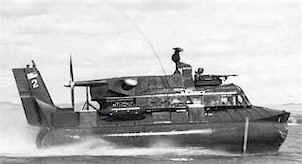
The PACVs were to be operated in high speeds (70 kn) in the marshes and canals of Viet Nam, their employment was accompanied however with a high noise generation because of the gas turbines. Also to high mechanical maintenance and upkeep were required. Compared with the PBRs (Patrol Boat River) the air cushion vehicles were more expensive to operate and maintain.
In July of 1965, the US Navy bought three
hovercrafts SR-N5
model 7232 of Bell Aerosystems Company. They were imported boats of the
British Hovercraft Corporations and had been modified with shield and a machine
gun rack, and changed the engine for a T-58 turbine of General Electric who
developed 1300 HP and the radar for an American model.
In 1965, hovercrafts had been assigned by the US Navy as PACV (Patrol Air
Cushion Vehicle). Extensively search missions of and destruction in lands of the
Delta of the River Mekong 1966 had been used by the TF-116 in the 1967 in
division PACV 107.
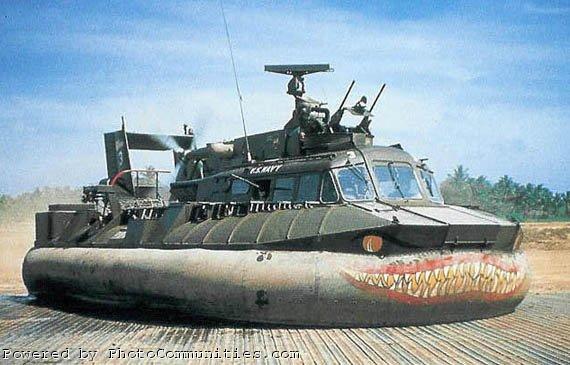
The US Navy operated seven PACV (Patrol Air Cushion Vehicle) in the Vietnam. The TF-116 used three between 1966-1967.
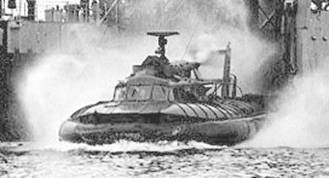
The fast PACV were easily operated in plain canals and quagmires, passing easily
for obstacles and on land. However, they were too sophisticated for the marginal
operations. For using aviation technology they were expensive and difficult to
keep-up. They consumed fuel in extreme amounts.
These models 7232 could develop 52 we and carry 17 equipped combatants. The costs of maintenance of the 7232 were similar to the one of a jet aircraft. The price of each hovercraft was in an excess of a million dollars each. In 1967 the US Navy modified these extensively hovercrafts endowing with decks straight (the previous ones were rounded off), the improved skirts, greater has storage of fuel and a brought up to date engine.

In 1968 they had been transferred to the coastal area of DaNang. Later they had been refitted for the Coast Guard use in San Francisco.
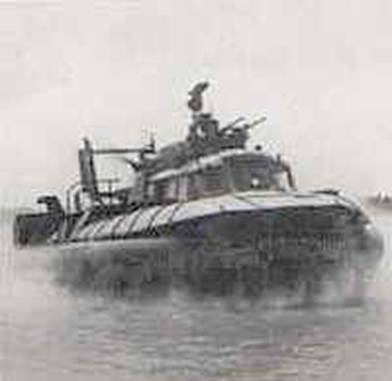
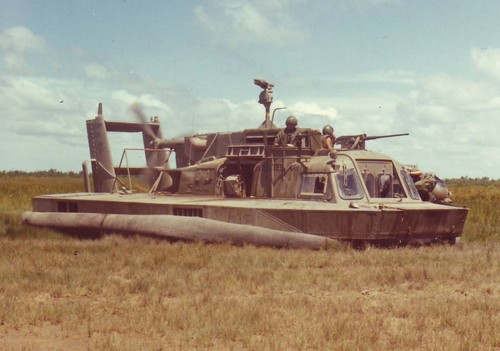
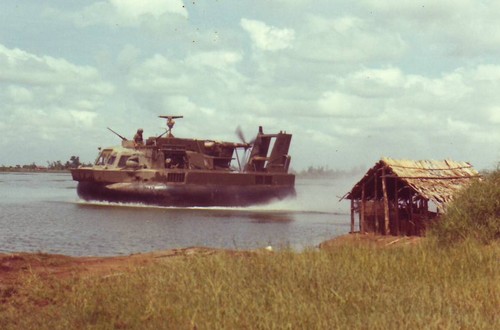



On 10 June, two PACVs moved to USS Tortuga (LSD 26) for assessment during GAME WARDEN operations in the Mekong Delta. These operations included transits to and from the base at Cat Lo until 29 June, when the PACVs returned to Cat Lo to undergo modifications.
A story by Mike Wilson - Being a Machinist mate, I was in the Starboard engine and pump room and didn’t get to see daylight much!
These things were big and noisy.
We would drop the tailgate and ballast down (ballast detail in the pump rooms) so the hovercraft could come into the “dry” well deck (not flooded). Deck crew tried to work the hovercraft into position like a boat (lines to cleats). The deck crew would call out, for example, white cleat to red cleat and green to yellow etc. It sure took a long time. Once because of a coming storm, they just got a bunch of men to push the hovercraft into position without using the lines. A lot faster and saved time. I don’t think anyone of the deck crew could hear afterwards for days as a result!
Deploying the two craft in the well-deck of the USS Tortuga LSD-26. The ship was positioned several miles off the coast near the mouths of rivers. Then at night we would launch one or two of the PACV's from the well-deck which would then proceed toward the coast and take up a position from which to conduct surveillance. Upon completion of the patrol, the craft would return and dock inside the LSD.

PAVC DIV 107
OPTEV 1965-1967
LT Kenneth Luenser, Division Commander
LT Michael Vincent, OIC, Asst. Division Commander
LTjg Roy E. Adair, OIC, Division Operations Officer
LTjg William McCollum, OIC, Division Admin Officer
LTjg Kipton Kumler, OIC, Division Maintenance Office
LTjg Thomas Graves, OIC Division Material Officer
CREW 2
LTjg Tom Graves, OIC
RD2 Roy Nunez, Navigator/radar operator
GM2 Jim Dixon, Gunner
EN2 Bruce Van Tiger, Engineer
CREW 3
LTjg Roy Adair, OIC
RD1 Jimmy Akin, Navigator/radar operator
GM1 Everett Surdez, Gunner
MR1 Chuck Gilbert, Engineer
PACV's of COSDIV 17 arrived at Vung Tau on 4 December and flew to Dong Tam the same day without incident. Delta operation and shakedown training was commenced 8 December at Dong Tam.
In their first operational employment on 29 December, two PACV's of TG-117-4 inserted infantry squads into the operational area. Although the troops were successfully lifted to their destination, both PACV's experienced mechanical and/or electrical difficulties which resulted in one of the vehicles being air lifted back to Dong Tam by a "Flying Crane" helicopter.
The U.S. Army Air Cushioned Vehicles assigned to the 3rd/Bde of the 9th U.S. Inf Div staged out of NSA Ben Luc and conducted joint ops in and around the Ben Luc, Tan An, Thu Thua areas and up the Bo Bo Canal, long known to be a major VC infiltration route.


“Pictures of the Hovercraft operating from the USS Tortuga LSD-26 in 1966.”

Picture from John Lamb.
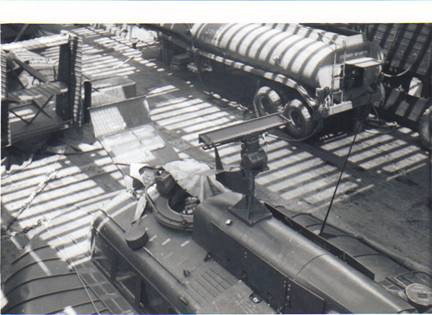
Picture from John Lamb.

Picture by Mike Wilson MM2 USS TORTUGA
The craft and personnel that patrolled the rivers
Patrol Boats River
The
significant strategic and economic importance of South Vietnam’s extensive
inland waterways made it clear from the beginning of the war that the Navy would
be in the front rank of the allied forces laced by 3,000 nautical miles of
rivers, canals, and smaller streams. The fertile Mekong Delta south of Saigon,
where the largest segment of South Vietnam’s population lived, constituted the
country’s rice bowl. Northward along the coast to the DMZ, sizable rivers
stretched inland past vital population centers such as Hue. Throughout the
country the road and rail system was rudimentary while the waterways provided
ready access to the most important resources. The side that controlled the
rivers and canals controlled the Heart of South Vietnam. 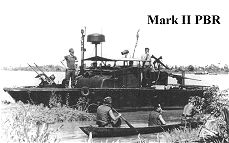 U.S. naval leaders were determined that allied forces would command these
waterways when they established the River Patrol Force on 18 December 1965. From
then until March 1966 the Navy procured river patrol boats (PBR) in the United
States, prepared the crews at the Coronado and Mare Island, CA training centers,
and deployed the units to Southeast Asia for operation Gamewarden. On March
1966, the River Patrol Force was designated River Patrol Squadron 5 for
administrative purposes. By 31 August 1968, the force consisted of five river
divisions, each controlling two 10-boat sections that operated from combat bases
along the major rivers or from ships positioned in the rivers. The Navy
reconditioned a number of ships (LSDs and LSTs) so they could serve as floating
base facilities for a PBR section together with a helicopter detachment located
at each support area.
U.S. naval leaders were determined that allied forces would command these
waterways when they established the River Patrol Force on 18 December 1965. From
then until March 1966 the Navy procured river patrol boats (PBR) in the United
States, prepared the crews at the Coronado and Mare Island, CA training centers,
and deployed the units to Southeast Asia for operation Gamewarden. On March
1966, the River Patrol Force was designated River Patrol Squadron 5 for
administrative purposes. By 31 August 1968, the force consisted of five river
divisions, each controlling two 10-boat sections that operated from combat bases
along the major rivers or from ships positioned in the rivers. The Navy
reconditioned a number of ships (LSDs and LSTs) so they could serve as floating
base facilities for a PBR section together with a helicopter detachment located
at each support area.
River Patrol Force Dispositions
River
Division 51 Can Tho / Binh Thuy
River Division 52 Sa Dec and Vinh Long
River Division 53 My Tho
River Division 54 Nha Be River
River Division 55 Danang
|
Support Ships 1966 |
|
Support Ships 1967-1968 |
|
Belle Grove (LSD-2) |
|
Garrett County (LST-786) |
|
Comstock (LSD-19) |
|
Harnett County (LST-821) |
|
Tortuga (LSD-26) |
|
Hunterdon County (LST-838) |
|
Floyd County (LST-762) |
|
Jennings County (LST- 846) |
|
Jennings County (LST-846) |
|
|
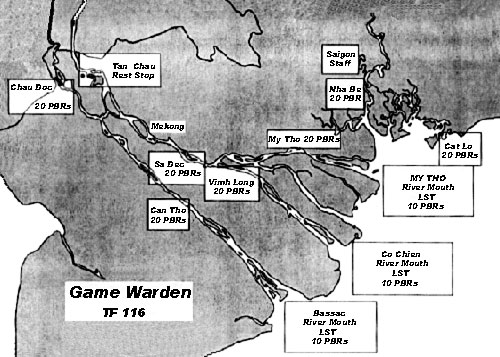


The PBR was the ubiquitous workhorse of the River Patrol Force. They were manned by a crew of four bluejackets, equipped with a pathfinder surface radar, two radios, and commonly armed with two twin mounted .50 caliber machine guns forward, M-60 machine guns (or a grenade launcher) port and starboard amidships, and a .50 caliber aft. Mark I's, the initial version of the PBR, performed well in the river patrol operations but were plagued with continual fouling of the water-jet engines by weeds and other detritus. When going alongside Vietnamese sampans for inspection, the fragil fiberglass hulls of the PBR were often damaged. New Mark II's versions of the craft, first deployed to the delta in Dec 1966, brought improved Jacuzzi jet pumps, which reduced fouling and increased speed from 25 to 29 knots, and were equiped with more durable aluminum gunwales.
Seawolf Helicopters
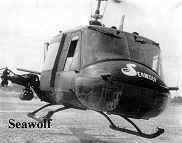 A
key component of the Game Warden operation was it’s air support element.
The Navy's Helicopter Attack Squadron (Light) Three or HA(L)-3 for short was
also known as the Seawolves. It was the Navy's only attack helicopter squadron
ever. It operated exclusively in the Mekong Delta in nine, two-aircraft
detachments. The detachments operated from ships in the rivers and off the
coasts and from airfields and makeshift camps throughout the Delta. The squadron
was established "in country" to provide rapid response air support to the Brown
Water Navy but, as it turned out, engaged in air support of any friendly outfit
that called for help. A significant part of their time was spent inserting and
extracting Navy SEALs, often under heavy fire.
A
key component of the Game Warden operation was it’s air support element.
The Navy's Helicopter Attack Squadron (Light) Three or HA(L)-3 for short was
also known as the Seawolves. It was the Navy's only attack helicopter squadron
ever. It operated exclusively in the Mekong Delta in nine, two-aircraft
detachments. The detachments operated from ships in the rivers and off the
coasts and from airfields and makeshift camps throughout the Delta. The squadron
was established "in country" to provide rapid response air support to the Brown
Water Navy but, as it turned out, engaged in air support of any friendly outfit
that called for help. A significant part of their time was spent inserting and
extracting Navy SEALs, often under heavy fire.
Initially the Army deployed detachments of two Bell UH-1B Iroquois helicopters and their crews to PBR bases and river-based LSDs& LSTs. The Navy had no attack helicopters or trained attack helicopter pilots or gunners at the beginning of the Vietnam War and had to borrow UH-1Bs from the Army. While Navy helicopter pilots were given Huey training by the Army in the U.S., that service was also temporarily tasked to form a unit to fly from Navy ships in support of the river patrol forces. It was under the command of Army Captain Duane R. Brofer. He and Army Warrant Officer David Anderson came up with the name Sea Wolves (two words). They flew from the Belle Grove (LSD-2) and the Tortuga (LSD-26).
Beginning in April 1966, however, aircrews from the Navy’s Helicopter Support Squadron 1 replaced the Army personnel. Then on 1 April 1967, the Navy activated Helicopter Attack Light Squadron (HAL) 3 at Vung Tau with responsibility for providing Task Force 116 with aerial fire support, observation , and medical evacuation. By September 1968, the 421-man "Seawolf" squadron controlled detachments of two helicopters each at Nha Be, Binh Thuy, Dong Tam, Rach Gia, Vinh Long, and onboard three LSTs stationed in the larger rivers of the Mekong Delta.
The UH-1B "Hueys" armed variously with 2.75 inch rockets; .50 caliber, 60 millimeter, and 7.62-millimeter machine guns; grenades, and small arms, were a powerful and mobile complement to the Game Warden surface units.
SEAL Operations
|
|
|
The River Patrol Force commanders also led other naval forces, including the highly trained and skilled SEALs. By mid-1968 the 211-man Seal Team 1, based at Coronado, fielded twelve 14-man platoons, each composed of two squads, generally four or five of the platoons at any given time were deployed to South Vietnam, where one or two of them served with the special operations force in Danang and another three operated out of Nha Be as Detachment GOLF in support of the TF-116 campaign in the Rung Sat Special Zone. |
Beginning in early 1967, the Atlantic SEAL Team 2 provided another three platoons, two of which were stationed with the Game Warden units at Can Tho. These units launched SEAL Operations in the central delta area. Although focused primarily on the areas south and west of Saigon, the SEALs also mounted operations in the I and 11 Corps Tactical zones.
|
These elite Naval Commando units carried out hit and run raids, day and night ambushes, reconnaissance patrols and other special intelligence operations. Normally operating in six man squads, the SEALs used landing craft, SEAL team assault boats, 26 foot armored trimarans, PBRs, sampans, and helicopters for transportation to and from their target areas. Mobile, versatile, and extremely effective in their dangerous work, the SEALs were a very valuable fighting force employed in the riverine environment of Vietnam. |
|
|
Air Cushion Vehicles
|
|
|
In addition to the PBR patrol craft, there were also a total of seven Patrol Air Cushion Vehicles (PACV's) sent to Vietnam on an experimental basis. Task Force 116 employed three of these craft. They were operated in the Mekong Delta as PACV Division 107. PACV's were first deployed in 1966, brought back to the U.S., reworked, and then redeployed back to Viet Nam in late 1967. |
During 1968 there were three separate PACV's deployed by the Army. They deployed to the Dong Tam area to work with the U.S. 9th Division.
Although able to move with great speed over shallow marshy areas, such as the Plain of Reeds, the PACVs proved to be too noisy and too mechanically sophisticated for riverine warfare in South Vietnam. The three Navy PACV's were finally turned over to the Coast Guard in San Francisco.
Mine Sweepers
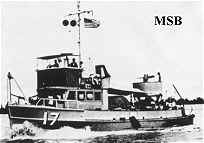 Mine
clearing forces also were essential to the security of Vietnams waterways.
Nowhere was this more crucial than on the rivers near Saigon, the country's most
vital port. Viet Cong mining of the main channel, the Long Tau River, which
wound its way through the Rung Sat Special Zone south of the capital, could have
had a devastating effect on the war effort. Consequently on 20 May 1966, the
Navy established Mine Squadron 11 Alpha (Mine Division 112 after May 1968) at
Nha Be, under command of TF-116 until mid-1968. The minesweeping boats (MSB)
were reactivated in the United States and shipped to South Vietnam. The 56 foot
wooden hulled vessels were armed with machine guns and grenade launchers and
carried surface radar's and minesweeping gear for clearing explosives from the
key waterways, The Navy also deployed three-boat subordinate units to Danang and
Cam Rahn Bay. Detachment Alpha’s strength increased in July 1967 when the first
of six mechanized landing craft {LCM(M)} that were specially configured to sweep
mines arrived at Nha Be.
Mine
clearing forces also were essential to the security of Vietnams waterways.
Nowhere was this more crucial than on the rivers near Saigon, the country's most
vital port. Viet Cong mining of the main channel, the Long Tau River, which
wound its way through the Rung Sat Special Zone south of the capital, could have
had a devastating effect on the war effort. Consequently on 20 May 1966, the
Navy established Mine Squadron 11 Alpha (Mine Division 112 after May 1968) at
Nha Be, under command of TF-116 until mid-1968. The minesweeping boats (MSB)
were reactivated in the United States and shipped to South Vietnam. The 56 foot
wooden hulled vessels were armed with machine guns and grenade launchers and
carried surface radar's and minesweeping gear for clearing explosives from the
key waterways, The Navy also deployed three-boat subordinate units to Danang and
Cam Rahn Bay. Detachment Alpha’s strength increased in July 1967 when the first
of six mechanized landing craft {LCM(M)} that were specially configured to sweep
mines arrived at Nha Be.
Gamewarden Operations 1966 thru 1968
Game Warden operations got underway in early 1966. Naval leaders set out to secure the vital water passages through out the Rung Sat and to establish patrols on the large Mekong Delta rivers. On these latter waterways, the Viet Cong transported arms and supplies brought in from Cambodia, shifted guerrilla units, and taxed the population. The navy created two separate task groups to direct operations in the respective areas.
On 26 March 1966 U.S. Navy, U.S. Marines and South Vietnamese forces kicked off operation Jack-Stay, the war’s first major action in the Rung Sat. PBR units (including one secection from Tortuga), minesweeping boats from Nha Be, SEALs, and helicopters operated together to sweep the area. At the end of the 12 day effort, the allies had killed or captured 69 of the enemy, destroyed Viet Cong supply bases, training sites; and other logistical facilities; and at least for a time, restricted enemy movement in the zone.
 The
enemy, however remained a potent threat. In one month, August 1966, Viet Cong
mines in the Long Tau heavily damaged SS Baton Rouge Victory, a Vietnamese Navy
motor launch minesweeper, and MSB-54. In November, a Viet Cong mine sank MSB-54
and on the last day of the Year American forces discovered a Soviet made contact
mine in the shipping channel. The American and South Vietnamese intensified
minesweeping operations and the enemy continued to fight back. In February 1967
Communist recoilless rifle fire and mines destroyed MSB-45 and heavily damaged
MSB-49.
The
enemy, however remained a potent threat. In one month, August 1966, Viet Cong
mines in the Long Tau heavily damaged SS Baton Rouge Victory, a Vietnamese Navy
motor launch minesweeper, and MSB-54. In November, a Viet Cong mine sank MSB-54
and on the last day of the Year American forces discovered a Soviet made contact
mine in the shipping channel. The American and South Vietnamese intensified
minesweeping operations and the enemy continued to fight back. In February 1967
Communist recoilless rifle fire and mines destroyed MSB-45 and heavily damaged
MSB-49.
By the spring of 1967 the Rapid build up of allied forces in the Rung Sat area, the refinement of tactics, and improvement of weapon systems began to reduce enemy effectiveness. During the year the Vietnamese Regional Force and the U.S. Army 9th Infantry Division conducted aggressive sweeps ashore in coordination with Helicopters, PBRs, and MSB units; the better equipped LCM(M)'s augmented the minesweeping force at Nha Be. SEAL's began sowing mines throughout enemy-held areas, and both PBR's and MSB's added rapid fire, 40-millimeter grenade launchers to their armament from mid-1967 to mid 1968. The Viet Cong continued to ambush shipping on the Long Tau with mines, 122 millimeter rockets, rocket propelled grenades, recoilless rifles, machine guns, and small arms. Quick response by allied reaction forces, however, often cut short these assaults. Ship damage and personnel casualties were relatively light. Other attacks never occurred because of PBR and SEAL patrols upsetting enemy plans, and the MSB's and LCM(M)'s sweeping of mines. Consequently, the communists were unable to sever the vital lifeline to Saigon, even when their forces were fighting for survival during TET and post-Tet battles of 1968.
Game Warden operations in the central reaches of the Mekong Delta began on 8 May 1966, when PBR section 511 of River Division 51 at Can Tho patrolled a stretch of the Bassac River. Soon afterwards other units initiated surveillance of the upper Mekong and the My Tho, Ham Luong, and Co Chien arms of the mighty river that emptied into the South China Sea.
In the two boat random patrols TF-116 sailors checked the cargo and identity papers of junks and sampans plying the waterways, set up night ambushes at suspected enemy crossing points, supported the SEAL's with gunfire and transportation, and enforced curfew restrictions in their sector, usually no more then 35 nautical miles from the base.
Game Warden operations in the central delta registered only modest success from 1966-1968. These events foreshadowed a busy and dangerous year for Game Warden sailors who boarded over 40,000 vessels and inspected them for enemy personnel and contraband. In the process, the River Patrol Force destroyed, damaged, or captured 2,000 Viet Cong craft and killed, wounded, or captured over 1,400 of the enemy. The U.S. Navy suffered the loss of 39 officers and men killed, 366 wounded, and 9 missing in Battle.
The Tet offensive of 1968 fully engaged Task Force 116. Because of the firepower and mobility the PBR's stiffened the defense of the numerous delta cities and towns that were under siege by the enemy. The River patrol boat units were key elements in the successful allied stands at My Tho, Ben Tre, Chau Doc, Tra Vinh, and Can Tho. The enemy prevailed only at Vinh Long, where the Viet Cong overran the PBR base forcing the defenders to withdraw to the Garrett County (LST-786), despite this and a few other temporary setbacks, TF-116 reestablished firm control of the major delta rivers by mid-year and helped cut short the Viet Cong attack on Saigon.
 River
Sailors also gave critical support to allied forces fighting to contain the
enemy surge in I Corps. From September to October 1967, River Section 521 and
Hunterdon County deployed to the river area south of Danang and to Cau Hai Bay
near Hue. PBR units operated permanently in the northern reaches of South
Vietnam after 24 February 1968, when COMNAVFORV established Task Force
Clearwater, under the operational control of Commanding General III Marine
Amphibious Force. The Mission of the task force was to secure the Perfume River
which gave access to Hue from the sea and then Cua Viet. The Task Force eased
supply efforts to American forces arrayed along the DMZ and holding the besieged
outpost at Khe Sanh.
River
Sailors also gave critical support to allied forces fighting to contain the
enemy surge in I Corps. From September to October 1967, River Section 521 and
Hunterdon County deployed to the river area south of Danang and to Cau Hai Bay
near Hue. PBR units operated permanently in the northern reaches of South
Vietnam after 24 February 1968, when COMNAVFORV established Task Force
Clearwater, under the operational control of Commanding General III Marine
Amphibious Force. The Mission of the task force was to secure the Perfume River
which gave access to Hue from the sea and then Cua Viet. The Task Force eased
supply efforts to American forces arrayed along the DMZ and holding the besieged
outpost at Khe Sanh.
Task Force Clearwater headquarters was established on Mobile Base II, a floating barge complex stationed first at Tan My and later at Cua Viet. Because heavily armed North Vietnamese Army units were present in the region, COMNAVFORV strengthened the 20-boat PBR task force with monitors, armored troop carriers, PACVs, landing craft, and minesweepers. Task Force Clearwater could also call on helicopters, attack aircraft, artillery, naval gunfire, and ground troops support from other units in I corps region. Convoys bristling with weaponry were required to maintain the line of communication with forward combat units. The naval forces carried out equally vital minesweeping and patrolling operations. During 1968, Task Force Clearwater’s support was crucial to the successful defense of Khe Sanh, the recapture of Hue, and the defeat of the enemy offensive in I Corps.
Tortuga then returned to the west coast—via Yokosuka, Buckner Bay, Subic Bay, Hong Kong, and Pearl Harbor—and arrived at Long Beach on 9 March 1968. For the, remainder of the year, the landing ship conducted exercises and local operations put of Long Beach, until again deploying to WestPac in 30 January 1969, departing San Diego in company with Paul Revere (LPA-248), Belle Grove (LSD-2), Alamo (LSD-33), Cook (APD-130), Tulare(LKA-112), and Valley Forge (LPH-8), bound, via Pearl Harbor and Okinawa, for Southeast Asia.
On 17 February, while en route to Yokosuka, Tortuga conducted her first underway refueling—with Cook (LPR-130)—receiving 31,000 gallons of Navy Special Fuel Oil (NSFO). Upon arrival at Yokosuka, Tortuga's in-port time was extended to allow the on-loading of a complete destroyer radar system for transport to Subic Bay. Underway on 11 March with her special cargo, the landing ship soon reached Subic Bay, unloaded, and proceeded for Kaohsiung, Taiwan, en route to South Vietnam.
On the last leg of her Vietnam-bound voyage, Tortuga instituted a stepped-up shipboard defense program consisting of daily general quarters drills, exercising especially with the ship's guns and in damage control problems—for the ship had received intelligence reports that a Viet Cong rocket attack was expected to coincide with her arrival at Danang. When paraflares were sighted on the horizon at 0200 on 14 March, Tortuga knew that she had arrived at her destination and went to general quarters. The expected attack failed to materialize, though, and Tortuga unloaded her cargo unmolested but at piers which, only the day before, had been rocketed by the Viet Cong. When the offloading was completed, Tortuga shifted her berth far away from most of the shipping in the harbor. There, boat crews bent to the task of loading old ammunition on the ship. Meanwhile, one boat crew, composed of one officer and five enlisted men, armed with rifles and Thompson submachine guns, kept a constant vigil in an LCVP which circled the ship at a distance of 60-70 yards. Periodically, at odd intervals, the boat's crew would drop percussion grenades in the water in an effort calculated to discourage enemy frogmen. When the task was completed, the ship got underway for the Philippines.
Reaching Subic Bay after an uneventful passage, the ship unloaded the explosives and soon received orders to transport a much-needed suction dredge up the Saigon River to Nha Be, through territory largely controlled by the Viet Cong. At Tan My, Tortuga embarked the dredge and a warping tug and got underway. During the transit of the Saigon River, the landing ship stood to general quarters, keeping a sharp eye for enemy attempts to impede the progress of the ship. The enemy failed to appear, however, and Tortuga, her dredge, and her tug arrived at Nha Be soon thereafter.
From 5 to 20 May, Tortuga participated in "Daring Rebel," an operation mounted to seek out and destroy Viet Cong rest camps on Barrier Island, 15 miles south of Danang. As a member of Ready Group Alfa. Operating with the DULUTH (LSD-6), WINSTON (LKA-97), USS OKINAWA, USS FORT MARION, and USS WHETSTONE, landed and sustained a Marine Amphibious Force, Tortuga closed the beachhead, while White River (LSMR-536) stood offshore to provide initial bombardment. When White River launched a heavy rocket barrage shoreward, "Daring Rebel" got underway. Landing craft splashed ashore while troop-carrying helicopters quickly airlifted troops ashore in the vertical-envelopment phase of the operation. For the next two weeks, Tortuga served as primary control ship for the operation which located and destroyed caches of food and ammunition and Viet Cong rest camps. Throughout the operation, Tortuga operated as primary control ship for all landing craft, regulating all traffic between the ships and the beach. From sunrise till sunset and frequently to the next sunrise, Tortuga worked to keep the troops on the beach supplied. Tortuga did such a fine job throughout the
operation that she was cited by Commodore Stroud for, "great performance
demonstrated while acting as primary control ship in operation”.
"Backed by the ship's guns, the landing craft charge the
beach"
"OPERATION DARING REBEL"

The landing ship again served as primary control ship (PCS) in Danang harbor during "Gallant Leader," a follow-up to "Daring Rebel." Relieved by Duluth on 23 May, Tortuga set sail soon thereafter for Buckner Bay and simulated combat landings during exercises with Assault Craft Unit 1 in late June. In July, Tortuga transported the first increment of marines and their equipment for "Keystone Eagle," from Cua Vet, South Vietnam, to White Beach, Okinawa, before returning up the Saigon River to Nha Be with a load of palletized cargo.
Subsequently supporting Operation "Sea Float," delivering two pontoons and 32 pallets of ammunition from Nah Be to Tan My, Tortuga onloaded men and equipment from "Charlie" Battery, 1st Light Antiaircraft Missile Battalion (LAAM), First Marine Air Wing, at Danang harbor for transport to the west coast of the United States. In this last operation, the second increment of "Keystone Eagle," Tortuga headed "stateside" for the last time, and arrived at Seal Beach, Calif., on 12 September 1969, unloading the 58 Hawk missiles of the 1st LAAM Battalion, USMC, and then proceeding to the Long Beach Naval Shipyard.
Tortuga disembarked her marines and proceeded to pier 7 where she was moored outboard of Carter Hall (LSD-3).
· During the Vietnam War Tortuga (LSD-26) participated in the following campaigns:
|
|
|
|
Campaigns and Dates |
Campaigns and Dates |
|
Vietnam Defense
|
Tet Counteroffensive
|
|
Vietnam Counteroffensive
|
Tet69/Counteroffensive
|
|
Vietnam Counteroffensive - Phase II
|
Vietnam Summer-Fall 1969
|
|
Vietnam Counteroffensive - Phase III
|
. |
|
Cited Unit |
Merit Start |
Merit End |
Award |
Campaign |
|
TORTUGA LSD 26 |
09-Aug-1964 |
28-Sep-1964 |
AE |
- |
|
TORTUGA LSD 26 |
04-Jun-1965 |
09-Jun-1965 |
AE |
- |
|
TORTUGA LSD 26 |
07-Jul-1965 |
09-Jul-1965 |
VS |
- |
|
TORTUGA LSD 26 |
16-Apr-1966 |
15-Sep-1966 |
VS |
- |
|
TORTUGA LSD 26 |
05-Sep-1967 |
28-Sep-1967 |
VS |
- |
|
TORTUGA LSD 26 |
17-Sep-1967 |
27-Sep-1967 |
RG |
- |
|
TORTUGA LSD 26 |
06-Oct-1967 |
09-Nov-1967 |
RG |
- |
|
TORTUGA LSD 26 |
06-Oct-1967 |
12-Nov-1967 |
VS |
- |
|
TORTUGA LSD 26 |
19-Nov-1967 |
23-Nov-1967 |
RG |
- |
|
TORTUGA LSD 26 |
19-Nov-1967 |
23-Nov-1967 |
VS |
- |
|
TORTUGA LSD 26 |
01-Dec-1967 |
02-Dec-1967 |
RG |
- |
|
TORTUGA LSD 26 |
01-Dec-1967 |
05-Dec-1967 |
VS |
- |
|
TORTUGA LSD 26 |
11-Dec-1967 |
17-Dec-1967 |
VS |
- |
|
TORTUGA LSD 26 |
27-Dec-1967 |
31-Dec-1967 |
VS |
- |
|
TORTUGA LSD 26 |
30-Jan-1968 |
31-Jan-1968 |
RG |
- |
|
TORTUGA LSD 26 |
30-Jan-1968 |
02-Feb-1968 |
VS |
- |
|
TORTUGA LSD 26 |
12-Mar-1969 |
16-Mar-1969 |
VS |
- |
|
TORTUGA LSD 26 |
14-Mar-1969 |
- |
RG |
- |
|
TORTUGA LSD 26 |
23-Mar-1969 |
03-Apr-1969 |
VS |
- |
|
TORTUGA LSD 26 |
15-Apr-1969 |
20-Apr-1969 |
VS |
- |
|
TORTUGA LSD 26 |
23-Apr-1969 |
28-May-1969 |
VS |
- |
|
TORTUGA LSD 26 |
05-May-1969 |
20-May-1969 |
NU |
- |
|
TORTUGA LSD 26 |
30-Jun-1969 |
04-Jul-1969 |
VS |
- |
|
TORTUGA LSD 26 |
13-Jul-1969 |
21-Jul-1969 |
VS |
- |
|
TORTUGA LSD 26 |
07-Aug-1969 |
10-Aug-1969 |
VS |
- |
|
TORTUGA LSD 26 |
12-Aug-1969 |
16-Aug-1969 |
VS |
- |
NU – Naval Unit Citation
RG – Republic of Vietnam Meritorious Unit Citation (Gallantry Cross Medal Color with Palm)
VS – Viet Nam Service Medal
AE - Armed Forces Expeditionary
Vietnam Service 1962-1973
From the time that United States' assistance to the Republic of South Vietnam was confined to an advisory status through the period of major combat actions, the varied and extensive roles of the U.S. Navy were crucial to the overall military effort in Southeast Asia.
After early participation by the U.S. Seventh Fleet in the detection of infiltration by sea from the north, a Coastal Surveillance Force, MARKET TIME., conducted inshore operations as well as offshore patrols to augment the efforts of the Vietnamese Navy.
Mobility and the endurance sustained by underway replenishment forces resulted in maximum use of Seventh Fleet carriers for retaliatory raids, for strikes in support of troops ashore, and for attacks against the enemy lines of communication. Naval air operations were of particular importance in the days before adequate airfields could be built ashore, and the ability of task forces to operate in nearby Tonkin Gulf permitted effective and efficient air operations against targets in North Vietnam.
The Amphibious Force of the Seventh Fleet projected ashore the first organized ground forces, U.S. Marines, at DaNang in March 1965, and carried out many later landings. Destroyers, cruisers, and battleship New Jersey added the weight of their gunfire in support of forces ashore, and conducted operations against the logistic lines of the enemy along the coast of North Vietnam.
The Amphibious Command drew upon its Underwater Demolition Team capability to develop SEAL (Sea, Air, Land) Teams, which conducted operations against Viet Cong guerrillas. The River Patrol Force, GAME WARDEN, extended the control of waterways in the Mekong Delta and other areas of the Republic. The joint Navy-Army operations of the Mobile Riverine Force captured base areas and defeated enemy concentrations.
Elements of the Coastal Surveillance, River Patrol, and Mobile Riverine Forces were combined into operation SEA LORDS to interdict infiltration routes from Cambodia into the Mekong Delta, to control vital Delta waterways, and to harass the enemy in his base areas. Essential support to in country forces was provided by the Service Force's naval support activities and Seabees.
Sea lines of logistics were a key to the defense of the northern provinces. The valiant naval medical personnel with the Marines, in hospitals and in hospital ships, saved lives and healed the wounded with unprecedented success. Salvage forces recovered ships in distress and cleared waterways. From across the seas came the vast quantity of supplies required to fight this major war. Ships under the Navy’s Military Sealift Command delivered all but a small percentage of the tonnage.
After years of negotiations from 1968 to 1973, the Paris Agreement of January
1973 between the U.S., South Vietnam, North Vietnam, and the National Liberation
Front provided that the prisoners of war would be returned and that the North
Vietnam military and all U.S. military personnel had to be out of South Vietnam
by 29 March 1973, except for U. S. embassy personnel. The eligibility for this
medal ended on 28 March 1973.
3 Silver and 2 Bronze Stars
1. Vietnam Advisory Campaign (15 March 1962- 7 March 1965)
2. Vietnam Defense Campaign (8 March-24 December 1965)
3. Vietnamese Counteroffensive (25 December 1965- 30 June 1966)
4. Vietnamese Counteroffensive (1 July 1966-31 May 1967) Phase II
5. Vietnamese Counteroffensive (1 June 1967-29 January 1968) Phase III
6. Tet Counteroffensive (30 January-l April 1968)
7. Vietnamese Counteroffensive (2 April-30 June 1968) Phase IV
8. Vietnamese Counteroffensive (1 July-l November 1969) Phase V
9. Vietnamese Counteroffensive (2 November 1968- 22 February 1969) Phase VI
10. Tet 69/Counteroffensive (23 February-8 June 1969)
11. Vietnam Summer-Fall 1969 (9 June-31 October 1969)
12. Vietnam Winter-Spring 1970 (1 November 1969-30 April 1970)
13. Sanctuary Counteroffensive (1 May-30 June 1970)
14. Vietnamese Counteroffensive (l July 1970-30 June1971) Phase VII
15. Consolidation I (1 Jul 1971 - 30 Nov 1971)
16. Consolidation II (1 Dec 1971 - 29 Mar 1972)
17. Vietnam Ceasefire Campaign (30 Mar 1972 - 28 Jan 1973)
All statistics are taken from the book: By Sea, Air and Land
written by Edward J. Marolda
IN UNIFORM AND IN COUNTRY
· Vietnam Veterans: 9.7% of their generation.
· 9,087,000 military personnel served on active duty during the Vietnam era (August 5, 1964 - May 7, 1975).
· 8,744,000 GIs were on active duty during the war (August 5, 1964 - March 28, 1973).
· 3,403,100 (including 514,300 offshore) personnel served in the Southeast Asia Theater (Vietnam, Laos, Cambodia, flight crews based in Thailand, and sailors in adjacent South China Sea waters). 2,594,000 personnel served within the borders of South Vietnam (January 1, 1965 - March 28, 1973).
· Another 50,000 men served in Vietnam between 1960 and 1964.
· Of the 2,6 million, between 1 - 1,6 million (40 - 60%) either fought in combat, provided close support or were at least fairly regularly exposed to enemy attack.
· 7,484 women (6,250 or 83.5% were nurses) served in Vietnam.
· Peak troop strength in Vietnam: 543,482 (April 30, 1969).
CASUALTIES
· Hostile deaths: 47,359.
· Non-hostile deaths: 10,797.
· Total: 58,202 (includes men formerly classified as MIA and Mayaguez casualties). Men who have subsequently died of wounds account for the changing total.
· 8 nurses died - 1 was KIA.
· Married men killed: 17,539.
· 61% of the men killed were 21 or younger.
· Highest state death rate: West Virginia - 84.1% (national average 58.9% for every 100,000 males in 1970).
· Wounded: 303,704 (153,329 hospitalized + 150,375 injured requiring no hospital care).
· Severely disabled: 75,000--23,214 100% disabled; 5,283 lost limbs; 1,081 sustained multiple amputations. Amputation or crippling wounds to the lower extremities were 300% higher than in WWII and 70% higher than in Korea. Multiple amputations occurred at the rate of 18.4% compared to 5.7% in WWII
· Missing in Action: 2,338.
· POWs: 766 (114 died in captivity).
DRAFTEES AND VOLUNTEERS
· 25% of the total forces in country were draftees 648,500 as opposed to 66% of the ones in WWII.
· Draftees accounted for 30.4% (17,725) of combat deaths in Vietnam.
· Reservists killed: 5,977.
· National Guard: 6,140 served; 101 died.
· Total draftees (1965-73): 1,728,344.
· Actually served in Vietnam: 38%.
· Marine Corps draft: 42,633.
· Last man drafted: June 30, 1973
RACE AND ETHNIC BACKGROUND
· 88.4% of the men who actually served in Vietnam were Caucasian, 10.6% (275,000) were black; 1% listed as others.
· 86.3% of the men who died in Vietnam were Caucasian (includes Hispanics); 12.5% (7,241) were black; 1.2% belonged to other races.
· 170,000 Hispanics served in Vietnam; 3,070 (5.2% of total) died there.
· 86.8% of the men who were killed as a result of hostile action were Caucasian; 12.1% (5,711)were black; 1.1% belonged to other races
· 14.6% (1.530) of non-combat deaths were among blacks.
· 34% of blacks who enlisted volunteered for the combat arms.
· Overall, blacks suffered 12.5% of the deaths in Vietnam at a time when the percentage of blacks of military age was 13.5% of the total population.
· Religion of Dead: Protestant--64.4%; Catholic--28.9%; other/none--6.7%.
SOCIO-ECONOMIC STATUS
· 76% of the men sent to Vietnam were from lower middle/ working class backgrounds.
· Three-fourths had family incomes above the poverty level; 50% were from middle income backgrounds.
· Some 23% of Vietnam vets had fathers with professional, managerial or technical occupations.
· 79% of the men who served in Vietnam had a high school education or better when they entered the military service. (63% of Korean War vets and only 45% of WWII vets had completed high school upon separation).
· Deaths by region per 100,000 of population: South-31, West-29.9; Midwest-28.4; Northeast-23.5
WINNING & LOSING
· 82% of veterans who saw heavy combat strongly believe the war was lost because of lack of political will
· Nearly 75% of the public agrees it was a failure of political will, not of arms.
HONORABLE SERVICE
· 97% of Vietnam-era veterans were honorably discharged.
· 91% of actual Vietnam War veterans and 90% of those who saw heavy combat are proud to have served their country.
· 66% of Vietnam vets say they would serve again if called upon.
· 87% of the public now holds Vietnam veterans in high esteem.
Vietnam Service Medal
The armed forces' Vietnam Service Medal (at left in photo) was established by Executive Order 11231 from President Johnson's desk on 8 July 1965.

The distinctive design was the creation of sculptor Thomas Hudson Jones, a former employee of the Army's Institute of Heraldry.
The design of the medal's suspension ribbon reflects that of the flag of the former South Vietnam -- yellow with three red stripes. The green trim at the edges is suggestive of the jungle nature of the conflict.
At right in the photo is the Vietnam Campaign Medal, issued to eligible U.S. forces by the then-Republic of South Vietnam.
The service medal was awarded to all members of the armed forces who service in Vietnam and contiguous waters and airspace between 3 July 1965 and 28 March 1973.
In addition, personnel serving in Thailand, Laos or Cambodia in direct support of operations in Vietnam during the same time period also were eligible for the medal.
To qualify for award of the VSM an individual must meet one of the following qualifications:
(1) Be attached to or regularly serve for 1 or more days with an organization participating in or directly supporting military operations.
(2) Be attached to or regularly serve for 1 or more days aboard a Naval vessel directly supporting military operations.
(3) Actually participate as a crewmember in one or more aerial flights into airspace above Vietnam and contiguous waters directly supporting military operations.
(4) Serve on temporary duty for 30 consecutive days or 60 nonconsecutive days in Vietnam or contiguous areas, except that time limit may be waived for personnel participating in actual combat operations.
Executive Order 11231:
Establishing the Vietnam Service Medal
By virtue of the authority vested in me as President of the United States and as Commander in Chief of the armed forces of the United States, it is ordered as follows:
Section 1. There is hereby established the Vietnam Service Medal with suitable appurtenances. Except as limited in section 2 of this order, and under uniform regulations to be prescribed by the Secretaries of the military departments and approved by the Secretary of Defense, or regulations to be prescribed by the Secretary of Transportation with respect to the Coast Guard when it is not operating as a service in the Navy, the Vietnam Service Medal shall be awarded to members of the armed forces who serve in Vietnam or contiguous waters or air space, as defined by such regulations, after July 3, 1965, and before a terminal date to be prescribed by the Secretary of Defense. 1
[Sec. 1 amended by Executive Order 11382 of Nov. 28, 1967, 32 FR 16247, 3 CFR, 1966-1970 Comp., p. 691]
Sec. 2. Notwithstanding section 3 of the Executive Order No. 10977 of December 4, 1961, establishing the Armed Forces Expeditionary Medal, any member who qualified for that medal by reason of service in Vietnam between July 1, 1958, and July 4, 1965, shall remain qualified for that medal. Upon application, any such member may be awarded the Vietnam Service Medal in lieu of the Armed Forces Expeditionary Medal, but no person may be awarded both medals by reason of service in Vietnam and no person shall be entitled to more than one award of the Vietnam Service Medal.
Sec. 3. The Vietnam Service Medal may be awarded posthumously.
Source: The provisions of Executive Order 11231 of July 8, 1965, appear at 30 FR 8665, 3 CFR, 1964-1965 Comp., p. 325, unless otherwise noted.
1. Editorial note: On Jan. 26, 1973, a terminal date of Mar. 28, 1973, was prescribed (DOD Instruction 1348.15).
House Rpt.107-772 - NATIONAL DEFENSE AUTHORIZATION
ACT FOR FISCAL YEAR 2003
SEC. 542. Option to convert award of Armed Forces Expeditionary Medal awarded for Operation Frequent Wind to Vietnam Service Medal.
(a) IN GENERAL- The Secretary of the military department concerned shall, upon the application of an individual who is an eligible Vietnam evacuation veteran, award that individual the Vietnam Service Medal, notwithstanding any otherwise applicable requirements for the award of that medal. Any such award shall be made in lieu of the Armed Forces Expeditionary Medal awarded the individual for participation in Operation Frequent Wind.
(b) ELIGIBLE VIETNAM EVACUATION VETERAN- For purposes of this section, the term `eligible Vietnam evacuation veteran' means a member or former member of the Armed Forces who was awarded the Armed Forces Expeditionary Medal for participation in military operations designated as Operation Frequent Wind arising from the evacuation of Vietnam on April 29 and 30, 1975.
4. Personnel that were awarded the Armed Forces Expeditionary Medal for participating in Operation Frequent Wind from 29-30 April 1975 are now entitled to exchange it for the Vietnam Service Medal per section 542 in public law 107-314. Operation Frequent Wind, 29-30 April 1975, will be reflected as the 18th campaign under the Vietnam Campaign.
A. Commanders are authorized to process requests for personnel under his/her cognizance.
B. Retired and former personnel affected by this law need to submit their requests using form SF180 (http://members.aol.com/forvets/htomr.htm to The National Personnel Records Center (NPRC) by fax to (314) 801-9195 or by mail to:
NATIONAL PERSONNEL RECORDS CENTER
MILITARY PERSONNEL RECORDS
9700 PAGE AVENUE
ST. LOUIS MO 63132
Requests addressed to NPRC must include the following personal information: full name, ssn, service/serial number, branch of service, date of birth, and period of service.
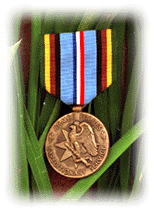
Individuals qualified for the Armed Forces Expeditionary Medal for reason of service in Vietnam between I July 1958 and 3 July 1965 (inclusive) shall remain qualified for that medal. Upon request, any such individual may be awarded the VSM instead of the Armed Forces Expeditionary Medal. No person will be entitled to both awards for Vietnam service.
Vietnam and contiguous waters, as used herein, is defined as an area which includes Vietnam and the water adjacent thereto within the following specified limits: From a point on the East Coast of Vietnam at the juncture of Vietnam with China southeastward to 21 N. Latitude, 108° 15'E. Longitude; thence, southward to 18° N. Latitude, 108° 15'E. Longitude; thence southeastward to 17° 30'N. Latitude, 111° E. Longitude; thence southward to 11° N. Latitude; 111° E. Longitude, thence southwestward to 7° N. Latitude, 105° E. Longitude; thence westward to 7° N. Latitude, 103° E. longitude, thence northward to 9° 30'N. Latitude, 103° E. Longitude, thence northeastward to 10° 15'N. Latitude, 104°
27'E. Longitude, thence northward to a point on the West Coast of Vietnam at the juncture of Vietnam with Cambodia.
There are a total of 17 campaign stars authorized for the Vietnam Service Medal. Personnel are authorized one bronze campaign star for each qualifying campaign with a silver star worn in lieu of five bronze stars.
1. Vietnam Advisory Campaign (15 March 1962- 7
March 1965)
2. Vietnam Defense Campaign (8 March-24 December 1965)
3. Vietnamese Counteroffensive (25 December 1965- 30 June 1966)
4. Vietnamese Counteroffensive (1 July 1966-31 May 1967) Phase II
5. Vietnamese Counteroffensive (1 June 1967-29 January 1968) Phase III
6. Tet Counteroffensive (30 January-l April 1968)
7. Vietnamese Counteroffensive (2 April-30 June 1968) Phase IV
8. Vietnamese Counteroffensive (1 July-l November 1969) Phase V
9. Vietnamese Counteroffensive (2 November 1968- 22 February 1969) Phase VI
10. Tet 69/Counteroffensive (23 February-8 June 1969)
11. Vietnam Summer-Fall 1969 (9 June-31 October 1969)
12. Vietnam Winter-Spring 1970 (1 November 1969-30 April 1970)
13. Sanctuary Counteroffensive (1 May-30 June 1970)
14. Vietnamese Counteroffensive (l July 1970-30 June1971) Phase VII
15. Consolidation I (1 Jul 1971 - 30 Nov 1971)
16. Consolidation II (1 Dec 1971 - 29 Mar 1972)
17. Vietnam Ceasefire Campaign (30 Mar 1972 - 28 Jan 1973)
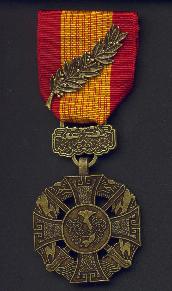
Issue Regulations
Vietnam Cross of Gallantry with Palm
Awarded to All members of the Armed Forces of the United States and other Nations for valorous achievement in combat during the Vietnam conflict, March 1, 1961 through March 28, 1973. The Vietnam Cross of Gallantry is the equivalent of the French Croix de Guerre.
The medal is a symbol of gratitude to the American and Allied soldiers who once worked and fought and sacrificed themselves for the freedom of the Republic of Vietnam.
The Army of South VIETNAM awarded the Vietnamese Cross of Gallantry to both individuals and to units. When awarded to individuals it was awarded with Silver Star (the equivalent to the US Army Silver Star) or with Bronze Star (equivalent to the US Bronze Star). When awarded to units it is awarded on Army Level (Palm), Corps Level (Gold Star), Division Level (Silver Star) and Brigade Level (Bronze laurel leaf or palm). As with US unit awards, all personnel in the unit during the period of action for which the award is given may wear the award at all times. Individuals not in the unit during the designated period wear the award only while assigned to the unit. As a foreign decoration, the Vietnamese Cross may not be worn until the award is approved by the US Department of State. That approval is then passed to the Department of Army and a General Order for the award is published, in this case DA GO 43, 1970.
1. Description: A Gold color medal, 1 3/8 inches in width, consisting of a wreath superimposed by two crossed scimitars saltirewise and a Maltese cross. In the center of the Maltese cross a disc with an outline of the country of Vietnam between two palm sprigs joined at the bottom and a scroll overall inscribed "QUOC-GIA LAO-TUONG" (Reward of the State).
2. Ribbon: The ribbon is 1 3/8 inches wide and consists of the following stripes: 3/8 inch Old Glory Red 67156; center 5/8 inch Golden Yellow 67104 with 16 strands of Old Glory Red; and 3/8 inch Old Glory Red.
3. Criteria:
a. U.S. Military units were individually cited for award of the Republic of Vietnam (RVN) Gallantry Cross; however, the Vietnamese Government issued the award to all units subordinate to Military Assistance Command (MACV) during the period 8 February 1962 and 28 March 1973 and to U.S. Army Vietnam and its subordinate units for the period 20 July 1965 to 28 March 1973. This permits all personnel who served in Vietnam to wear the RVN Gallantry Cross unit citation.
b. The medal was awarded by the Vietnam Government to military personnel who have accomplished deeds of valor or displayed heroic conduct while fighting the enemy and have been cited individually at the regiment, brigade, division, corps, or armed forces level.
4. Components: The following are authorized components of the Republic of Vietnam Gallantry Cross:
a. Medal (regular size): Not issued. Available commercially.
b. Medal (miniature size): Not issued. Available commercially.
c. Ribbon: MIL-R-11589/173. Commercially available.
d. Streamers: Awarded to cited units. Inscription is as indicated on the unit's lineage and honors. Requisition in accordance with Chapter 9, Army Regulation (AR) 840-10.
e. Full-Size Medal Display: The full-size medal is provided in the standard-length by United States manufacturers for wear on civilian clothing or all non-Vietnamese military uniforms. The 24-inch neck ribbon common to Vietnamese medals is authorized only to Vietnamese military personnel. United States manufacturers of the full-size medal may produce the ribbon only in the standard 1-inch to 1.75-inch length.
5. Background:
a. The Vietnam Cross of Gallantry is the equivalent of the French Croix de Guerre. The RVN Gallantry Cross was established by the Vietnam Government by Decree No. 74-b/Qt, dated 15 August 1950 and Decree No. 96/DQT/HC, dated 2 May 1952. Authorization for all U.S. Army personnel was confirmed in HDQA General Orders No. 8, dated 19 March 1974. Authorization for other branches of the military defers to the Army authorization date.
b. Only one emblem (with palm) will be worn regardless of the number of times the unit was awarded the RVN Gallantry Cross. The Army initially authorized the wear of a fourragere by letter AGPB-AC, Subject: Wear of Vietnamese Unit Awards by U.S. Army Personnel, dated 11 February 1969, for units which had been awarded the RVN Gallantry Cross with palm on two or more occasions. Department of the Army message 111030Z April 1974, established the policy that only one emblem was authorized, thus precluding the wear of the Vietnamese fourrageres which represented multiple awards.
RVN Gallantry Cross Medal w/Palm Instituted: 1950 Criteria: Awarded for valor and heroic conduct while fighting the enemy. Notes: Palm device is citation for unit awards & for medal award at Army or higher level.
Medals Awarded to All or Groups of Foreign Civilian or Foreign Military Personnel By the Republic of Vietnam Congress, January 1974 as per the Agreed Upon Cessation of Hostilities, following Ratification of the 1973 Peace Agreement.
|
MEDAL OR BADGE |
RECIPIENT |
AUTHORIZED BY DOD |
|
Campaign Medal |
All Personnel |
A,B |
|
Cross of Gallantry Medal |
All Personnel |
A,B |
|
Naval Service Medal |
All Navy Personnel |
B |
A. Class "A" uniform and Civilian wear. Can be listed on the DD-214 or DD-215.
B.
"Dress" Uniform and Civilian wear.
Medals awarded to Tortuga LSD-26 by the Republic of Vietnam.



Campaign Medal Cross of Gallantry Medal Cross of Gallantry with Palm
1967 & 1969 1965 thru 1969
· On 3 January 1970, USS TORTUGA got underway for the Inactivation Facility at Mare Island
· Decommissioned, 26 January 1970, at the Inactive Ship Maintenance Facility (NISMF), Mare Island, Vallejo, CA. , the ship was berthed at Suisun Bay, Calif., where she was later placed in permanent custody of MARAD on 1 September 1971.
|
Commanding Officers |
||
|
01 |
LCDR. Brown, Raymond G. |
8 June 1945 - 8 June 1946 |
|
02 |
CDR. Langley, Thomas Rhodes |
8 June 1946 - 18 August 1947 |
|
, |
Decommissioned |
18 August 1947 - 12 September 1950 |
|
03 |
CDR. Shook, Kenneth Sydney |
12 September 1950 - 22 August 1951 |
|
04 |
CDR. Hermanson, Elof W. |
22 August 1951 - 10 November 1952 |
|
05 |
CDR. Winne, George Morris |
10 November 1952 - 15 January 1954 |
|
06 |
CDR. Brenner Jr., James Emmet |
15 January 1954 - 27 December 1954 |
|
07 |
LCDR. Young, Vincent J. |
27 December 1954 - 5 January 1955 |
|
08 |
CDR. Biggers, Charlie C. |
5 January 1955 - 29 March 1955 |
|
09 |
CDR. Purdie, Samuel Bulla |
29 March 1955 - 3 July 1956 |
|
10 |
CDR. Davis Jr., Landon Leslie |
3 July 1956 - 23 November 1957 |
|
11 |
CDR. Eder, Willard E. |
23 November 1957 - 29 October 1958 |
|
12 |
CDR. Silverman, Milton Joseph |
29 October 1958 - 12 January 1960 |
|
13 |
CDR. Walton, Nelson Collins |
12 January 1960 - 24 February 1962 |
|
14 |
CDR. Hayes, George M. |
24 February 1962 - 15 August 1963 |
|
15 |
CDR. Cannon, Herbert B. |
15 August 1963 - 10 October 1964 |
|
16 |
CDR. Heinberg, Wolf |
10 October 1964 - 28 November 1966 |
|
17 |
CDR. Bauman, Robert W. |
28 November 1966 - 22 July 1968 |
|
18 |
CDR. Vogel, Oscar J. |
23 July 1968 - 26 January 1970 |
· In the LSD inactivation scheme, USS COLONIAL (LSD18) was designated as lead ship to pursue the inactivation of USS TORTUGA after USS TORTUGA 's 26 January-1970 decommissioning. The crew of USS COLONIAL (LSD18) along with a 20 man augmented USS TORTUGA caretaker crew worked long and tedious hours towards the preservation of USS TORTUGA in the months of February and March
· The CO, INACTSHIPMAINTFAC, Vallejo accepting the inactived USS TORTUGA on 3 April 1970.
· Transferred to the temporary custody of the Maritime Administration (MARAD) on 6 October 1970
· Transferred to the Maritime Administration (MARAD), 15 September 1971, for lay up in the National Defense Reserve Fleet Suisun Bay, Benecia, CA.
· Struck from the Naval Register, 15 October 1976
· She was carried on the Navy list into 1977.
· Her name then disappeared from the list.
· The Tortuga remained in Mothballs until 1987, in 1987 she was designated as a practice Target Ship for the US Navy and taken out of mothballs,
· She was made environmentally safe and all traces of oil and hazardous materials were removed and she towed to the Target site and fired on with "Tomahawk missiles". She was seen sinking at pier 13 around 1987.
· Final Disposition, scuttled, 21 August 1988 after grounding on San Miguel Island while being used as a target, the ship was partially dismantled, raised and towed offshore and scuttled on this date
USS TORTUGA earned five battle stars for Korean War service and eight battle stars for Vietnam War service
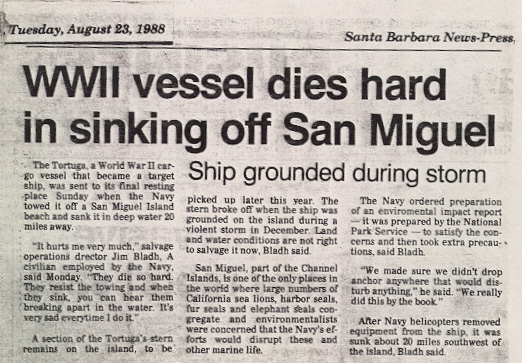

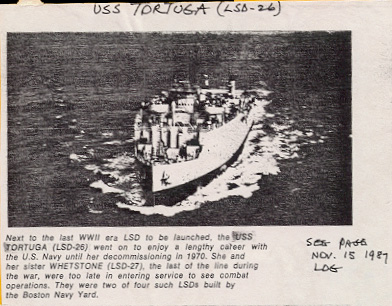
THE LAST LANDING FOR USS TORTUGA
THE LAST LANDING FOR USS TORTUGA
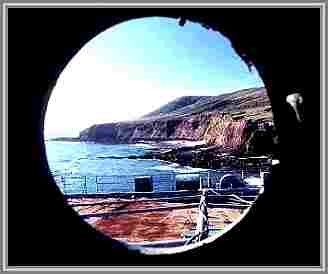
"VIEW OF
SAN MIGUEL ISLAND"
AS VIEWED THRU PORT HOLE OF THE TT.
BY PETER C. HOWORTH (As Reprinted from Sea Magazine)
The mammoth ship looked like a hallucination. How could such a large vessel get stranded so close to shore, I wondered. Only a strong southeaster, coupled with exceptionally high tides, could account for the Landing Ship Dock lying within an easy stone's throw off the beach at San Miguel Island. And an even higher tide would be required to float the hulk clear, I surmised, as I turned my boat for home two days later, the manager of the Channel Islands National Marine Sanctuary Francesca Cava, asked if I would join her and representatives from the Navy and the National Park Service in an inspection of the wreck named USS Tortuga. All three agencies wanted me to take photographs of the ship for their files. We left that same day, crossing the channel in minutes by helicopter and landing on the ship itself. The stern had been literally torn off when the ship was driven ashore. Waves washed in and out of the hull, which lay broadside to the beach. Fortunately, no oil or fuel leaked from the shattered hulk; the vessel had been "sterilized" by the Navy. Even the brasswork had been salvaged.
This venerable ship, built in 1945, was fated to end its days as a floating target. But a powerful "Southeaster" had intervened December 15, 1987, and the ship went 'hard aground,' locked in the grip of a reef so shallow I could have walked to the wreck from shore without getting my feet wet. To seaward, the Omni present swell boomed against the steel flanks of the ship. Like its namesake, USS Tortuga was amphibious. Its huge, U-shaped hull was divided into ballast tanks, which could be flooded, allowing assault craft to motor out through the massive steel door in the stern. The tortured metal "creaked and groaned," and I could feel shudders passing through the vessel as I continued my inspection, "even this cold steel hulk had a soul."
Last summer, the Navy decided to salvage Tortuga. Although the National Park Service manages San Miguel, the Island is owned by the Navy, but the surrounding waters are controlled by various federal and state agencies, so the Navy decided it would be best to remove the ship piece by piece, the "superstructure" was removed and the largest part of the hull was patched. The ballast tanks were pumped dry, and Tortuga finally was pulled off the beach. About 20 miles out to sea, the ship was allowed to sink to its final resting-place. The "stern section" will be allowed to break up, then it will be removed also, leaving no traces of Tortuga's last landing.
Correction on this statement. According to a Diver that has visited the area on San Miguel Island where the Stern was located, parts of the ship still remain & they are easily accessible. CW
Updated
History
The ex-USS TORTUGA (LSD 26) went aground on 15 December 1987 at Cardwell Point,
on the southeast corner of San Miguel Island , off the coast of Southern
California. The ship, carrying personnel nor cargo, was being towed from Port
Hueneme to an area west of St. Nicholas Island where it was to be used for an
operational Tomahawk missile exercise. The grounding occurred during a storm
with winds blowing east-southeast to 50 knots and seas in excess of 20 feet.
Impact of the grounding caused a 100- foot section of
the stern to beak off and fall free from the 355-foot fore section, which had
been holed in numerous place and was impaled on a large boulder. Storm winds
reached at least fifty knots with seas over 20 feet.
Original plans called for sinking the hulk, but because of the
inclement weather this was not possible before it went aground.
The vessel came to rest on a rock and sand shore approximately 1,500 m
west
of Cardwell Point on the south shore of the island, at 120 deg 18'45" W; 34 deg.
01'10" N. It lies within the boundaries of Channel Island National Park,
Channel Islands National Marine Sanctuary, California Channel Islands,
International Biosphere Reserve, and San Miguel Island State Ecological Reserve.
This wild and remote island is particularly renowned as the only
place in the world where six species of pinnipeds share the same rookery
area and haulout locations. The island is the home of several rare and unique
plant and animal species and contains numerous archeological sites.
THE UPDATED HISTORY AND FINAL DAYS OF THE TORTUGA WERE RESEARCHED AND
COMPILED BY CHUCK WESTBROOK FORMER CREWMEMBER 1956-1960.
"GRAY SHIP DOWN"
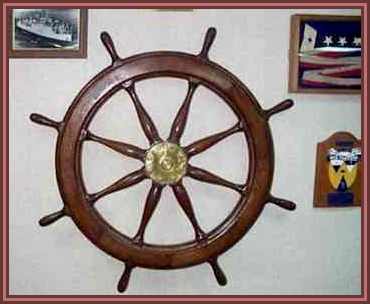
The Helm Wheel came from the USS
Tortuga LSD-26. It was mounted on the
bulkhead of Officers Wardroom on the LSD-46 on her commissioning date.
The in-cased Homeward Bound Pennant and the Plaque below it were donated to the
LSD-46 by CDR. Nelson C, Walton, Commanding Officer of the LSD-26, 1960-62. CDR.
Walton was given the Ship's Crest by his crew members when he left the LSD-26.
The Crest is mounted on a piece of teakwood taken up
from the decks of the "Battleship Wisconsin"
The decommissioned amphibious warship Tortuga, which survived combat action at Korean beachheads and later as "mother" ship for Navy raider boats in Vietnam, lists badly at pier 13 on the 32nd Street Naval Station after taking on water. The 475-foot-long ship recently had been used as a target vessel in exercises off Point Mugu. A Navy spokesman said that either a repair patch failed to hold or a leak developed in the port stern section of the ship, the apparent victim, of a crippling U.S. missile hit. The ship was being used off shore as a target by the Pacific Missile Test Center The ship was pumped dry and patched and again towed to the practice target site. She was fired on again and sustained more damage.

BEGINNING OF SALVAGE REPORT The following is a
condensed version of a 250 page
Official U S Navy Salvage Report.
Crowley Marine Services, Inc. Seattle, Washington.
Crowley Marine Services is the company that was contracted to salvage the Tortuga after she was blown aground on San Miguel Island in 1987.
The Tortuga went aground on 15 December 1987 at 120"18'45"W, 34"01'10"N in the Channel Islands of Southern California. She broke away from her mooring when she encountered violent storms and was blown aground on San Miguel Island. "Wind and Swell Conditions" Winds up to "70 knots" and southerly swells up to six feet characterized conditions at the work site for the Divers & Salvage crews The superstructure was removed and hauled away by barges and dumped in deep water. The remains of the Tortuga were towed out to deep water and the ship was scuttled...
TIME LINE
15 Dec. 1987 Tortuga grounding at San Miguel Island. 2/3 Feb. 1988 Wreck-site salvage survey and environmental assessment. 6/9 June 1988 Mobilization of contractor vessels commences. 26 June 1998 Contract vessels arrive at Port Hueneme. 27 June 1988 Operations at wreck-site commence. 6 July 1988 Fleet Divers arrive at San Miguel Island. 10 July 1988 First barge load of scrap steel departs from, San Miguel Island. 20 July 1988 Fleet Divers depart from work site. 16 August 1988 Tests of patched/plumbed tanks completed. 17 August 1988 Fifth and final barge load of scrap steel departs from San Miguel Island. 18/19 August 1988 Rigging for pull on bow of Tortuga. 19 August 1988 Navajo commences loading of salvage gear. 20 August 1988 Tortuga fore section removed from strand by contract salvage vessel and towed to scuttle site. 20 August 1988 Navajo released and demobilized. 21 August 1988 "Scuttling" of Tortuga fore section at sea. 21/22 August 1988 Contract vessels released from job. 23 August 1988 Mission concludes; all remaining assets and Navy Command van demobilized.
THE GROUNDING
The ex-USS TORTUGA (LSD 26) went aground on 15 December 1987 at Cardwell Point, on the Southeast corner of San Miguel Island off the coast of Southern California. The ship, carrying neither personnel nor cargo, was being towed from Port Hueneme to an area west of St. Nicholas Island where it was to be used for an operational Tomahawk missile exercise.
The grounding occurred during a storm with winds blowing east-southeast to 50 knots and seas in excess of 20 feet. Impact of the grounding caused a 100-foot section of the stern to break off and fall free from the 355-foot fore section, which had been holed in numerous places and was impaled on a large boulder.
Storm winds reached at least fifty knots with of seas over 6 m (20'). Original plans called for sinking the hulk, but because of the inclement weather this was not possible before it went aground. The vessel came to rest on a rock and sand shore approximately 1,500 m west of Cardwell Point on the South shore of the island, at 120 deg. 18'45" W; 34.° deg. 01' 10 " N. It lies within the boundaries of Channel Island National Park, Channel Islands National Marine Sanctuary, California Channel Islands International Biosphere Reserve, and San Miguel Island State Ecological Reserve.
BREAKING THE STRAND
At 1215 on 20 August, wires to the wreck were tightened and TORTUGA soon began to move. By 1330 the bow of TORTUGA had swung out from the beach and was afloat in 20 to 25 feet of water with the stern still aground. At 146 the vessel was completely free of strand and floating. Power for the pull was supplied entirely by the salvage vessel's two after winches. All four forward anchors held in place throughout the pull. Maximum pulling force was estimated to be approximately 180 tons or 160 LT.
TOWING TO SEA AND SCUTTLING
A 2400-HP SPARTAN-class tug was at the scene when TORTUGA was freed from the strand and immediately secured a towing line to the relocated vessel. Aboard TORTUGA were four salvage personnel, who cut the two wires connecting the wreck to the salvage vessel. The towing phase of the operation got underway at once, while the "ARCTIC SALVOR" remained at the site long enough to pull in wires, pick up the four anchors and remove kelp. The at-sea dump site for TORTUGA was approximately 20 miles from San Miguel Island. It had been hoped that the tow and subsequent sinking of the wreck at the dumpsite could be accomplished the same day, 20 August, before dark. Daylight was needed for this final phase of the salvage operation to ensure safe removal of the four people aboard the wreck and to provide adequate light for photographic documentation. However, timing was such that the vessels arrived at the site at 2200, well after dark and simply circled the area at slow speed until daylight, 21 August. The well being of the personnel aboard TORTUGA had been attended to with supplies of food, blankets, lights, life jackets, and survival suits.
On the morning of 21 August, the helicopter arrived at 0814 and began lifting the compressors off the wreckage, completing the equipment liftoff. At 0850a rubber Zodiac was dispatched from the ARCTIC SALVOR to come alongside the wreck. Two person's left TORTUGA at this time and two remained aboard, one positioned at the bow and the other at the stern. At 0910, lines from the tug to the TORTUGA were released, moving rapidly toward the middle of the vessel, the two remaining salvage personnel opened the valves to let the air bleed off from the tanks. As soon as all valves were open the final two sailors boarded the Zodiac and pulled away from the wreck. At 0925 21 August 1988 the ex USS TORTUGA (LSD 26) disappeared below the surface of the Pacific Ocean Forever.
Summary of Events
· 15 Dec 1987 TORTUGA grounding at San Miguel Island
· 2/3 Feb 1988 Wreck-site salvage survey and environmental assessment
· 6/9 Jun 1988 Mobilization of contractor vessels commences
· 26 Jun 1988 Contract vessels arrive at Port Hueneme
· 27 Jun 1988 Operations at wreck site commence
· 6 Jul 1988 Fleet divers arrive at San Miguel Island
· 10 Jul 1988 First bargeload of scrap steel departs from San Miguel Island
· 20 Jul 1988 Fleet divers depart from work site
· 16 Aug 1988 Tests of patched/plumbed tanks completed
· 17 Aug 1988 Fifth and final bargeload of scrap steel departs from San Miguel Island
· 18/19 Aug 1988 Rigging for pull on bow of TORTUGA
· 19 Aug 1988 NAVAJO commences loading of salvage gear
· 20 Aug 1988 TORTUGA fore section removed from strand by contract salvage vessel and towed to scuttle site
· 20 Aug 1988 NAVAJO released and demobilized
· 21 Aug 1988 Scuttling of TORTUGA fore section at sea
· 21/22 Aug 1988 Contract vessels released from job
· 23 Aug 1988 Mission concludes; all remaining assets and Navy Command van demobilized
Tortuga shown with "Superstructure" removed
& minus part of her stern.

This is next to the last photo of the Tortuga that was taken, minutes later
@ 0925 on August 24, 1988, the USS TORTUGA (LSD 26) disappeared
below the surface of the Pacific Ocean Forever
NOTE: The Stern section of the Tortuga remains on San Miguel today and is only accessible when conditions are ideal.
Ian Williams (A Park Ranger for the US Government) has visited the wreck site and has been contacted regarding the removal of small sections of the stern section. Mr. Williams has indicated that is very dangerous to get close to the remains, but he has physically touched part as the stern section as a gesture in honor of all those who served aboard her. He plans to revisit the site when tide, swell and wind conditions are ideal which is not very often.
A very detailed salvage report of the USS Tortuga LSD-26 can be found at the following web site - www.governmentattic.org/2docs/SUPSALV-Report_Ex-Tortuga_1989.pdf - US Navy Salvage Report: EX-TORTUGA (LSD 26) Salvage Report, 14 Sep 1989
This report also mentioned the presence of hazardous materials found aboard
5·1.2 AIRBORNE CONTAMINANTS.
In keeping with standard practice when TORTUGA was built, asbestos was used for lagging of various piping, in ceiling tiles, and in bulkhead insulation. In addition, airborne contaminants included dust, smoke from small fires and burning operations, and paint and metal fumes from burning through World War II-vintage paint containing lead and chromate.
The arrival of Navy divers at the scene focused additional attention early-on in the project
on the need for greater personnel protective measures, particularly as they applied to the
asbestos hazard. Occupational safety specialists from SIMA, San Diego, and from the
salvage contractor's own safety office performed independent surveys and provided
recommendations on how to improve the safety of personnel working on the wreck. As a
result, each person visiting or working aboard TORTUGA was issued a half-mask respirator
with combination filter cartridges designed for protection against asbestos, dust, and metal
fumes. Burners working directly with the asbestos-insulated pipes were fully suited in Tyvek
impervious coveralls, boot covers, hoods, full-face respirators, and gloves, with all joints
taped. A change room was established so that contaminated clothing was not worn off the
vessel. Used coveralls were taken to the ARCTIC SALVOR, soaked overnight in a strong
detergent solution, then washed and reissued to workers. A decontamination area was also
established on the stern of the salvage vessel, providing a place for wash-down as workers
returned to the SALVOR, thus ensuring that no contaminants were tracked into the berthing spaces.
Wherever asbestos was encountered, the vessel was hosed down thoroughly several times
each day. Hard-to-reach places were wet down with buckets of soapy water. The practice
of keeping asbestos wet greatly reduces the release of particles into the air. Small incisions
were made in pipe lagging where cuts were planned and a pressurized water sprayer was
used to soak the asbestos, which was then removed and placed in a plastic bag for disposal.
Open ends of asbestos were well sealed with plastic vis queen. Once cut, sections of
asbestos-wrapped pipe were placed in plastic with the ends and seams taped. All
asbestos-contaminated materials were placed in two designated compartments, one each on
the port and starboard sides. At the conclusion of the burning phase, these compartments
were sealed shut and the plastic-wrapped asbestos inside was allowed to sink with
TORTUGA when it was scuttled.
These procedures evolved gradually and sporadically as the scope of the problem became
more defined. The U.S. Navy Ship Salvage Safety Manual, S0400-AA-SAF-010, dated 22
NOV 88, had not yet been issued to provide guidance. For these reasons, the complexities
of setting up a U.S. Navy diving station became too hard and the tasks of recovering lost
buoyancy was turned over to the contractor.
Constructed at the Charlestown Navy Yard, Boston, MA- used asbestos on the Tortuga (LSD-26).
Ships Repaired by Western MacArthur
Provided below is a listing of the Ship Repair Yard that Western MacArthur repaired using products that contained asbestos.
Bethlehem Steel Shipbuilding - San Francisco, CA Tortuga 1950
Triple A Machine Shop-Pier 64 - San Francisco, CA Tortuga 1960’s at least twice
1964 & 1967
Working conditions 1964-1968
- AAA Machine Yard, San Francisco, CA in early 1967 overhauled the desalinization and turbo generator equipment in both pump rooms. This required removing all the protective asbestos insulation. The insulation was replaced after overhauling was completed. The yard personnel used no respirators or protective clothing. Ship’s engineering personnel were present and routinely exposed to the work.
- AAA Machine Yard, San Francisco, CA in early 1967 replaced the hot water heat exchanger and steam regulator in the Starboard Pump Room. This required removing/installing asbestos insulation. No respirators or protective clothing was used by the “yard birds”. Ship’s engineering personnel were present and routinely exposed to the work.
- The 300 KW DC turbo generators had the rotor/armature turned and cleaned by AAA Machine Yard, San Francisco, CA in early 1967. All the brushes were replaced. This piece of equipment was known for its high dB level during operation. The noise level substantially increased after overhaul. Personal hearing protection equipment was not available for use. The equipment had no noise reduction/suppression material applied.
- AAA Machine Yard, San Francisco, CA in early 1967 replaced the hot water in the ship’s galley. This required removing/installing asbestos insulation. No respirators or protective clothing was used by the “yard birds”. Ship’s engineering personnel were present and routinely exposed to the work.
- The ship’s engineering spaces were noisy environments during operation. Personal hearing protection equipment was not available for use.
- Engineering personnel were expected to maintain their assigned workspaces. This required using various pneumatic de-scaling equipment like the needle gun, chisel, hammer, and electric sander. This was used to remove old lead/chromate paint, scale, and rust on steel surfaces (i.e. bulkheads, hull, etc.) High level of noise and exposure to lead/chromate dust. Only eye protection was used. Sometimes we used cloth to cover our nose and mouths. No personal protective equipment like respirators, protective clothing, or hearing protection was made available to ship engineering personnel.
- Asbestos snow/dust was commonly found in the engineering spaces. Insulation repairs were made routinely performed by engineering personnel without any respirators or protective clothing.
8. Exposure to the herbicide (Agent Orange) by ship personnel has been well documented. (Ship personnel routinely spent liberty (i.e. Vung Tau), went ashore on assignments, and personnel assigned to Task Force 116, River Patrol Squadron 512, PAVC DIV 107, Army 145th Aviation Detachment, and to Navy Task Force "Sea Wolf.") We were ashore (in country) in all of the Four Corps areas of Vietnam. Most of our time was in the” III Corps area, which received the heaviest concentration of spraying of Agent Orange”.
http://www.lewispublishing.com/map1.htm
http://www.usvetdsp.com/agentorange.htm
CREDITS
1. Armand J, DiBella
2. Bill Arnold
3. Bob Kellough
4. Charles R. Westbrook
5. Clay Harrold, CDR, USN
6. Dan Worden
7. Dave Waldron
8. Dick Devoe
9. Dick Knott (author of “Fire From The Sky”)
10. Doc Carl Baker
11. Doug Zak
12. Drue Adams
13. F. M. Schwartz, LTJG, USNR
14. Edward J. Marolda - By Sea, Air, and Land; AN ILLUSTRATED HISTORY OF THE U.S. NAVY AND THE WAR IN SOUTHEAST ASIA
15. Georgia Hammond
16. George Tower
17. Horst K. Joost Lt. Col Inf
18. https://members.tripod.com/turn2/VietnamHistory.html
19. http://www.history.navy.mil/danfs/t7/tortuga.htm
- http://www.historycentral.com/navy/LSD/tortuga.html https://members.tripod.com/turn2/VietnamHistory.html
21. http://www.mrfa.org/LSD-26.htm
23. http://www.nwc.navy.mil/usnhdb/ShipLookup.asp?ShipID=USLSD00026
24. http://www.rivervet.com/others.htm
26. Jack Hammond
27. James Rodger Oneyear
28. Jerry Madrid
29. John Lamb
30. John Prados
31. Mike Horvath
32. Mike Jenkins
33. Mike Wilson
34. Morton (Windy) Winchester
35. Navy Department Awards Web Service web site. (https://awards.navy.mil/)
36. Department of the Navy
Naval Sea Systems Command
NAVSEAFOIA@navy.milUS Navy Salvage Report: EX-TORTUGA (LSD 26) Salvage Report, 14 Sep 1989
www.governmentattic.org/2docs/SUPSALV-Report_Ex-Tortuga_1989.pdf
37. Pat Arnold
38. Peter C. Howorth (As Reprinted from Sea Magazine)
39. Presidential Unit Citation for TF 116.1
40. Ralph “Marty” Martinez
41. Ron Reeves
42. Roy E. Adair
43. Unit awards for TF 116.1
44. United States Naval Operations Vietnam
45. United States Naval Operations, Highlights 1966 – River Patrol Force/Gamewarden – April, June, July, and August 1966
46. US Navy
47. USMC
48. Vincent E. Leopold
49. Wolfgang Hechler
50. Wolf Heinberg
51. Numerous Shipmates who served aboard the USS Tortuga LSD-26
52. I apologize in advanance for omitting and / or not giving credit to any one that has provided the information above.


